Quick filters:
Machine factory 1800s Stock Photos and Images
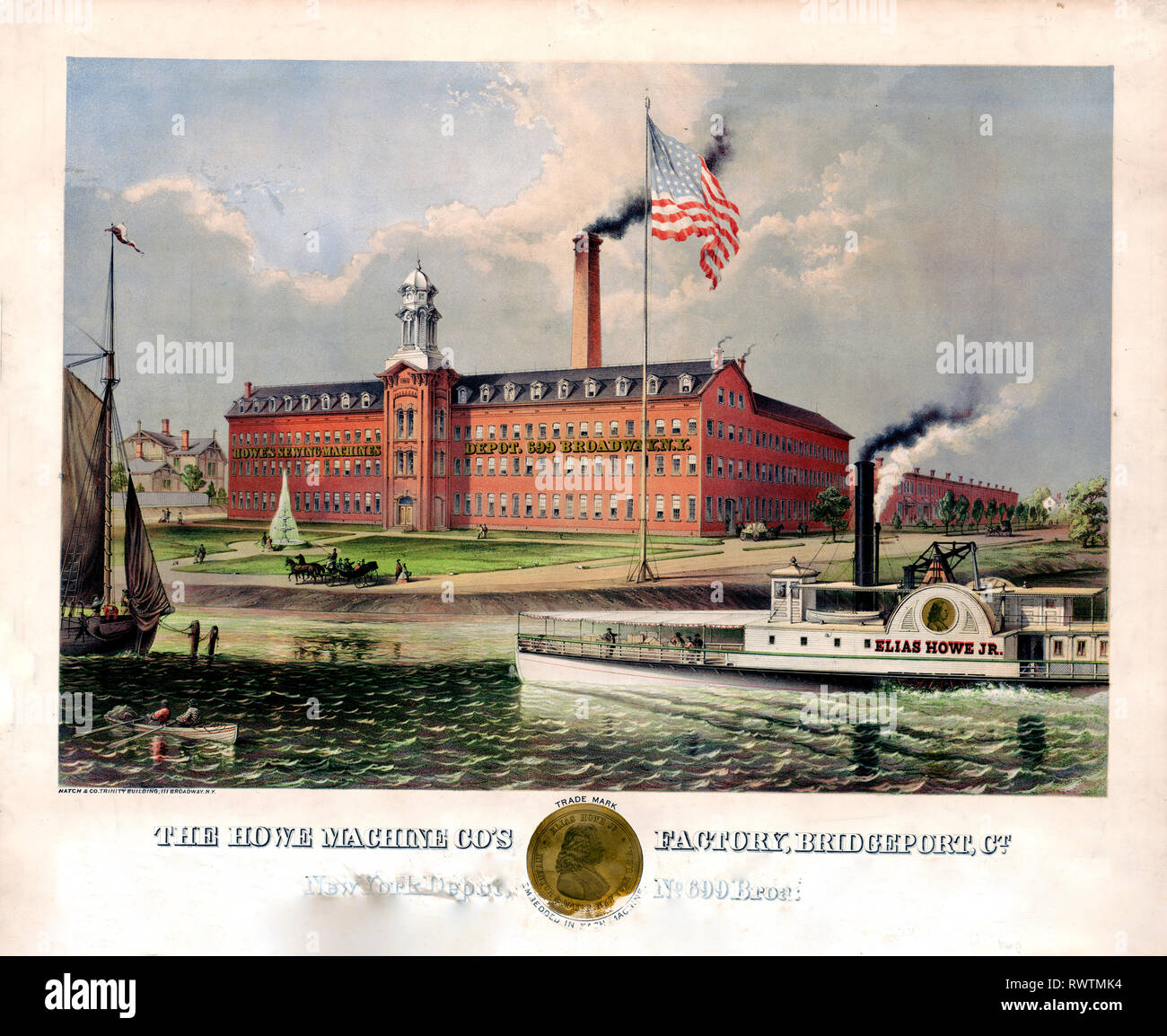 The Howe machine co's factory, Bridgeport, Co. Stock Photohttps://www.alamy.com/image-license-details/?v=1https://www.alamy.com/the-howe-machine-cos-factory-bridgeport-co-image239644248.html
The Howe machine co's factory, Bridgeport, Co. Stock Photohttps://www.alamy.com/image-license-details/?v=1https://www.alamy.com/the-howe-machine-cos-factory-bridgeport-co-image239644248.htmlRMRWTMK4–The Howe machine co's factory, Bridgeport, Co.
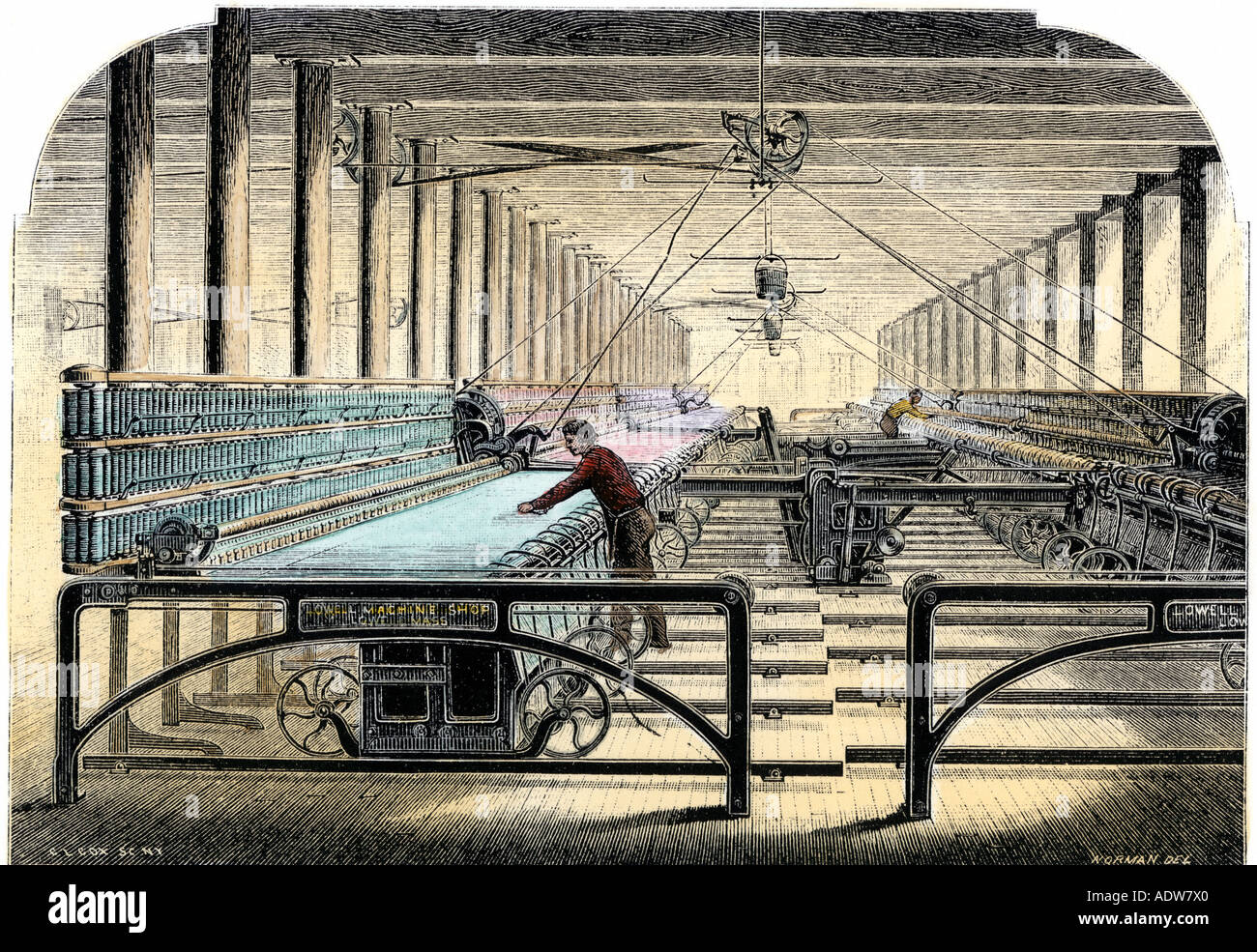 Mill worker tending mule-spinners an industrial textile machine 1800s. Hand-colored woodcut Stock Photohttps://www.alamy.com/image-license-details/?v=1https://www.alamy.com/mill-worker-tending-mule-spinners-an-industrial-textile-machine-1800s-image7712479.html
Mill worker tending mule-spinners an industrial textile machine 1800s. Hand-colored woodcut Stock Photohttps://www.alamy.com/image-license-details/?v=1https://www.alamy.com/mill-worker-tending-mule-spinners-an-industrial-textile-machine-1800s-image7712479.htmlRMADW7X0–Mill worker tending mule-spinners an industrial textile machine 1800s. Hand-colored woodcut
 An old engraving showing dash wheels used in the washing of fabric and clothing in a factory or mill the early 1800s. It is from a Victorian mechanical engineering book of the 1880s. These large wheels were large hollow and divided into four compartments, into which bundles of cloth and water were placed. Dirt and impurities were washed out of the cloth as the rapidly revolving drums threw their load backwards and forwards. From the 1820s dash wheels were gradually replaced by the industrial washing machine. Stock Photohttps://www.alamy.com/image-license-details/?v=1https://www.alamy.com/an-old-engraving-showing-dash-wheels-used-in-the-washing-of-fabric-and-clothing-in-a-factory-or-mill-the-early-1800s-it-is-from-a-victorian-mechanical-engineering-book-of-the-1880s-these-large-wheels-were-large-hollow-and-divided-into-four-compartments-into-which-bundles-of-cloth-and-water-were-placed-dirt-and-impurities-were-washed-out-of-the-cloth-as-the-rapidly-revolving-drums-threw-their-load-backwards-and-forwards-from-the-1820s-dash-wheels-were-gradually-replaced-by-the-industrial-washing-machine-image384283124.html
An old engraving showing dash wheels used in the washing of fabric and clothing in a factory or mill the early 1800s. It is from a Victorian mechanical engineering book of the 1880s. These large wheels were large hollow and divided into four compartments, into which bundles of cloth and water were placed. Dirt and impurities were washed out of the cloth as the rapidly revolving drums threw their load backwards and forwards. From the 1820s dash wheels were gradually replaced by the industrial washing machine. Stock Photohttps://www.alamy.com/image-license-details/?v=1https://www.alamy.com/an-old-engraving-showing-dash-wheels-used-in-the-washing-of-fabric-and-clothing-in-a-factory-or-mill-the-early-1800s-it-is-from-a-victorian-mechanical-engineering-book-of-the-1880s-these-large-wheels-were-large-hollow-and-divided-into-four-compartments-into-which-bundles-of-cloth-and-water-were-placed-dirt-and-impurities-were-washed-out-of-the-cloth-as-the-rapidly-revolving-drums-threw-their-load-backwards-and-forwards-from-the-1820s-dash-wheels-were-gradually-replaced-by-the-industrial-washing-machine-image384283124.htmlRM2D95H18–An old engraving showing dash wheels used in the washing of fabric and clothing in a factory or mill the early 1800s. It is from a Victorian mechanical engineering book of the 1880s. These large wheels were large hollow and divided into four compartments, into which bundles of cloth and water were placed. Dirt and impurities were washed out of the cloth as the rapidly revolving drums threw their load backwards and forwards. From the 1820s dash wheels were gradually replaced by the industrial washing machine.
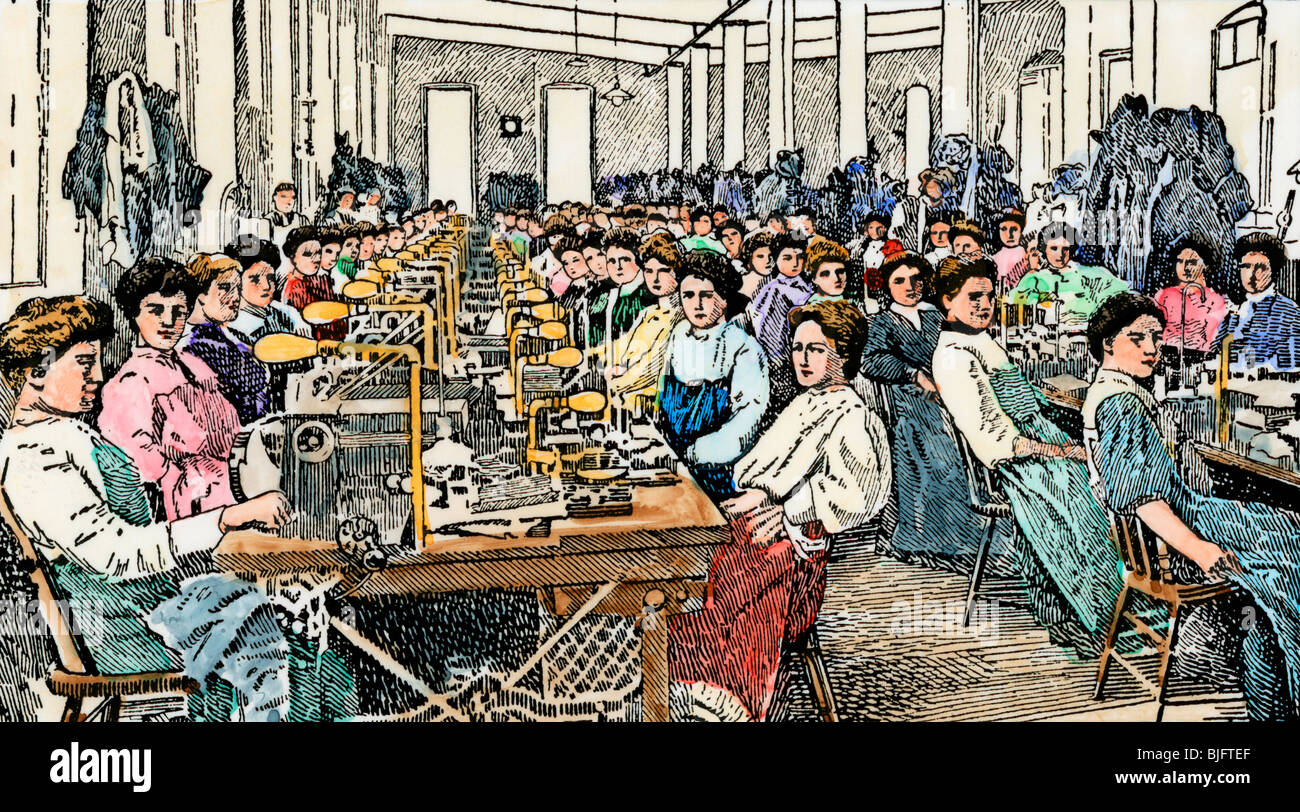 Workers at their machines in a knitting mill, 1800s. Hand-colored woodcut Stock Photohttps://www.alamy.com/image-license-details/?v=1https://www.alamy.com/stock-photo-workers-at-their-machines-in-a-knitting-mill-1800s-hand-colored-woodcut-28622679.html
Workers at their machines in a knitting mill, 1800s. Hand-colored woodcut Stock Photohttps://www.alamy.com/image-license-details/?v=1https://www.alamy.com/stock-photo-workers-at-their-machines-in-a-knitting-mill-1800s-hand-colored-woodcut-28622679.htmlRMBJFTEF–Workers at their machines in a knitting mill, 1800s. Hand-colored woodcut
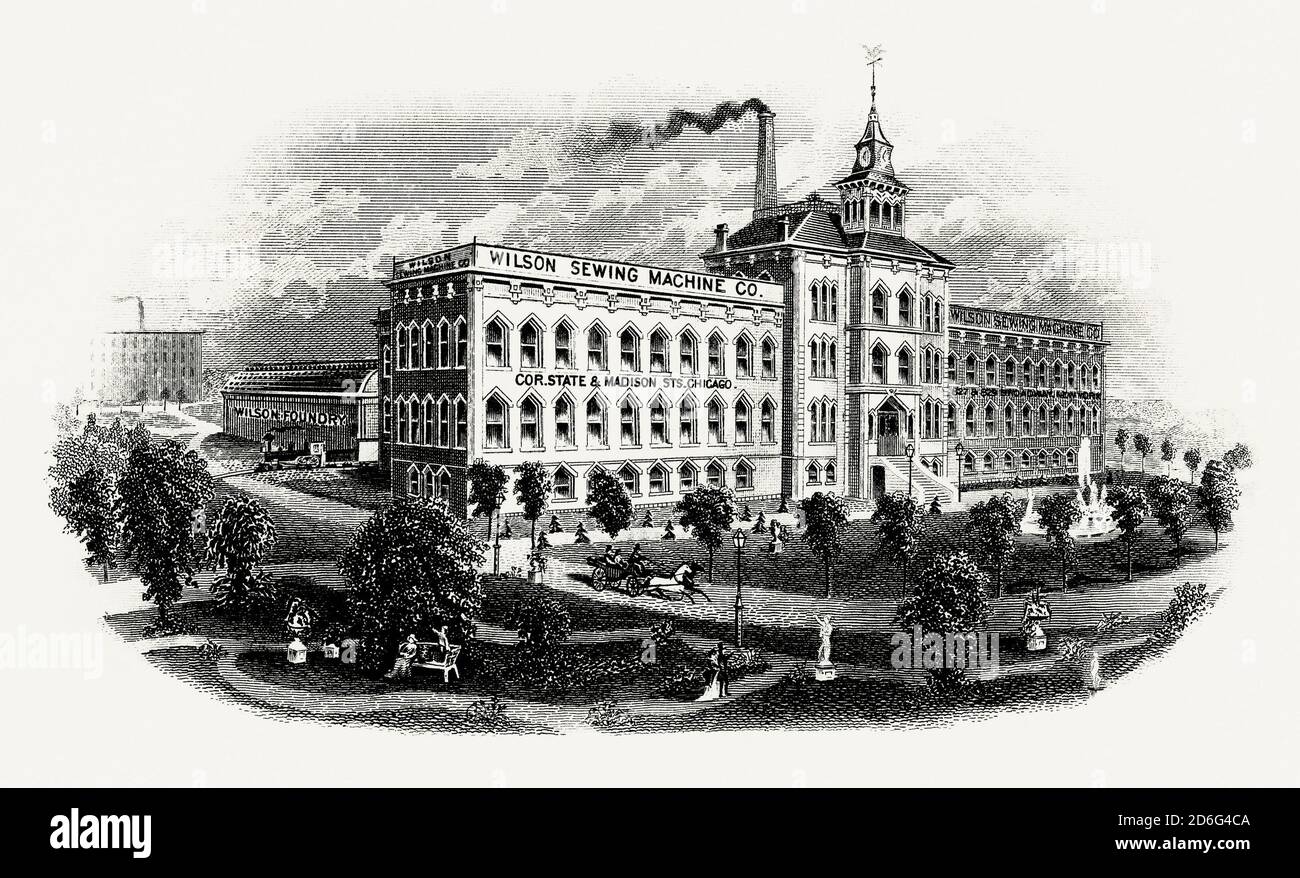 An old engraving of The W G Wilson Company sewing machine factory, Chicago, Illinois, USA. It is from a Victorian mechanical engineering book of the 1880s. The company was originally based in Cleveland but moved their operations to Chicago in 1875. Machines could be delivered, free of charge, at any railroad depot in the USA. At the Centennial Exposition of 1876 Wilson received the Grand Prize Medal and Diploma. Stock Photohttps://www.alamy.com/image-license-details/?v=1https://www.alamy.com/an-old-engraving-of-the-w-g-wilson-company-sewing-machine-factory-chicago-illinois-usa-it-is-from-a-victorian-mechanical-engineering-book-of-the-1880s-the-company-was-originally-based-in-cleveland-but-moved-their-operations-to-chicago-in-1875-machines-could-be-delivered-free-of-charge-at-any-railroad-depot-in-the-usa-at-the-centennial-exposition-of-1876-wilson-received-the-grand-prize-medal-and-diploma-image382670746.html
An old engraving of The W G Wilson Company sewing machine factory, Chicago, Illinois, USA. It is from a Victorian mechanical engineering book of the 1880s. The company was originally based in Cleveland but moved their operations to Chicago in 1875. Machines could be delivered, free of charge, at any railroad depot in the USA. At the Centennial Exposition of 1876 Wilson received the Grand Prize Medal and Diploma. Stock Photohttps://www.alamy.com/image-license-details/?v=1https://www.alamy.com/an-old-engraving-of-the-w-g-wilson-company-sewing-machine-factory-chicago-illinois-usa-it-is-from-a-victorian-mechanical-engineering-book-of-the-1880s-the-company-was-originally-based-in-cleveland-but-moved-their-operations-to-chicago-in-1875-machines-could-be-delivered-free-of-charge-at-any-railroad-depot-in-the-usa-at-the-centennial-exposition-of-1876-wilson-received-the-grand-prize-medal-and-diploma-image382670746.htmlRM2D6G4CA–An old engraving of The W G Wilson Company sewing machine factory, Chicago, Illinois, USA. It is from a Victorian mechanical engineering book of the 1880s. The company was originally based in Cleveland but moved their operations to Chicago in 1875. Machines could be delivered, free of charge, at any railroad depot in the USA. At the Centennial Exposition of 1876 Wilson received the Grand Prize Medal and Diploma.
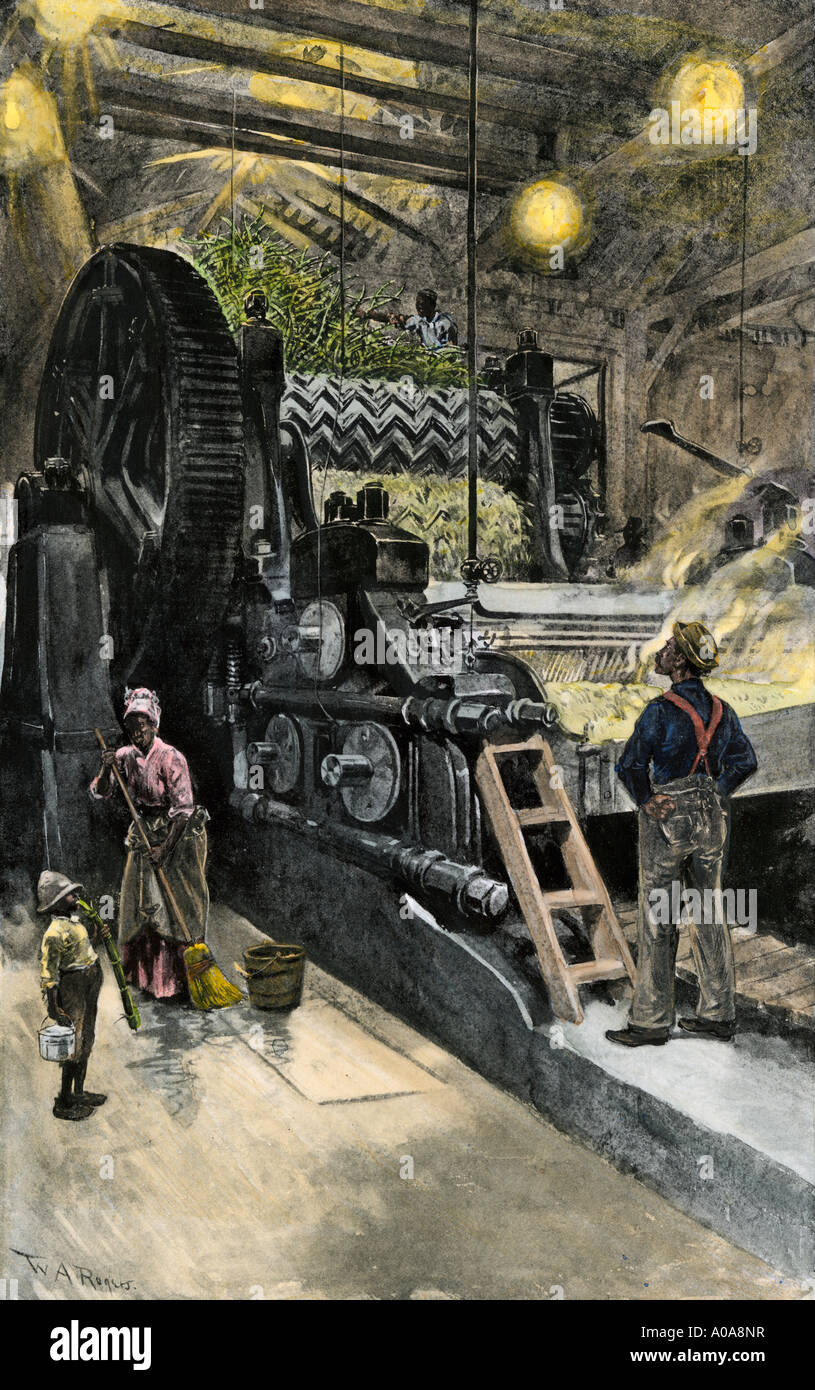 African American workers operating a cane crushing machine in a sugar house at Bayou Teche Louisiana 1900. Hand-colored halftone of an illustration Stock Photohttps://www.alamy.com/image-license-details/?v=1https://www.alamy.com/african-american-workers-operating-a-cane-crushing-machine-in-a-sugar-image9931522.html
African American workers operating a cane crushing machine in a sugar house at Bayou Teche Louisiana 1900. Hand-colored halftone of an illustration Stock Photohttps://www.alamy.com/image-license-details/?v=1https://www.alamy.com/african-american-workers-operating-a-cane-crushing-machine-in-a-sugar-image9931522.htmlRMA0A8NR–African American workers operating a cane crushing machine in a sugar house at Bayou Teche Louisiana 1900. Hand-colored halftone of an illustration
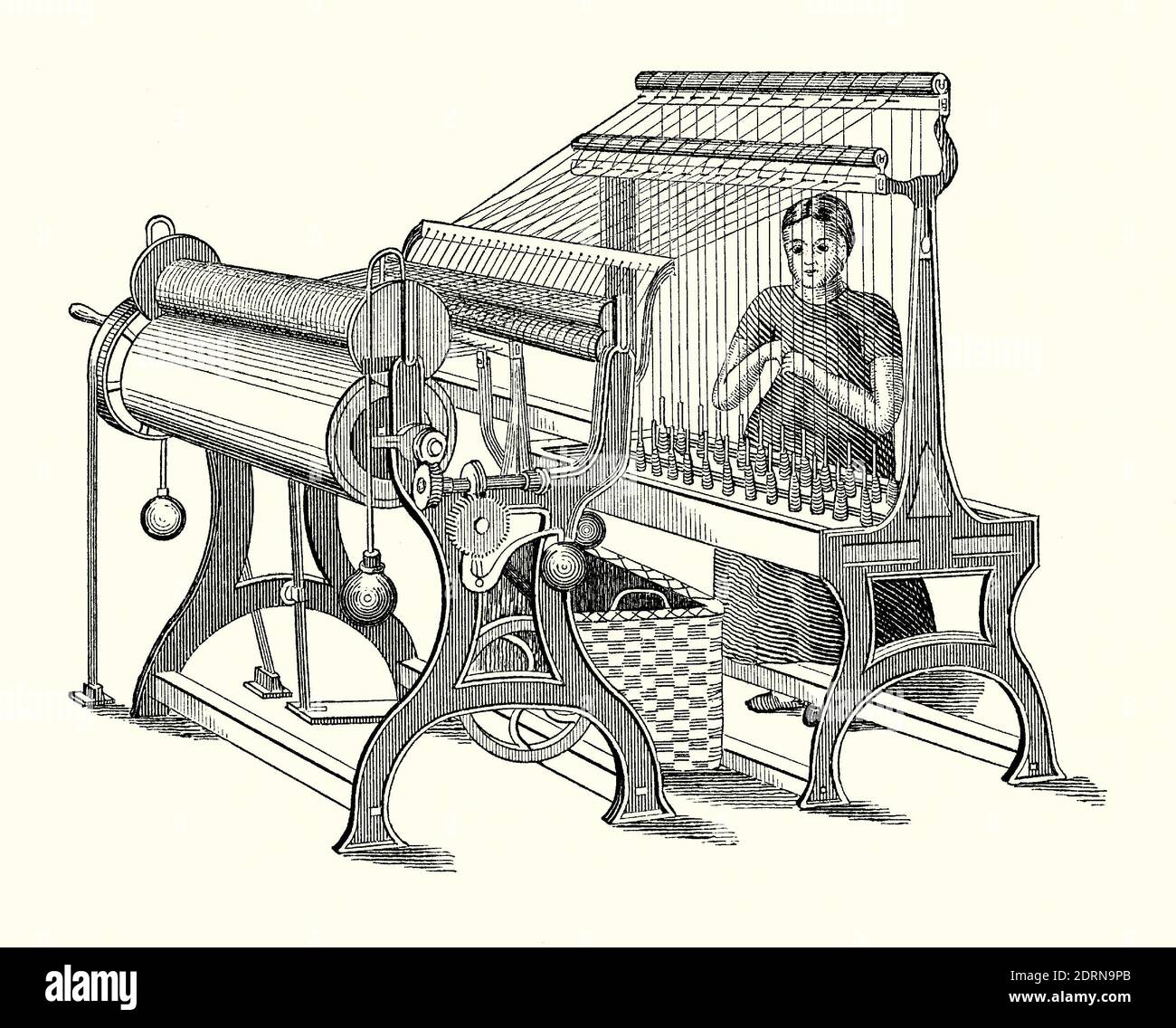 An old engraving of a woman working at a yarn spooler machine in a textile mill the 1800s. It is from a Victorian mechanical engineering book of the 1880s. This powered machine is designed to speedily wrap the fibre onto spools, bobbins or shuttles. Cotton, linen or wool yarn is held on rollers (right) and fed down through the ‘eyes’ to the spindles which are rotated from gears below them. Stock Photohttps://www.alamy.com/image-license-details/?v=1https://www.alamy.com/an-old-engraving-of-a-woman-working-at-a-yarn-spooler-machine-in-a-textile-mill-the-1800s-it-is-from-a-victorian-mechanical-engineering-book-of-the-1880s-this-powered-machine-is-designed-to-speedily-wrap-the-fibre-onto-spools-bobbins-or-shuttles-cotton-linen-or-wool-yarn-is-held-on-rollers-right-and-fed-down-through-the-eyes-to-the-spindles-which-are-rotated-from-gears-below-them-image393233859.html
An old engraving of a woman working at a yarn spooler machine in a textile mill the 1800s. It is from a Victorian mechanical engineering book of the 1880s. This powered machine is designed to speedily wrap the fibre onto spools, bobbins or shuttles. Cotton, linen or wool yarn is held on rollers (right) and fed down through the ‘eyes’ to the spindles which are rotated from gears below them. Stock Photohttps://www.alamy.com/image-license-details/?v=1https://www.alamy.com/an-old-engraving-of-a-woman-working-at-a-yarn-spooler-machine-in-a-textile-mill-the-1800s-it-is-from-a-victorian-mechanical-engineering-book-of-the-1880s-this-powered-machine-is-designed-to-speedily-wrap-the-fibre-onto-spools-bobbins-or-shuttles-cotton-linen-or-wool-yarn-is-held-on-rollers-right-and-fed-down-through-the-eyes-to-the-spindles-which-are-rotated-from-gears-below-them-image393233859.htmlRM2DRN9PB–An old engraving of a woman working at a yarn spooler machine in a textile mill the 1800s. It is from a Victorian mechanical engineering book of the 1880s. This powered machine is designed to speedily wrap the fibre onto spools, bobbins or shuttles. Cotton, linen or wool yarn is held on rollers (right) and fed down through the ‘eyes’ to the spindles which are rotated from gears below them.
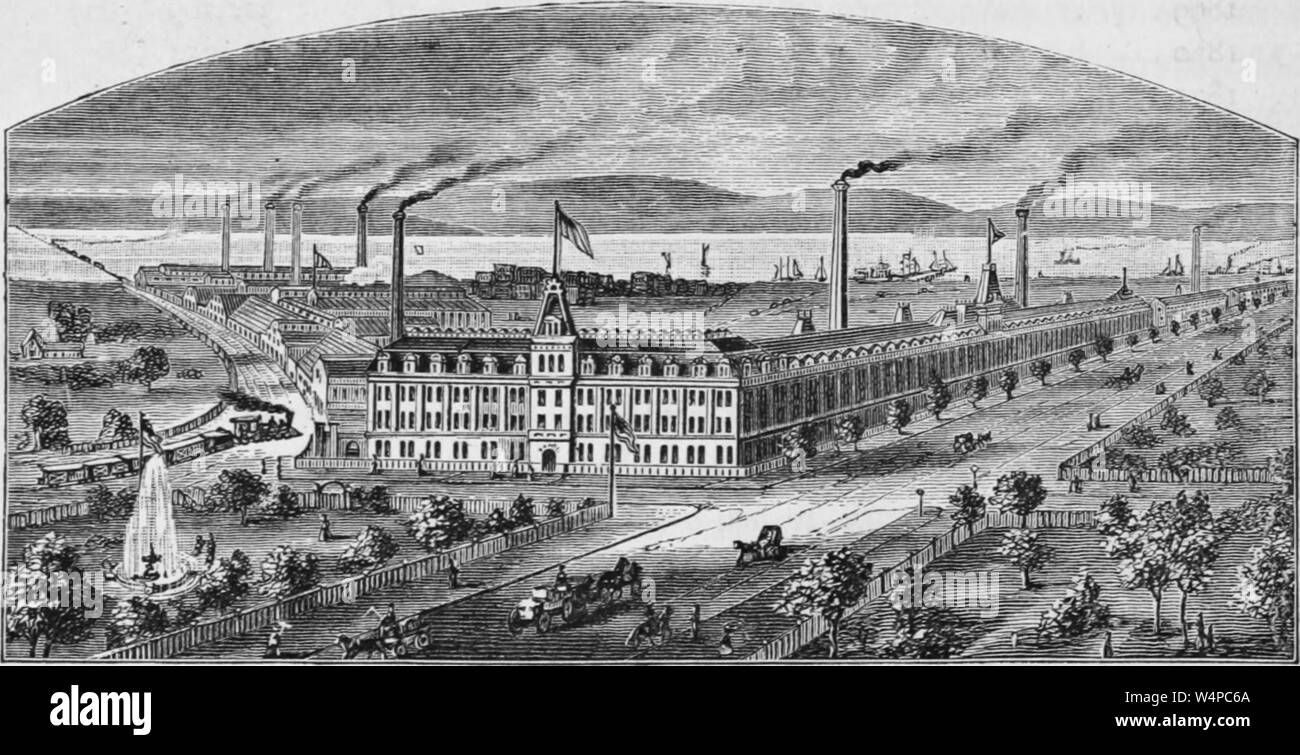 Engraving of the Singer Sewing Machine Company factory, Elizabethport, New Jersey, from the book 'Industrial history of the United States' by Albert Sidney Bolles, 1878. Courtesy Internet Archive. () Stock Photohttps://www.alamy.com/image-license-details/?v=1https://www.alamy.com/engraving-of-the-singer-sewing-machine-company-factory-elizabethport-new-jersey-from-the-book-industrial-history-of-the-united-states-by-albert-sidney-bolles-1878-courtesy-internet-archive-image261106674.html
Engraving of the Singer Sewing Machine Company factory, Elizabethport, New Jersey, from the book 'Industrial history of the United States' by Albert Sidney Bolles, 1878. Courtesy Internet Archive. () Stock Photohttps://www.alamy.com/image-license-details/?v=1https://www.alamy.com/engraving-of-the-singer-sewing-machine-company-factory-elizabethport-new-jersey-from-the-book-industrial-history-of-the-united-states-by-albert-sidney-bolles-1878-courtesy-internet-archive-image261106674.htmlRMW4PC6A–Engraving of the Singer Sewing Machine Company factory, Elizabethport, New Jersey, from the book 'Industrial history of the United States' by Albert Sidney Bolles, 1878. Courtesy Internet Archive. ()
 An old engraving of the Singer sewing machine factory, Elizabeth, New Jersey, USA. It is from a Victorian mechanical engineering book of the 1880s. The Singer Corporation is an American manufacturer of consumer sewing machines, first established as I M Singer & Co in 1851 by Isaac M Singer and New York lawyer Edward C Clark. It was renamed Singer Manufacturing Company in 1865, then the Singer Company in 1963. Its first large factory was built in 1863 in New Jersey but it is now based in La Vergne, Tennessee, near Nashville. Stock Photohttps://www.alamy.com/image-license-details/?v=1https://www.alamy.com/an-old-engraving-of-the-singer-sewing-machine-factory-elizabeth-new-jersey-usa-it-is-from-a-victorian-mechanical-engineering-book-of-the-1880s-the-singer-corporation-is-an-american-manufacturer-of-consumer-sewing-machines-first-established-as-i-m-singer-co-in-1851-by-isaac-m-singer-and-new-york-lawyer-edward-c-clark-it-was-renamed-singer-manufacturing-company-in-1865-then-the-singer-company-in-1963-its-first-large-factory-was-built-in-1863-in-new-jersey-but-it-is-now-based-in-la-vergne-tennessee-near-nashville-image382670712.html
An old engraving of the Singer sewing machine factory, Elizabeth, New Jersey, USA. It is from a Victorian mechanical engineering book of the 1880s. The Singer Corporation is an American manufacturer of consumer sewing machines, first established as I M Singer & Co in 1851 by Isaac M Singer and New York lawyer Edward C Clark. It was renamed Singer Manufacturing Company in 1865, then the Singer Company in 1963. Its first large factory was built in 1863 in New Jersey but it is now based in La Vergne, Tennessee, near Nashville. Stock Photohttps://www.alamy.com/image-license-details/?v=1https://www.alamy.com/an-old-engraving-of-the-singer-sewing-machine-factory-elizabeth-new-jersey-usa-it-is-from-a-victorian-mechanical-engineering-book-of-the-1880s-the-singer-corporation-is-an-american-manufacturer-of-consumer-sewing-machines-first-established-as-i-m-singer-co-in-1851-by-isaac-m-singer-and-new-york-lawyer-edward-c-clark-it-was-renamed-singer-manufacturing-company-in-1865-then-the-singer-company-in-1963-its-first-large-factory-was-built-in-1863-in-new-jersey-but-it-is-now-based-in-la-vergne-tennessee-near-nashville-image382670712.htmlRM2D6G4B4–An old engraving of the Singer sewing machine factory, Elizabeth, New Jersey, USA. It is from a Victorian mechanical engineering book of the 1880s. The Singer Corporation is an American manufacturer of consumer sewing machines, first established as I M Singer & Co in 1851 by Isaac M Singer and New York lawyer Edward C Clark. It was renamed Singer Manufacturing Company in 1865, then the Singer Company in 1963. Its first large factory was built in 1863 in New Jersey but it is now based in La Vergne, Tennessee, near Nashville.
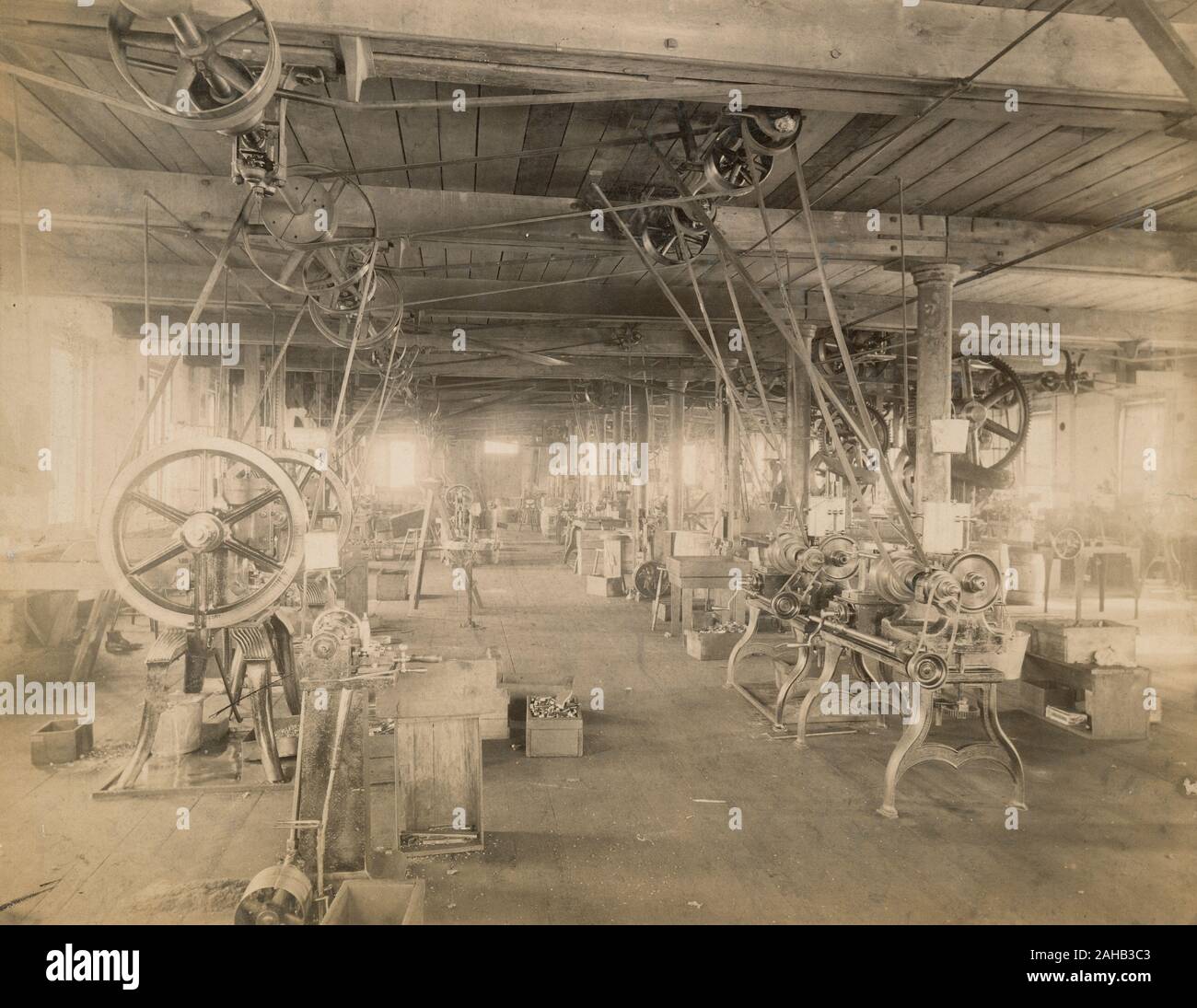 Antique c1890 photograph, machine room at the Crandall, Stone & Co. carriage hardware factory in Binghamton, New York. SOURCE: ORIGINAL PHOTOGRAPH Stock Photohttps://www.alamy.com/image-license-details/?v=1https://www.alamy.com/antique-c1890-photograph-machine-room-at-the-crandall-stone-co-carriage-hardware-factory-in-binghamton-new-york-source-original-photograph-image337690307.html
Antique c1890 photograph, machine room at the Crandall, Stone & Co. carriage hardware factory in Binghamton, New York. SOURCE: ORIGINAL PHOTOGRAPH Stock Photohttps://www.alamy.com/image-license-details/?v=1https://www.alamy.com/antique-c1890-photograph-machine-room-at-the-crandall-stone-co-carriage-hardware-factory-in-binghamton-new-york-source-original-photograph-image337690307.htmlRM2AHB3C3–Antique c1890 photograph, machine room at the Crandall, Stone & Co. carriage hardware factory in Binghamton, New York. SOURCE: ORIGINAL PHOTOGRAPH
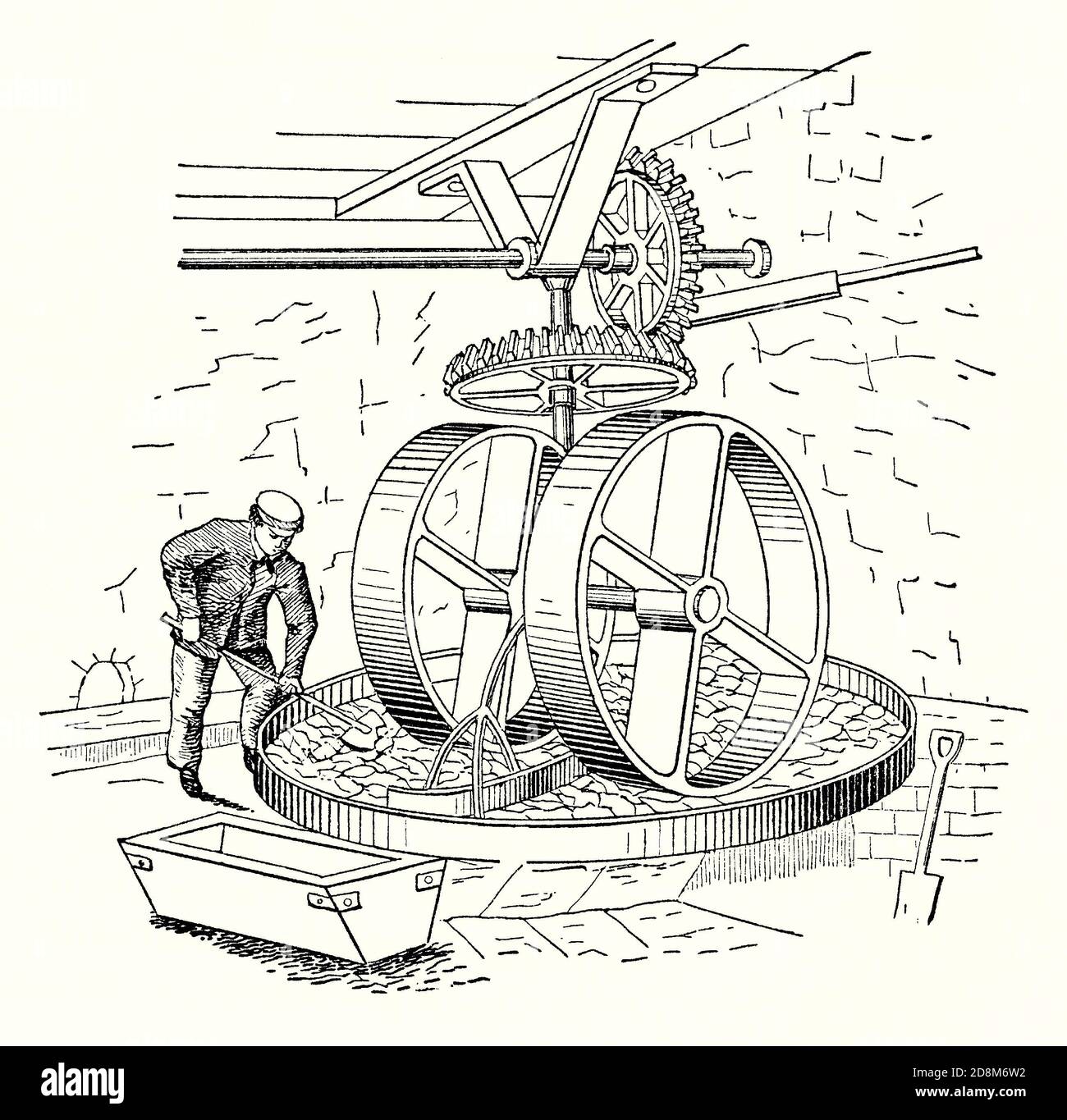 An old engraving of a clay mill in the 1800s. It is from a Victorian mechanical engineering book of the 1880s. The illustration shows the clay being worked by a belt-driven system with cogs and gears. A clay mill, pugmill or pug mill is the machinery in which clay (or other materials) are mixed into a plastic state. Industrial applications include mixing for pottery, bricks and cement. Some mills were driven by horses. Stock Photohttps://www.alamy.com/image-license-details/?v=1https://www.alamy.com/an-old-engraving-of-a-clay-mill-in-the-1800s-it-is-from-a-victorian-mechanical-engineering-book-of-the-1880s-the-illustration-shows-the-clay-being-worked-by-a-belt-driven-system-with-cogs-and-gears-a-clay-mill-pugmill-or-pug-mill-is-the-machinery-in-which-clay-or-other-materials-are-mixed-into-a-plastic-state-industrial-applications-include-mixing-for-pottery-bricks-and-cement-some-mills-were-driven-by-horses-image383989790.html
An old engraving of a clay mill in the 1800s. It is from a Victorian mechanical engineering book of the 1880s. The illustration shows the clay being worked by a belt-driven system with cogs and gears. A clay mill, pugmill or pug mill is the machinery in which clay (or other materials) are mixed into a plastic state. Industrial applications include mixing for pottery, bricks and cement. Some mills were driven by horses. Stock Photohttps://www.alamy.com/image-license-details/?v=1https://www.alamy.com/an-old-engraving-of-a-clay-mill-in-the-1800s-it-is-from-a-victorian-mechanical-engineering-book-of-the-1880s-the-illustration-shows-the-clay-being-worked-by-a-belt-driven-system-with-cogs-and-gears-a-clay-mill-pugmill-or-pug-mill-is-the-machinery-in-which-clay-or-other-materials-are-mixed-into-a-plastic-state-industrial-applications-include-mixing-for-pottery-bricks-and-cement-some-mills-were-driven-by-horses-image383989790.htmlRM2D8M6W2–An old engraving of a clay mill in the 1800s. It is from a Victorian mechanical engineering book of the 1880s. The illustration shows the clay being worked by a belt-driven system with cogs and gears. A clay mill, pugmill or pug mill is the machinery in which clay (or other materials) are mixed into a plastic state. Industrial applications include mixing for pottery, bricks and cement. Some mills were driven by horses.
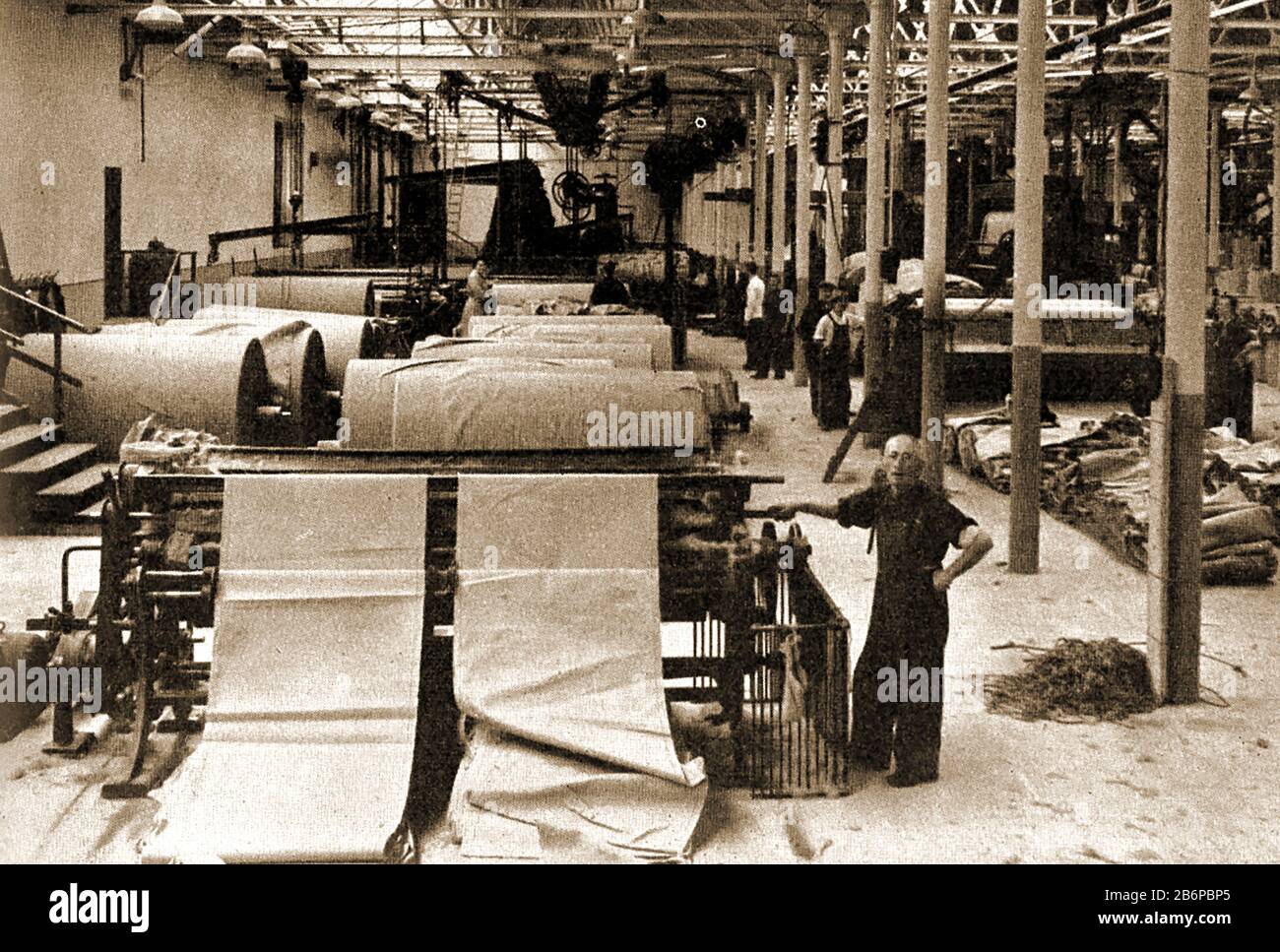 An early photograph showing a worker at a Jute factory in Dundee, Scotland putting sacking cloth through a cropping machine. Throughout the late 1800s, more than half of Dundee’s workforce worked in the textile sector, (mainly jute). Jute was cheap and hard wearing & was ideal for sacks, bags, sandbags, packing materials & even cart covers (like those used by wild west pioneers). During most of the time, a majority of females worked in the industry earning a wage men couldn't equal, Consequently men stayed at home as 'house-husbands' and were known locally as kettle bilers (kettle boilers). Stock Photohttps://www.alamy.com/image-license-details/?v=1https://www.alamy.com/an-early-photograph-showing-a-worker-at-a-jute-factory-in-dundee-scotland-putting-sacking-cloth-through-a-cropping-machine-throughout-the-late-1800s-more-than-half-of-dundees-workforce-worked-in-the-textile-sector-mainly-jute-jute-was-cheap-and-hard-wearing-was-ideal-for-sacks-bags-sandbags-packing-materials-even-cart-covers-like-those-used-by-wild-west-pioneers-during-most-of-the-time-a-majority-of-females-worked-in-the-industry-earning-a-wage-men-couldnt-equal-consequently-men-stayed-at-home-as-house-husbands-and-were-known-locally-as-kettle-bilers-kettle-boilers-image348387485.html
An early photograph showing a worker at a Jute factory in Dundee, Scotland putting sacking cloth through a cropping machine. Throughout the late 1800s, more than half of Dundee’s workforce worked in the textile sector, (mainly jute). Jute was cheap and hard wearing & was ideal for sacks, bags, sandbags, packing materials & even cart covers (like those used by wild west pioneers). During most of the time, a majority of females worked in the industry earning a wage men couldn't equal, Consequently men stayed at home as 'house-husbands' and were known locally as kettle bilers (kettle boilers). Stock Photohttps://www.alamy.com/image-license-details/?v=1https://www.alamy.com/an-early-photograph-showing-a-worker-at-a-jute-factory-in-dundee-scotland-putting-sacking-cloth-through-a-cropping-machine-throughout-the-late-1800s-more-than-half-of-dundees-workforce-worked-in-the-textile-sector-mainly-jute-jute-was-cheap-and-hard-wearing-was-ideal-for-sacks-bags-sandbags-packing-materials-even-cart-covers-like-those-used-by-wild-west-pioneers-during-most-of-the-time-a-majority-of-females-worked-in-the-industry-earning-a-wage-men-couldnt-equal-consequently-men-stayed-at-home-as-house-husbands-and-were-known-locally-as-kettle-bilers-kettle-boilers-image348387485.htmlRM2B6PBP5–An early photograph showing a worker at a Jute factory in Dundee, Scotland putting sacking cloth through a cropping machine. Throughout the late 1800s, more than half of Dundee’s workforce worked in the textile sector, (mainly jute). Jute was cheap and hard wearing & was ideal for sacks, bags, sandbags, packing materials & even cart covers (like those used by wild west pioneers). During most of the time, a majority of females worked in the industry earning a wage men couldn't equal, Consequently men stayed at home as 'house-husbands' and were known locally as kettle bilers (kettle boilers).
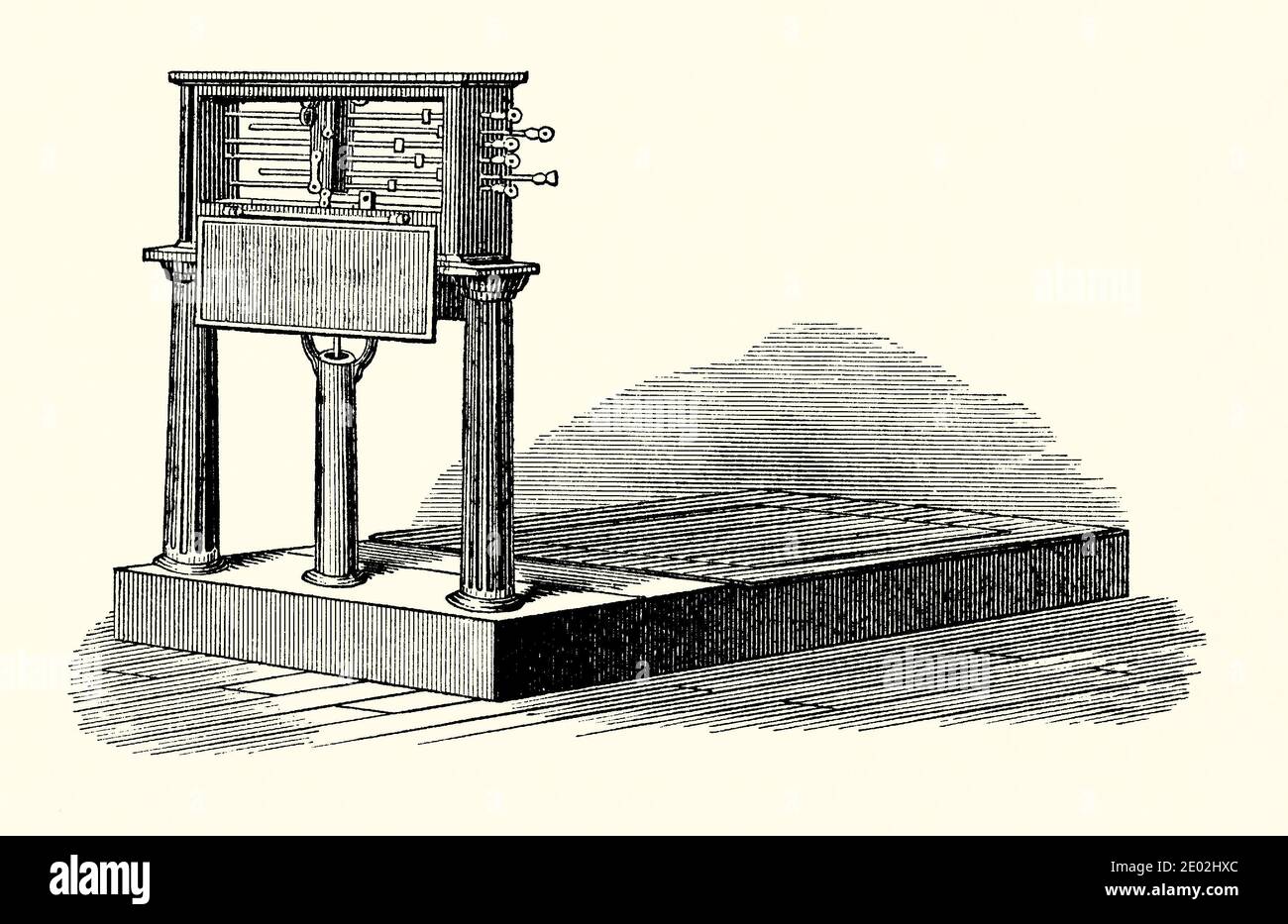 An old engraving of platform scales manufactured by E and T Fairbanks and Company in the 1800s. It is from a Victorian mechanical engineering book of the 1880s. These scales were useful to weigh loads in places like factories and warehouses. American Thaddeus Fairbanks (1796 –1886) was an American inventor. In 1824 he built an iron foundry in St Johnsbury, Vermont, USA with his brother Erastus. Fairbanks’s most famous invention, ‘The Fairbanks Scales’, a platform scale, capable of weighing of very large loads accurately. Fairbanks Scales continue to be made in St Johnsbury. Stock Photohttps://www.alamy.com/image-license-details/?v=1https://www.alamy.com/an-old-engraving-of-platform-scales-manufactured-by-e-and-t-fairbanks-and-company-in-the-1800s-it-is-from-a-victorian-mechanical-engineering-book-of-the-1880s-these-scales-were-useful-to-weigh-loads-in-places-like-factories-and-warehouses-american-thaddeus-fairbanks-1796-1886-was-an-american-inventor-in-1824-he-built-an-iron-foundry-in-st-johnsbury-vermont-usa-with-his-brother-erastus-fairbankss-most-famous-invention-the-fairbanks-scales-a-platform-scale-capable-of-weighing-of-very-large-loads-accurately-fairbanks-scales-continue-to-be-made-in-st-johnsbury-image395896436.html
An old engraving of platform scales manufactured by E and T Fairbanks and Company in the 1800s. It is from a Victorian mechanical engineering book of the 1880s. These scales were useful to weigh loads in places like factories and warehouses. American Thaddeus Fairbanks (1796 –1886) was an American inventor. In 1824 he built an iron foundry in St Johnsbury, Vermont, USA with his brother Erastus. Fairbanks’s most famous invention, ‘The Fairbanks Scales’, a platform scale, capable of weighing of very large loads accurately. Fairbanks Scales continue to be made in St Johnsbury. Stock Photohttps://www.alamy.com/image-license-details/?v=1https://www.alamy.com/an-old-engraving-of-platform-scales-manufactured-by-e-and-t-fairbanks-and-company-in-the-1800s-it-is-from-a-victorian-mechanical-engineering-book-of-the-1880s-these-scales-were-useful-to-weigh-loads-in-places-like-factories-and-warehouses-american-thaddeus-fairbanks-1796-1886-was-an-american-inventor-in-1824-he-built-an-iron-foundry-in-st-johnsbury-vermont-usa-with-his-brother-erastus-fairbankss-most-famous-invention-the-fairbanks-scales-a-platform-scale-capable-of-weighing-of-very-large-loads-accurately-fairbanks-scales-continue-to-be-made-in-st-johnsbury-image395896436.htmlRM2E02HXC–An old engraving of platform scales manufactured by E and T Fairbanks and Company in the 1800s. It is from a Victorian mechanical engineering book of the 1880s. These scales were useful to weigh loads in places like factories and warehouses. American Thaddeus Fairbanks (1796 –1886) was an American inventor. In 1824 he built an iron foundry in St Johnsbury, Vermont, USA with his brother Erastus. Fairbanks’s most famous invention, ‘The Fairbanks Scales’, a platform scale, capable of weighing of very large loads accurately. Fairbanks Scales continue to be made in St Johnsbury.
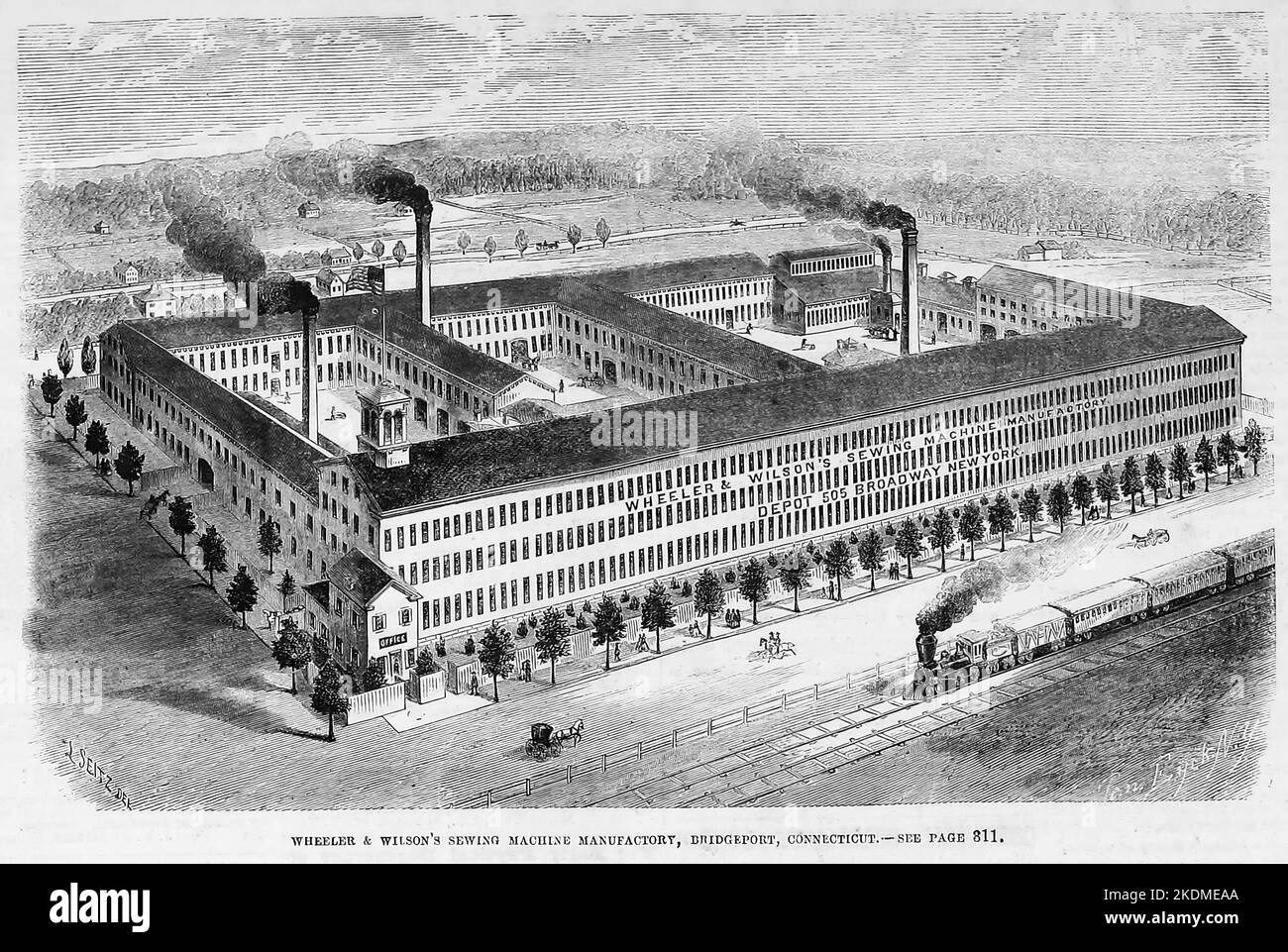 Wheeler and Wilson Sewing Machine Manufactory, Bridgeport, Connecticut. January 1863. 19th century American Civil War illustration from Frank Leslie's Illustrated Newspaper Stock Photohttps://www.alamy.com/image-license-details/?v=1https://www.alamy.com/wheeler-and-wilson-sewing-machine-manufactory-bridgeport-connecticut-january-1863-19th-century-american-civil-war-illustration-from-frank-leslies-illustrated-newspaper-image490331138.html
Wheeler and Wilson Sewing Machine Manufactory, Bridgeport, Connecticut. January 1863. 19th century American Civil War illustration from Frank Leslie's Illustrated Newspaper Stock Photohttps://www.alamy.com/image-license-details/?v=1https://www.alamy.com/wheeler-and-wilson-sewing-machine-manufactory-bridgeport-connecticut-january-1863-19th-century-american-civil-war-illustration-from-frank-leslies-illustrated-newspaper-image490331138.htmlRF2KDMEAA–Wheeler and Wilson Sewing Machine Manufactory, Bridgeport, Connecticut. January 1863. 19th century American Civil War illustration from Frank Leslie's Illustrated Newspaper
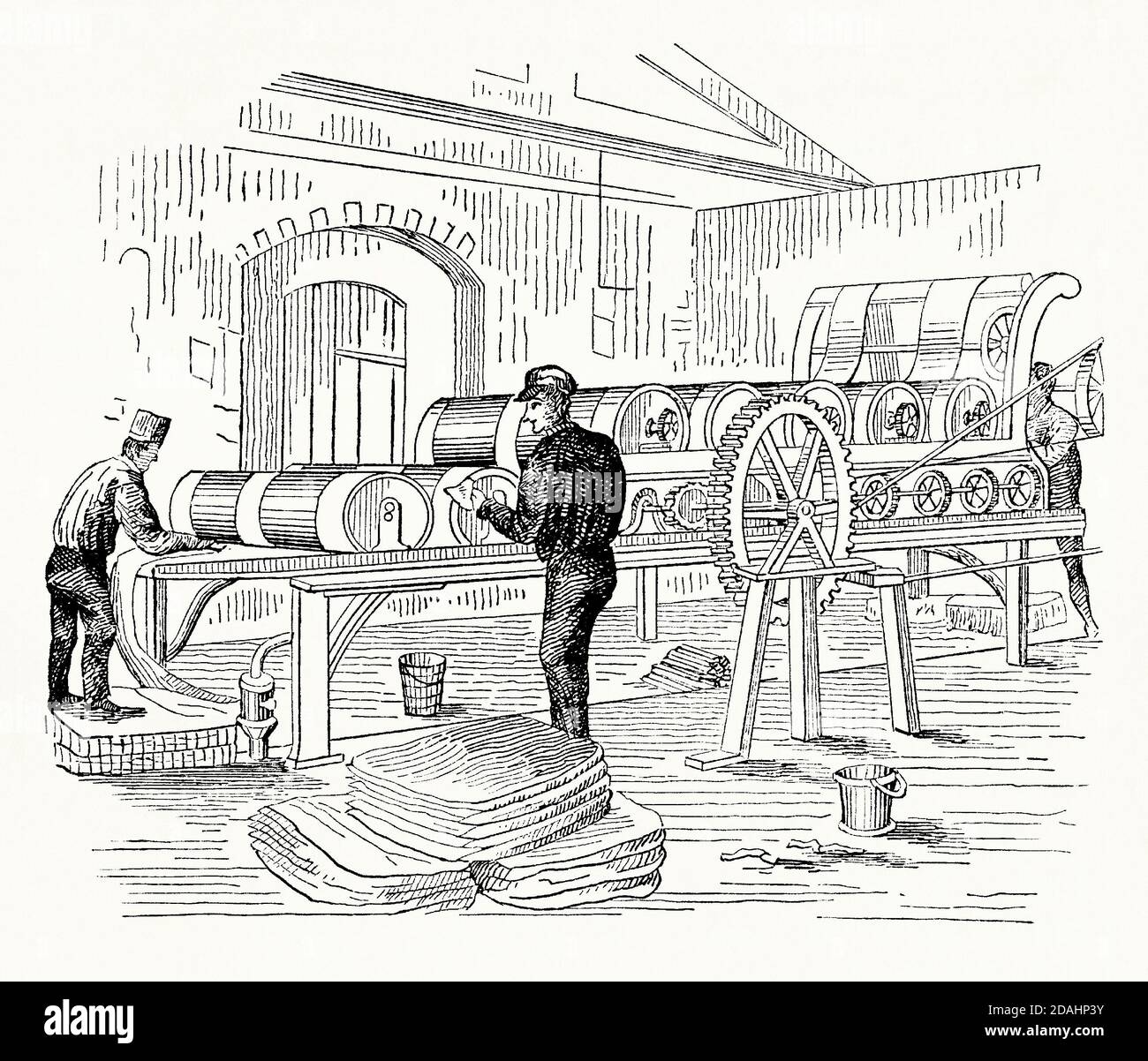 An old engraving of a cloth drying machine in a textile mill or factory. It is from a Victorian mechanical engineering book of the 1880s. The machinery in operation uses heated cylinders and rollers on which cotton or linen is run through. The process dries and irons the material. Similar machines are used to dry paper. Stock Photohttps://www.alamy.com/image-license-details/?v=1https://www.alamy.com/an-old-engraving-of-a-cloth-drying-machine-in-a-textile-mill-or-factory-it-is-from-a-victorian-mechanical-engineering-book-of-the-1880s-the-machinery-in-operation-uses-heated-cylinders-and-rollers-on-which-cotton-or-linen-is-run-through-the-process-dries-and-irons-the-material-similar-machines-are-used-to-dry-paper-image385165199.html
An old engraving of a cloth drying machine in a textile mill or factory. It is from a Victorian mechanical engineering book of the 1880s. The machinery in operation uses heated cylinders and rollers on which cotton or linen is run through. The process dries and irons the material. Similar machines are used to dry paper. Stock Photohttps://www.alamy.com/image-license-details/?v=1https://www.alamy.com/an-old-engraving-of-a-cloth-drying-machine-in-a-textile-mill-or-factory-it-is-from-a-victorian-mechanical-engineering-book-of-the-1880s-the-machinery-in-operation-uses-heated-cylinders-and-rollers-on-which-cotton-or-linen-is-run-through-the-process-dries-and-irons-the-material-similar-machines-are-used-to-dry-paper-image385165199.htmlRM2DAHP3Y–An old engraving of a cloth drying machine in a textile mill or factory. It is from a Victorian mechanical engineering book of the 1880s. The machinery in operation uses heated cylinders and rollers on which cotton or linen is run through. The process dries and irons the material. Similar machines are used to dry paper.
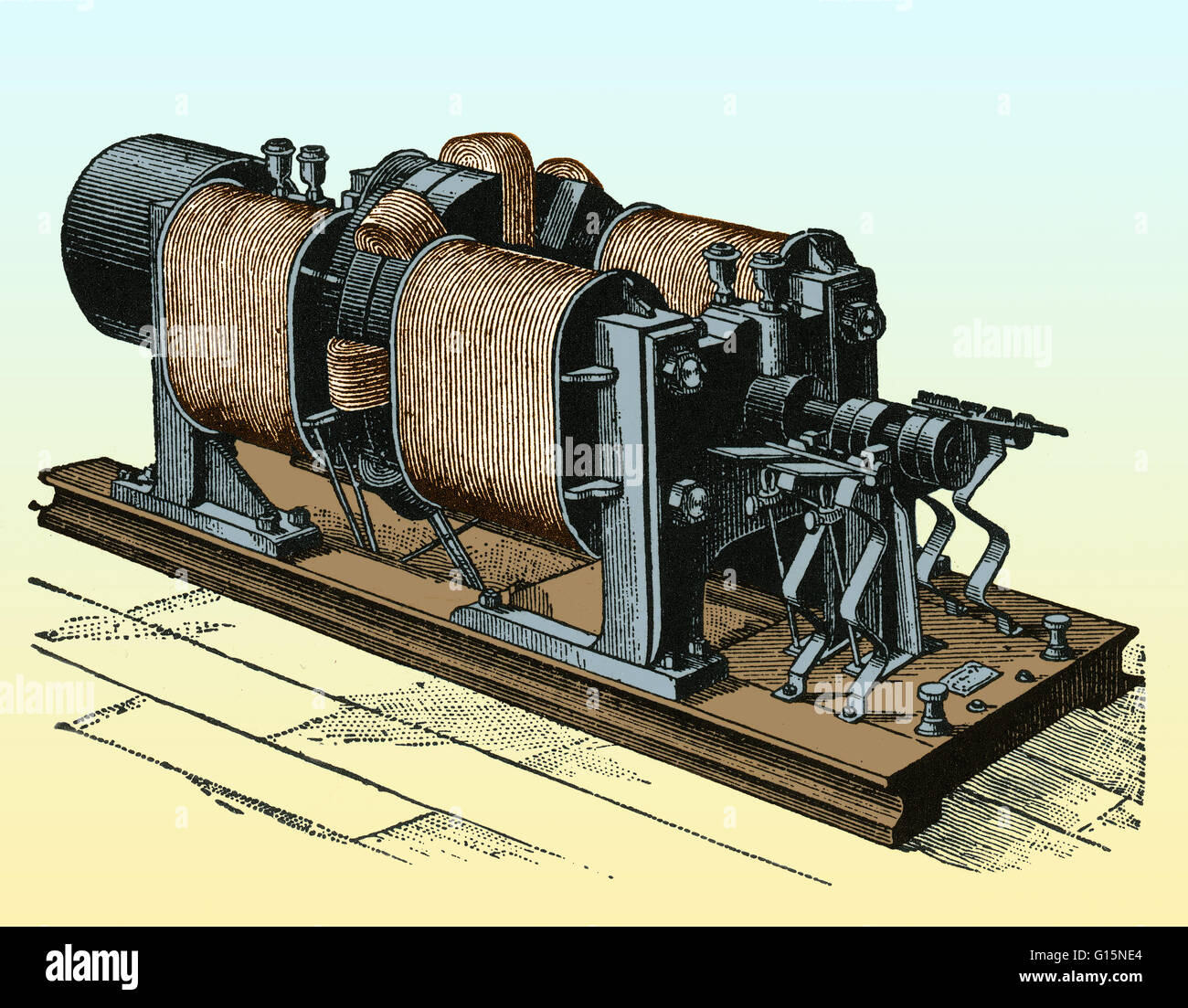 Dynamo Electric Machine. The Dynamo was the first electric generator capable of delivering power for industry. Stock Photohttps://www.alamy.com/image-license-details/?v=1https://www.alamy.com/stock-photo-dynamo-electric-machine-the-dynamo-was-the-first-electric-generator-104003484.html
Dynamo Electric Machine. The Dynamo was the first electric generator capable of delivering power for industry. Stock Photohttps://www.alamy.com/image-license-details/?v=1https://www.alamy.com/stock-photo-dynamo-electric-machine-the-dynamo-was-the-first-electric-generator-104003484.htmlRMG15NE4–Dynamo Electric Machine. The Dynamo was the first electric generator capable of delivering power for industry.
 Drawing of the dynamoelectric machine on the adjustable base made by Weston factory Newark, from the book 'The Maxim Electric Light and Power Co.', 1882. Courtesy Internet Archive. () Stock Photohttps://www.alamy.com/image-license-details/?v=1https://www.alamy.com/drawing-of-the-dynamoelectric-machine-on-the-adjustable-base-made-by-weston-factory-newark-from-the-book-the-maxim-electric-light-and-power-co-1882-courtesy-internet-archive-image245273683.html
Drawing of the dynamoelectric machine on the adjustable base made by Weston factory Newark, from the book 'The Maxim Electric Light and Power Co.', 1882. Courtesy Internet Archive. () Stock Photohttps://www.alamy.com/image-license-details/?v=1https://www.alamy.com/drawing-of-the-dynamoelectric-machine-on-the-adjustable-base-made-by-weston-factory-newark-from-the-book-the-maxim-electric-light-and-power-co-1882-courtesy-internet-archive-image245273683.htmlRMT7152B–Drawing of the dynamoelectric machine on the adjustable base made by Weston factory Newark, from the book 'The Maxim Electric Light and Power Co.', 1882. Courtesy Internet Archive. ()
 M Rapp rock slicing machine. Old 19th century engraved illustration from La Nature 1883 Stock Photohttps://www.alamy.com/image-license-details/?v=1https://www.alamy.com/m-rapp-rock-slicing-machine-old-19th-century-engraved-illustration-from-la-nature-1883-image442909186.html
M Rapp rock slicing machine. Old 19th century engraved illustration from La Nature 1883 Stock Photohttps://www.alamy.com/image-license-details/?v=1https://www.alamy.com/m-rapp-rock-slicing-machine-old-19th-century-engraved-illustration-from-la-nature-1883-image442909186.htmlRM2GMG756–M Rapp rock slicing machine. Old 19th century engraved illustration from La Nature 1883
 Engraving of the Singer Sewing Machine Company factory, Elizabethport, New Jersey, from the book 'Industrial history of the United States' by Albert Sidney Bolles, 1878. Courtesy Internet Archive. Note: Image has been digitally colorized using a modern process. Colors may not be period-accurate. () Stock Photohttps://www.alamy.com/image-license-details/?v=1https://www.alamy.com/engraving-of-the-singer-sewing-machine-company-factory-elizabethport-new-jersey-from-the-book-industrial-history-of-the-united-states-by-albert-sidney-bolles-1878-courtesy-internet-archive-note-image-has-been-digitally-colorized-using-a-modern-process-colors-may-not-be-period-accurate-image349199585.html
Engraving of the Singer Sewing Machine Company factory, Elizabethport, New Jersey, from the book 'Industrial history of the United States' by Albert Sidney Bolles, 1878. Courtesy Internet Archive. Note: Image has been digitally colorized using a modern process. Colors may not be period-accurate. () Stock Photohttps://www.alamy.com/image-license-details/?v=1https://www.alamy.com/engraving-of-the-singer-sewing-machine-company-factory-elizabethport-new-jersey-from-the-book-industrial-history-of-the-united-states-by-albert-sidney-bolles-1878-courtesy-internet-archive-note-image-has-been-digitally-colorized-using-a-modern-process-colors-may-not-be-period-accurate-image349199585.htmlRM2B83BHN–Engraving of the Singer Sewing Machine Company factory, Elizabethport, New Jersey, from the book 'Industrial history of the United States' by Albert Sidney Bolles, 1878. Courtesy Internet Archive. Note: Image has been digitally colorized using a modern process. Colors may not be period-accurate. ()
 Continuous paper machine for making cigarette paper designed by Burot. Old 19th century engraved illustration from La Nature 1893 Stock Photohttps://www.alamy.com/image-license-details/?v=1https://www.alamy.com/continuous-paper-machine-for-making-cigarette-paper-designed-by-burot-old-19th-century-engraved-illustration-from-la-nature-1893-image429146897.html
Continuous paper machine for making cigarette paper designed by Burot. Old 19th century engraved illustration from La Nature 1893 Stock Photohttps://www.alamy.com/image-license-details/?v=1https://www.alamy.com/continuous-paper-machine-for-making-cigarette-paper-designed-by-burot-old-19th-century-engraved-illustration-from-la-nature-1893-image429146897.htmlRM2FX596W–Continuous paper machine for making cigarette paper designed by Burot. Old 19th century engraved illustration from La Nature 1893
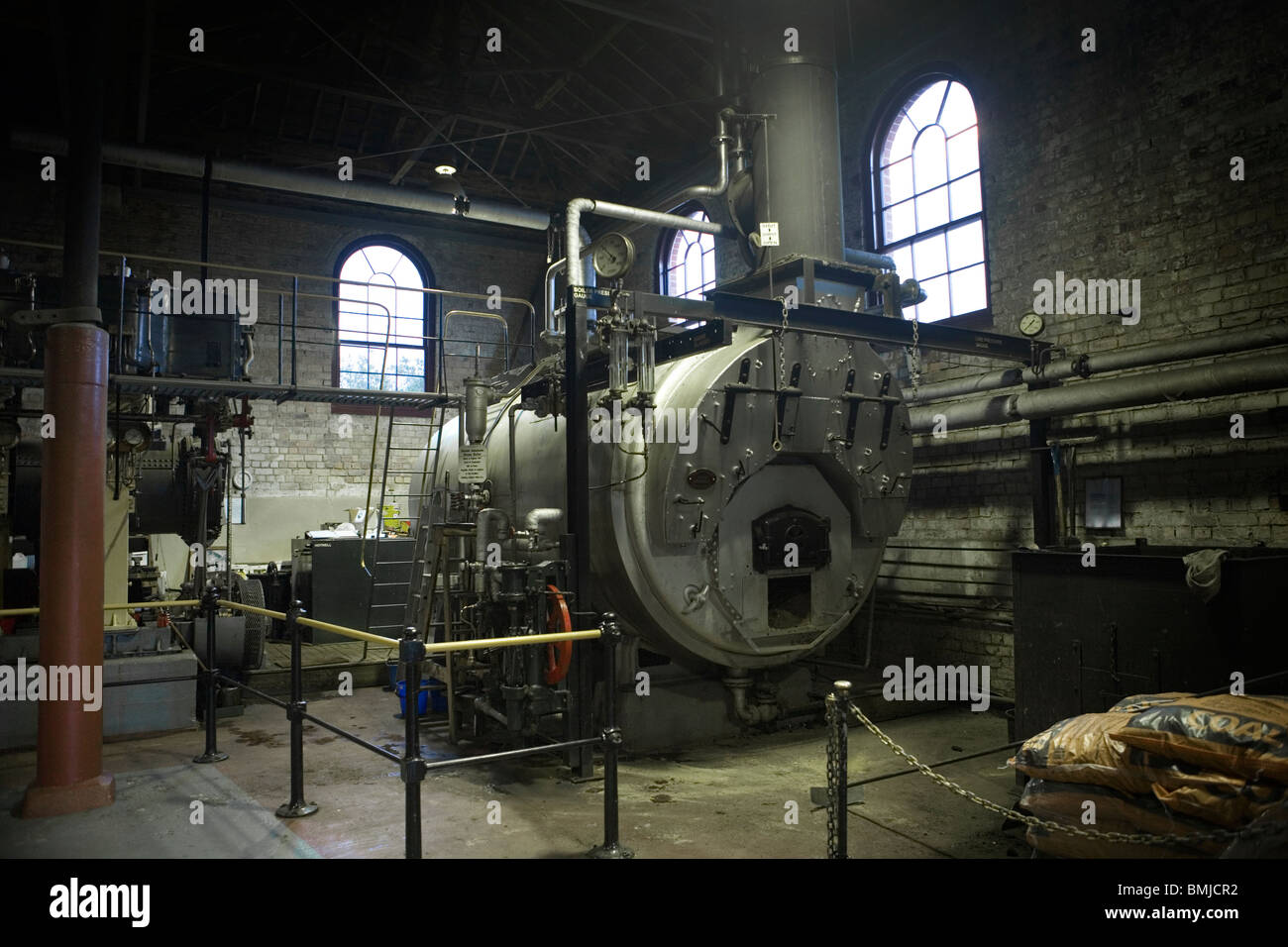 A nineteenth (XIX) century (1800s) heat machine room with a big coal boiler, Auckland, New Zealand Stock Photohttps://www.alamy.com/image-license-details/?v=1https://www.alamy.com/stock-photo-a-nineteenth-xix-century-1800s-heat-machine-room-with-a-big-coal-boiler-29908678.html
A nineteenth (XIX) century (1800s) heat machine room with a big coal boiler, Auckland, New Zealand Stock Photohttps://www.alamy.com/image-license-details/?v=1https://www.alamy.com/stock-photo-a-nineteenth-xix-century-1800s-heat-machine-room-with-a-big-coal-boiler-29908678.htmlRMBMJCR2–A nineteenth (XIX) century (1800s) heat machine room with a big coal boiler, Auckland, New Zealand
 Machine to classify stones according to their size. Old 19th century engraving from La Nature 1887 Stock Photohttps://www.alamy.com/image-license-details/?v=1https://www.alamy.com/machine-to-classify-stones-according-to-their-size-old-19th-century-engraving-from-la-nature-1887-image554116921.html
Machine to classify stones according to their size. Old 19th century engraving from La Nature 1887 Stock Photohttps://www.alamy.com/image-license-details/?v=1https://www.alamy.com/machine-to-classify-stones-according-to-their-size-old-19th-century-engraving-from-la-nature-1887-image554116921.htmlRM2R5E5P1–Machine to classify stones according to their size. Old 19th century engraving from La Nature 1887
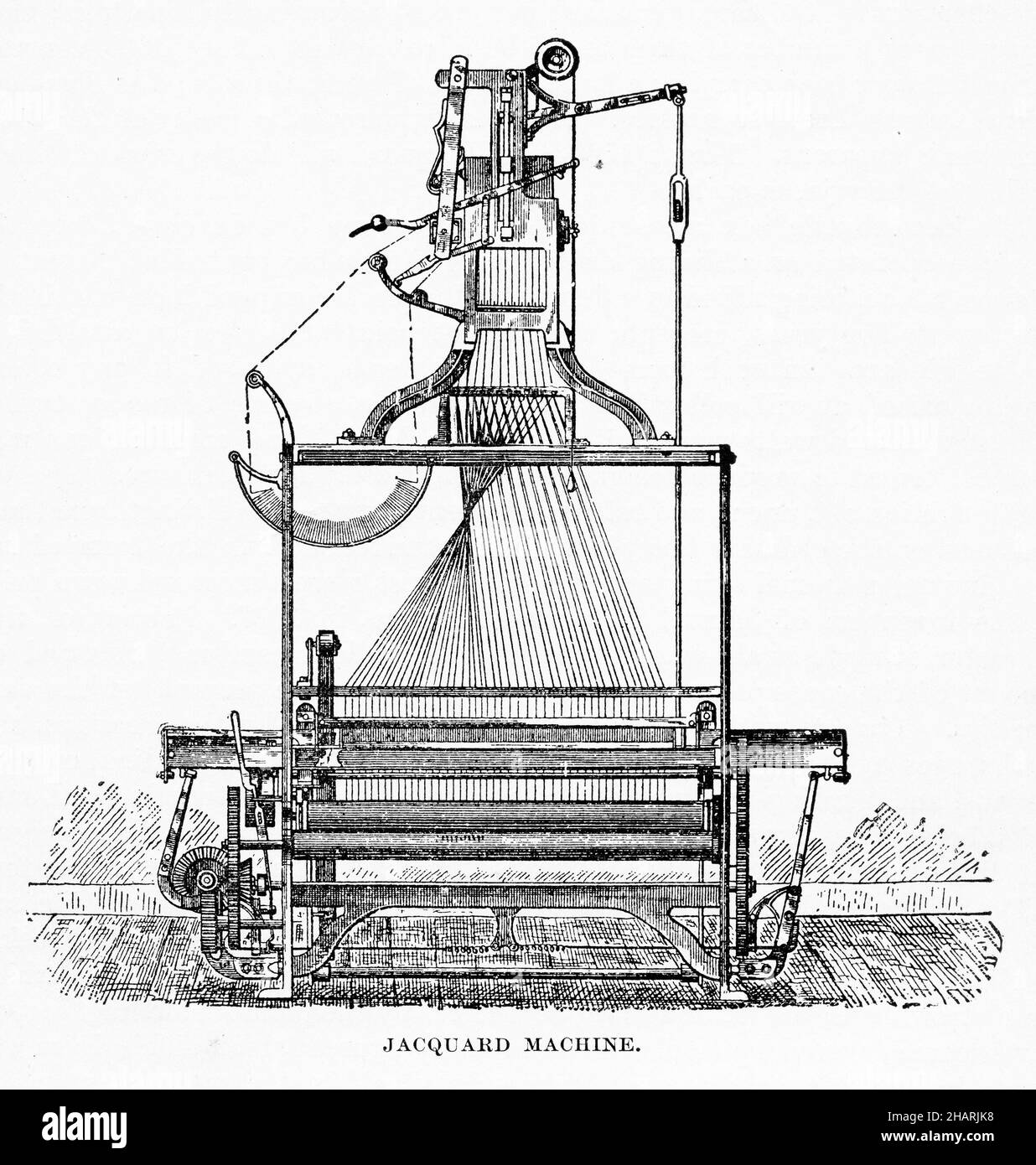 Engraving of a jacquard machine for adding brocade, damask and matelassé to fabric Stock Photohttps://www.alamy.com/image-license-details/?v=1https://www.alamy.com/engraving-of-a-jacquard-machine-for-adding-brocade-damask-and-matelass-to-fabric-image454135676.html
Engraving of a jacquard machine for adding brocade, damask and matelassé to fabric Stock Photohttps://www.alamy.com/image-license-details/?v=1https://www.alamy.com/engraving-of-a-jacquard-machine-for-adding-brocade-damask-and-matelass-to-fabric-image454135676.htmlRM2HARJK8–Engraving of a jacquard machine for adding brocade, damask and matelassé to fabric
 Wood cutting machine. Old 19th century engraving from La Nature 1887 Stock Photohttps://www.alamy.com/image-license-details/?v=1https://www.alamy.com/wood-cutting-machine-old-19th-century-engraving-from-la-nature-1887-image550985954.html
Wood cutting machine. Old 19th century engraving from La Nature 1887 Stock Photohttps://www.alamy.com/image-license-details/?v=1https://www.alamy.com/wood-cutting-machine-old-19th-century-engraving-from-la-nature-1887-image550985954.htmlRM2R0BG5P–Wood cutting machine. Old 19th century engraving from La Nature 1887
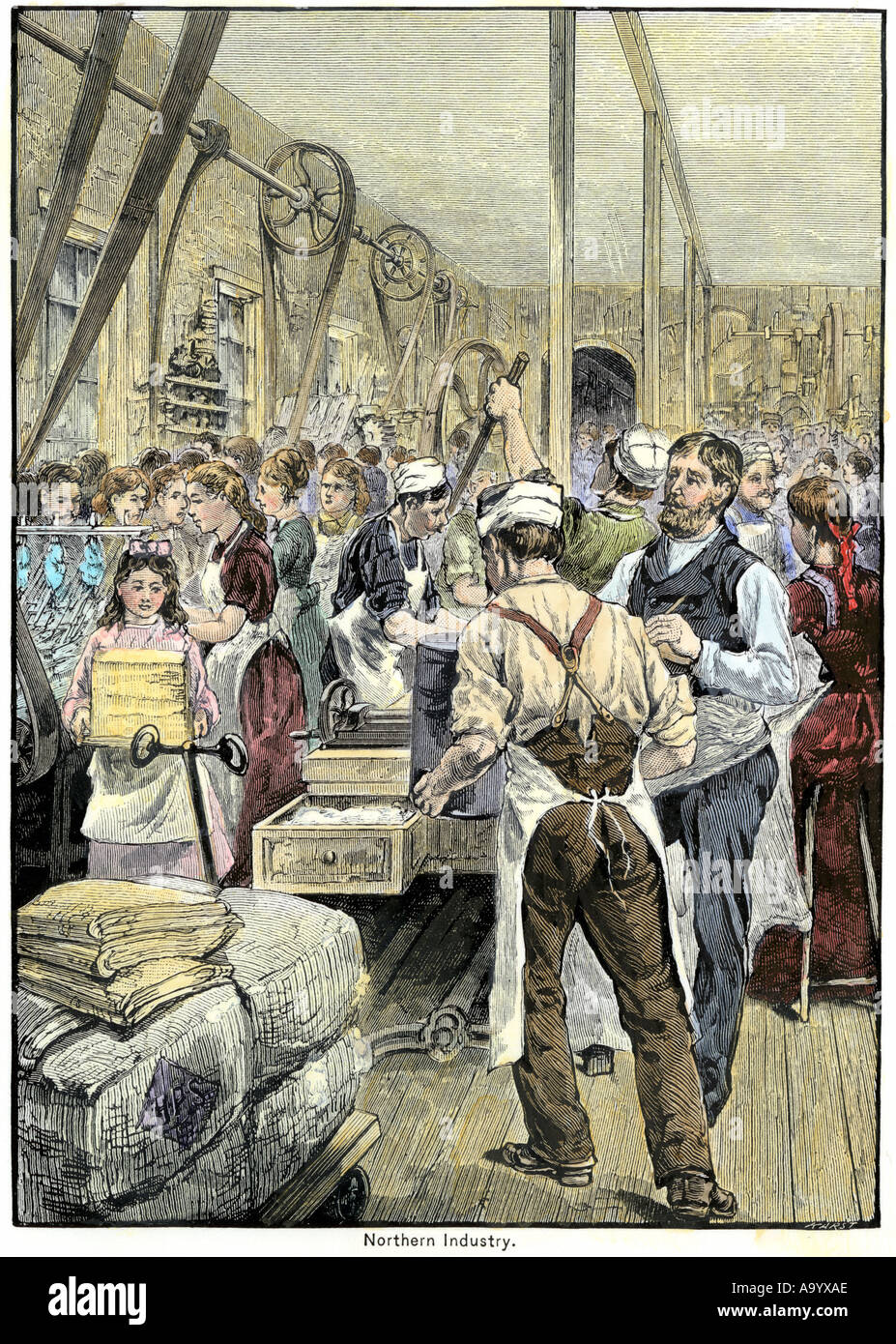 Textile workers in a northern mill in the US 1800s. Hand-colored woodcut Stock Photohttps://www.alamy.com/image-license-details/?v=1https://www.alamy.com/textile-workers-in-a-northern-mill-in-the-us-1800s-hand-colored-woodcut-image4071085.html
Textile workers in a northern mill in the US 1800s. Hand-colored woodcut Stock Photohttps://www.alamy.com/image-license-details/?v=1https://www.alamy.com/textile-workers-in-a-northern-mill-in-the-us-1800s-hand-colored-woodcut-image4071085.htmlRMA9YXAE–Textile workers in a northern mill in the US 1800s. Hand-colored woodcut
 Engraving of a young woman watching a cotton-making machine, circa 1880 Stock Photohttps://www.alamy.com/image-license-details/?v=1https://www.alamy.com/engraving-of-a-young-woman-watching-a-cotton-making-machine-circa-1880-image537037881.html
Engraving of a young woman watching a cotton-making machine, circa 1880 Stock Photohttps://www.alamy.com/image-license-details/?v=1https://www.alamy.com/engraving-of-a-young-woman-watching-a-cotton-making-machine-circa-1880-image537037881.htmlRM2P5M589–Engraving of a young woman watching a cotton-making machine, circa 1880
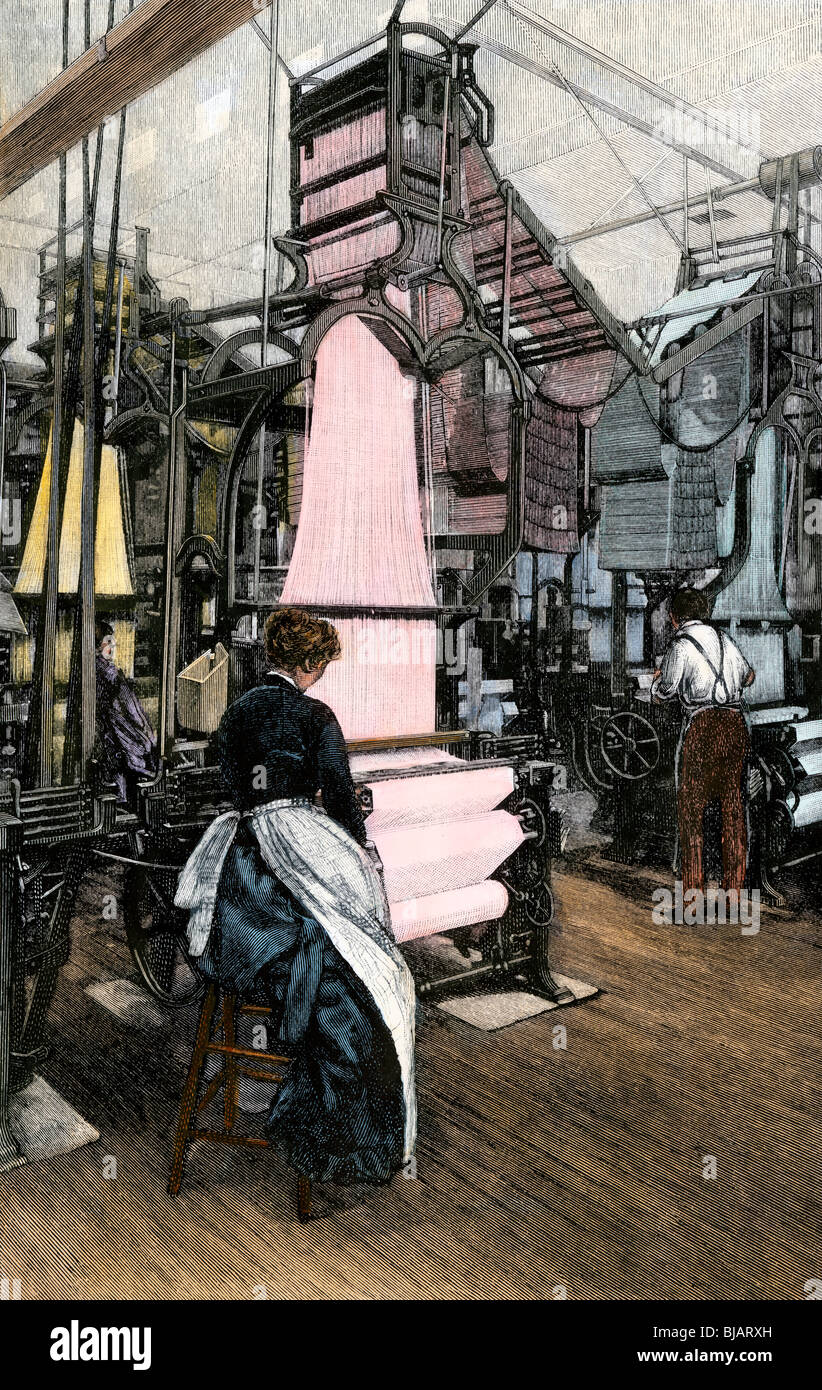 Woman worker using a mechanized Jacquard loom, 1880s. Hand-colored woodcut Stock Photohttps://www.alamy.com/image-license-details/?v=1https://www.alamy.com/stock-photo-woman-worker-using-a-mechanized-jacquard-loom-1880s-hand-colored-woodcut-28512473.html
Woman worker using a mechanized Jacquard loom, 1880s. Hand-colored woodcut Stock Photohttps://www.alamy.com/image-license-details/?v=1https://www.alamy.com/stock-photo-woman-worker-using-a-mechanized-jacquard-loom-1880s-hand-colored-woodcut-28512473.htmlRMBJARXH–Woman worker using a mechanized Jacquard loom, 1880s. Hand-colored woodcut
 Ancient wooden machinery used in the 1800s in castles for various operations. Stock Photohttps://www.alamy.com/image-license-details/?v=1https://www.alamy.com/ancient-wooden-machinery-used-in-the-1800s-in-castles-for-various-operations-image440212733.html
Ancient wooden machinery used in the 1800s in castles for various operations. Stock Photohttps://www.alamy.com/image-license-details/?v=1https://www.alamy.com/ancient-wooden-machinery-used-in-the-1800s-in-castles-for-various-operations-image440212733.htmlRF2GG5BR9–Ancient wooden machinery used in the 1800s in castles for various operations.
 A photograph of a mature Puerto Rican woman using a sewing machine in the Everglades Needlework Factory, she is using the machine to work a piece of floral patterned fabric, she wears a striped blouse and glasses, another work bench in the factory can be seen behind her, San Juan, Puerto Rico, 1864. From the New York Public Library. Stock Photohttps://www.alamy.com/image-license-details/?v=1https://www.alamy.com/stock-image-a-photograph-of-a-mature-puerto-rican-woman-using-a-sewing-machine-166777196.html
A photograph of a mature Puerto Rican woman using a sewing machine in the Everglades Needlework Factory, she is using the machine to work a piece of floral patterned fabric, she wears a striped blouse and glasses, another work bench in the factory can be seen behind her, San Juan, Puerto Rico, 1864. From the New York Public Library. Stock Photohttps://www.alamy.com/image-license-details/?v=1https://www.alamy.com/stock-image-a-photograph-of-a-mature-puerto-rican-woman-using-a-sewing-machine-166777196.htmlRMKK9A0C–A photograph of a mature Puerto Rican woman using a sewing machine in the Everglades Needlework Factory, she is using the machine to work a piece of floral patterned fabric, she wears a striped blouse and glasses, another work bench in the factory can be seen behind her, San Juan, Puerto Rico, 1864. From the New York Public Library.
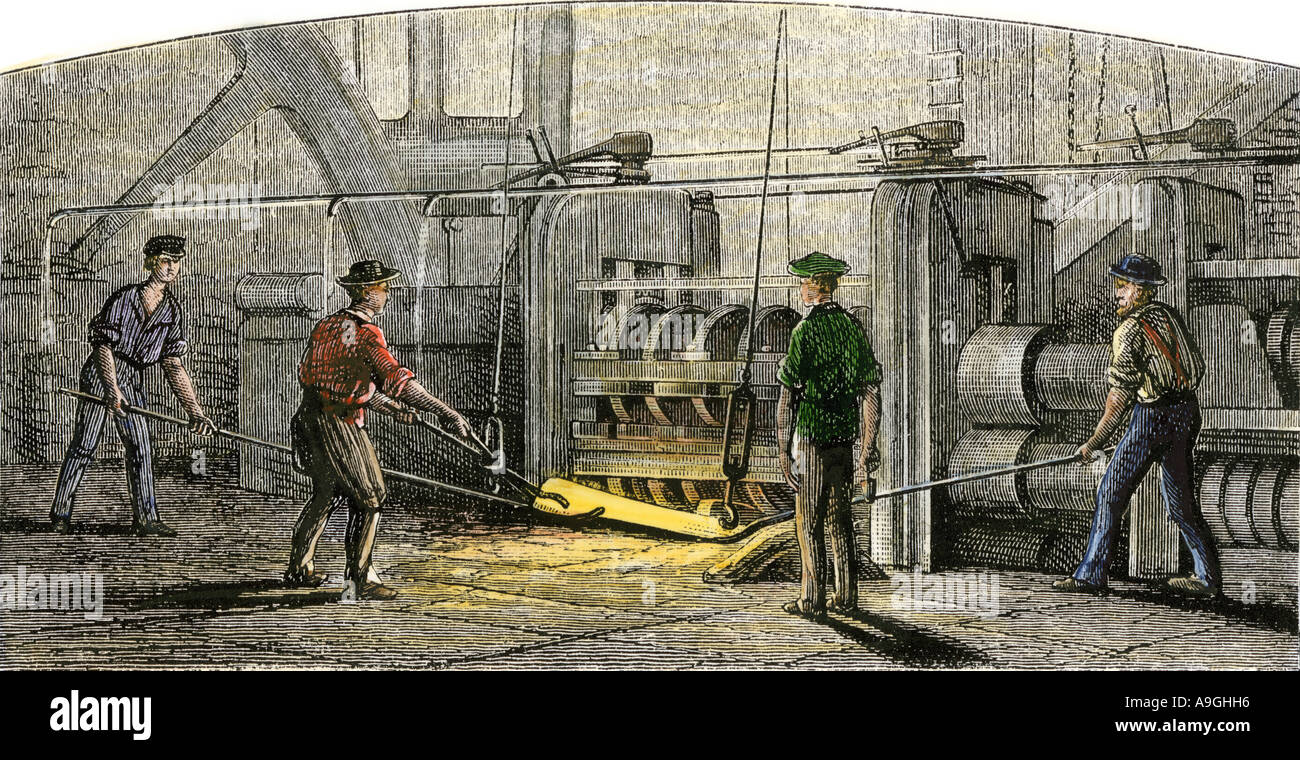 Vulcan Iron Works in Carondelet, Missouri in the mid 1800s. Hand-colored woodcut Stock Photohttps://www.alamy.com/image-license-details/?v=1https://www.alamy.com/vulcan-iron-works-in-carondelet-missouri-in-the-mid-1800s-hand-colored-image7063765.html
Vulcan Iron Works in Carondelet, Missouri in the mid 1800s. Hand-colored woodcut Stock Photohttps://www.alamy.com/image-license-details/?v=1https://www.alamy.com/vulcan-iron-works-in-carondelet-missouri-in-the-mid-1800s-hand-colored-image7063765.htmlRMA9GHH6–Vulcan Iron Works in Carondelet, Missouri in the mid 1800s. Hand-colored woodcut
 BRICK AND TILE-MAKING INDUSTRY - Automation - An early C1800s magazine illustration of a newly invented tile making machine Stock Photohttps://www.alamy.com/image-license-details/?v=1https://www.alamy.com/brick-and-tile-making-industry-automation-an-early-c1800s-magazine-illustration-of-a-newly-invented-tile-making-machine-image462240177.html
BRICK AND TILE-MAKING INDUSTRY - Automation - An early C1800s magazine illustration of a newly invented tile making machine Stock Photohttps://www.alamy.com/image-license-details/?v=1https://www.alamy.com/brick-and-tile-making-industry-automation-an-early-c1800s-magazine-illustration-of-a-newly-invented-tile-making-machine-image462240177.htmlRM2HT0T1N–BRICK AND TILE-MAKING INDUSTRY - Automation - An early C1800s magazine illustration of a newly invented tile making machine
 Whitworth's radial drilling machine exhibited at The International Exhibition South Kensington London, England. Victorian engraving dated 5th July 1862 Stock Photohttps://www.alamy.com/image-license-details/?v=1https://www.alamy.com/stock-photo-whitworths-radial-drilling-machine-exhibited-at-the-international-47481549.html
Whitworth's radial drilling machine exhibited at The International Exhibition South Kensington London, England. Victorian engraving dated 5th July 1862 Stock Photohttps://www.alamy.com/image-license-details/?v=1https://www.alamy.com/stock-photo-whitworths-radial-drilling-machine-exhibited-at-the-international-47481549.htmlRMCN6Y5H–Whitworth's radial drilling machine exhibited at The International Exhibition South Kensington London, England. Victorian engraving dated 5th July 1862
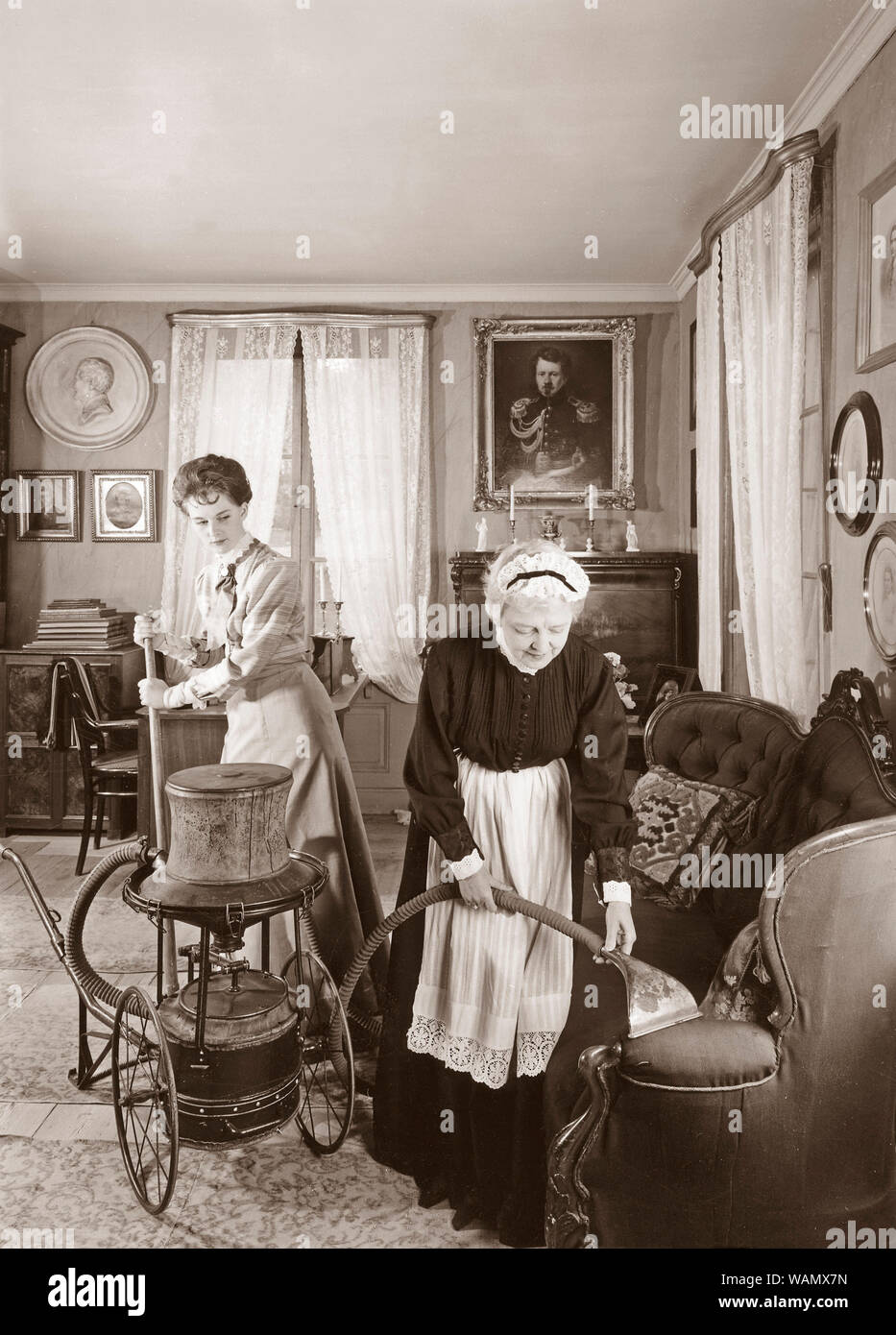 Vacuuming at the turn of the century 1800-1900. Before electricity became common in homes, the early vacuum cleaners were primitive dust machines. Here a recreated historical scene in a home where two women maneuver a hand driven vacuum cleaner. The younger woman creates vacuum and suction with a lever. The elderly woman uses it to clean the sofa. 1901 was the year of the first patent for an electrical vacuum cleaner. In Sweden Axel Wenner-Gren developed the invention and 1913 Lux factory began production of the first swedish electric one called Model 1, a machine of 14 kg. Stock Photohttps://www.alamy.com/image-license-details/?v=1https://www.alamy.com/vacuuming-at-the-turn-of-the-century-1800-1900-before-electricity-became-common-in-homes-the-early-vacuum-cleaners-were-primitive-dust-machines-here-a-recreated-historical-scene-in-a-home-where-two-women-maneuver-a-hand-driven-vacuum-cleaner-the-younger-woman-creates-vacuum-and-suction-with-a-lever-the-elderly-woman-uses-it-to-clean-the-sofa-1901-was-the-year-of-the-first-patent-for-an-electrical-vacuum-cleaner-in-sweden-axel-wenner-gren-developed-the-invention-and-1913-lux-factory-began-production-of-the-first-swedish-electric-one-called-model-1-a-machine-of-14-kg-image264761721.html
Vacuuming at the turn of the century 1800-1900. Before electricity became common in homes, the early vacuum cleaners were primitive dust machines. Here a recreated historical scene in a home where two women maneuver a hand driven vacuum cleaner. The younger woman creates vacuum and suction with a lever. The elderly woman uses it to clean the sofa. 1901 was the year of the first patent for an electrical vacuum cleaner. In Sweden Axel Wenner-Gren developed the invention and 1913 Lux factory began production of the first swedish electric one called Model 1, a machine of 14 kg. Stock Photohttps://www.alamy.com/image-license-details/?v=1https://www.alamy.com/vacuuming-at-the-turn-of-the-century-1800-1900-before-electricity-became-common-in-homes-the-early-vacuum-cleaners-were-primitive-dust-machines-here-a-recreated-historical-scene-in-a-home-where-two-women-maneuver-a-hand-driven-vacuum-cleaner-the-younger-woman-creates-vacuum-and-suction-with-a-lever-the-elderly-woman-uses-it-to-clean-the-sofa-1901-was-the-year-of-the-first-patent-for-an-electrical-vacuum-cleaner-in-sweden-axel-wenner-gren-developed-the-invention-and-1913-lux-factory-began-production-of-the-first-swedish-electric-one-called-model-1-a-machine-of-14-kg-image264761721.htmlRMWAMX7N–Vacuuming at the turn of the century 1800-1900. Before electricity became common in homes, the early vacuum cleaners were primitive dust machines. Here a recreated historical scene in a home where two women maneuver a hand driven vacuum cleaner. The younger woman creates vacuum and suction with a lever. The elderly woman uses it to clean the sofa. 1901 was the year of the first patent for an electrical vacuum cleaner. In Sweden Axel Wenner-Gren developed the invention and 1913 Lux factory began production of the first swedish electric one called Model 1, a machine of 14 kg.
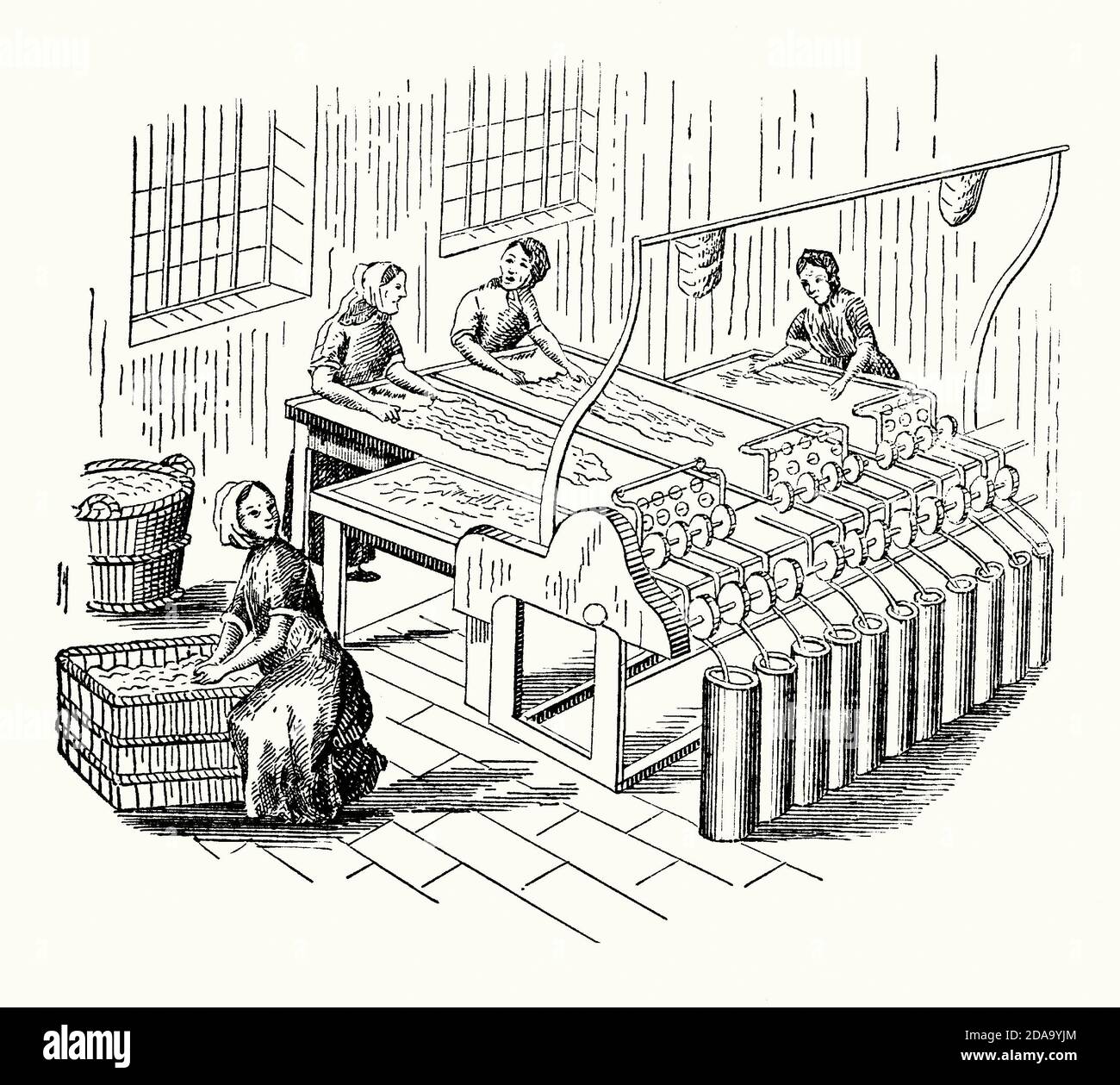 An old engraving of drawing out flax in a textile mill or factory. It is from a Victorian mechanical engineering book of the 1880s. The machinery in operation separates, cleans, and draws out the fibres, using toothed cylinders (breaking or heckling cylinders). The use of the cylinders and rollers can be performed repeatedly at the same machine (sometimes called ‘doubling’) until the fibres become uniform in thickness. Stock Photohttps://www.alamy.com/image-license-details/?v=1https://www.alamy.com/an-old-engraving-of-drawing-out-flax-in-a-textile-mill-or-factory-it-is-from-a-victorian-mechanical-engineering-book-of-the-1880s-the-machinery-in-operation-separates-cleans-and-draws-out-the-fibres-using-toothed-cylinders-breaking-or-heckling-cylinders-the-use-of-the-cylinders-and-rollers-can-be-performed-repeatedly-at-the-same-machine-sometimes-called-doubling-until-the-fibres-become-uniform-in-thickness-image384993916.html
An old engraving of drawing out flax in a textile mill or factory. It is from a Victorian mechanical engineering book of the 1880s. The machinery in operation separates, cleans, and draws out the fibres, using toothed cylinders (breaking or heckling cylinders). The use of the cylinders and rollers can be performed repeatedly at the same machine (sometimes called ‘doubling’) until the fibres become uniform in thickness. Stock Photohttps://www.alamy.com/image-license-details/?v=1https://www.alamy.com/an-old-engraving-of-drawing-out-flax-in-a-textile-mill-or-factory-it-is-from-a-victorian-mechanical-engineering-book-of-the-1880s-the-machinery-in-operation-separates-cleans-and-draws-out-the-fibres-using-toothed-cylinders-breaking-or-heckling-cylinders-the-use-of-the-cylinders-and-rollers-can-be-performed-repeatedly-at-the-same-machine-sometimes-called-doubling-until-the-fibres-become-uniform-in-thickness-image384993916.htmlRM2DA9YJM–An old engraving of drawing out flax in a textile mill or factory. It is from a Victorian mechanical engineering book of the 1880s. The machinery in operation separates, cleans, and draws out the fibres, using toothed cylinders (breaking or heckling cylinders). The use of the cylinders and rollers can be performed repeatedly at the same machine (sometimes called ‘doubling’) until the fibres become uniform in thickness.
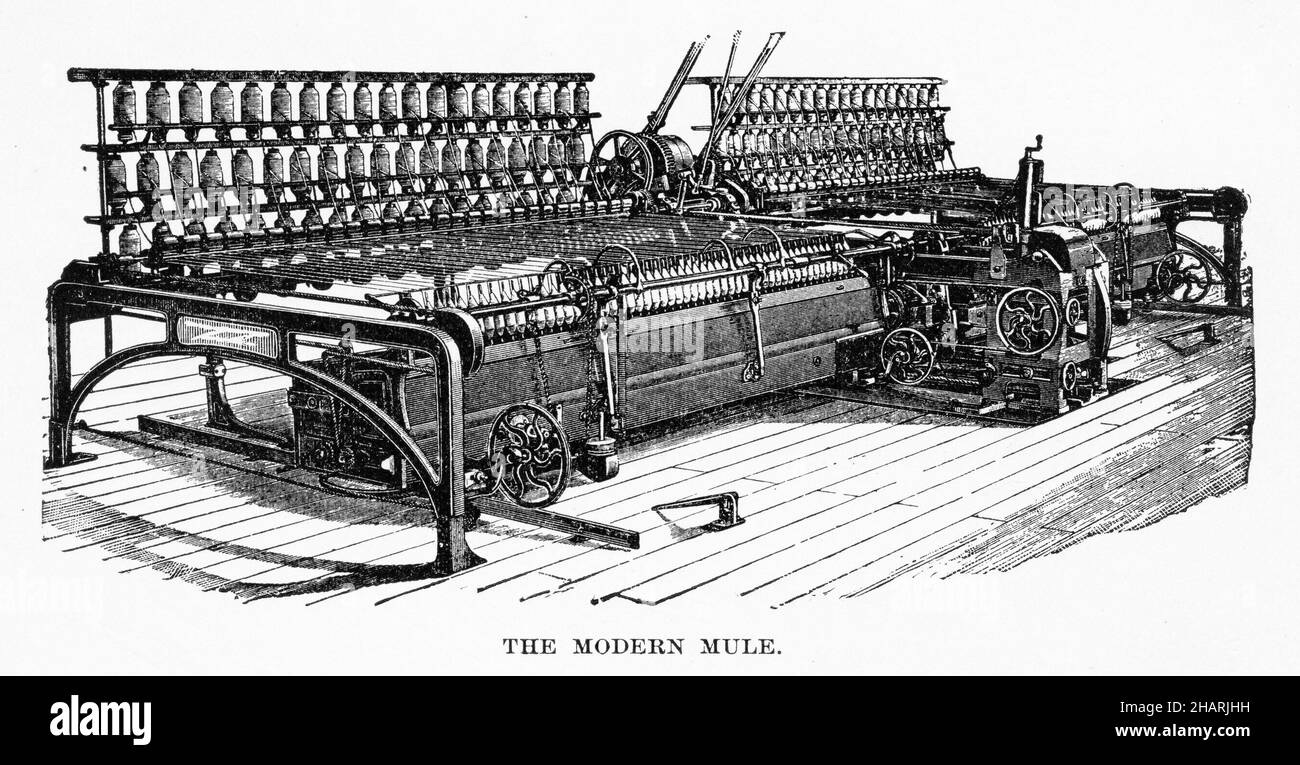 Engraving of 'the modern mule' a mechanised loom of the Industrial revolution Stock Photohttps://www.alamy.com/image-license-details/?v=1https://www.alamy.com/engraving-of-the-modern-mule-a-mechanised-loom-of-the-industrial-revolution-image454135629.html
Engraving of 'the modern mule' a mechanised loom of the Industrial revolution Stock Photohttps://www.alamy.com/image-license-details/?v=1https://www.alamy.com/engraving-of-the-modern-mule-a-mechanised-loom-of-the-industrial-revolution-image454135629.htmlRM2HARJHH–Engraving of 'the modern mule' a mechanised loom of the Industrial revolution
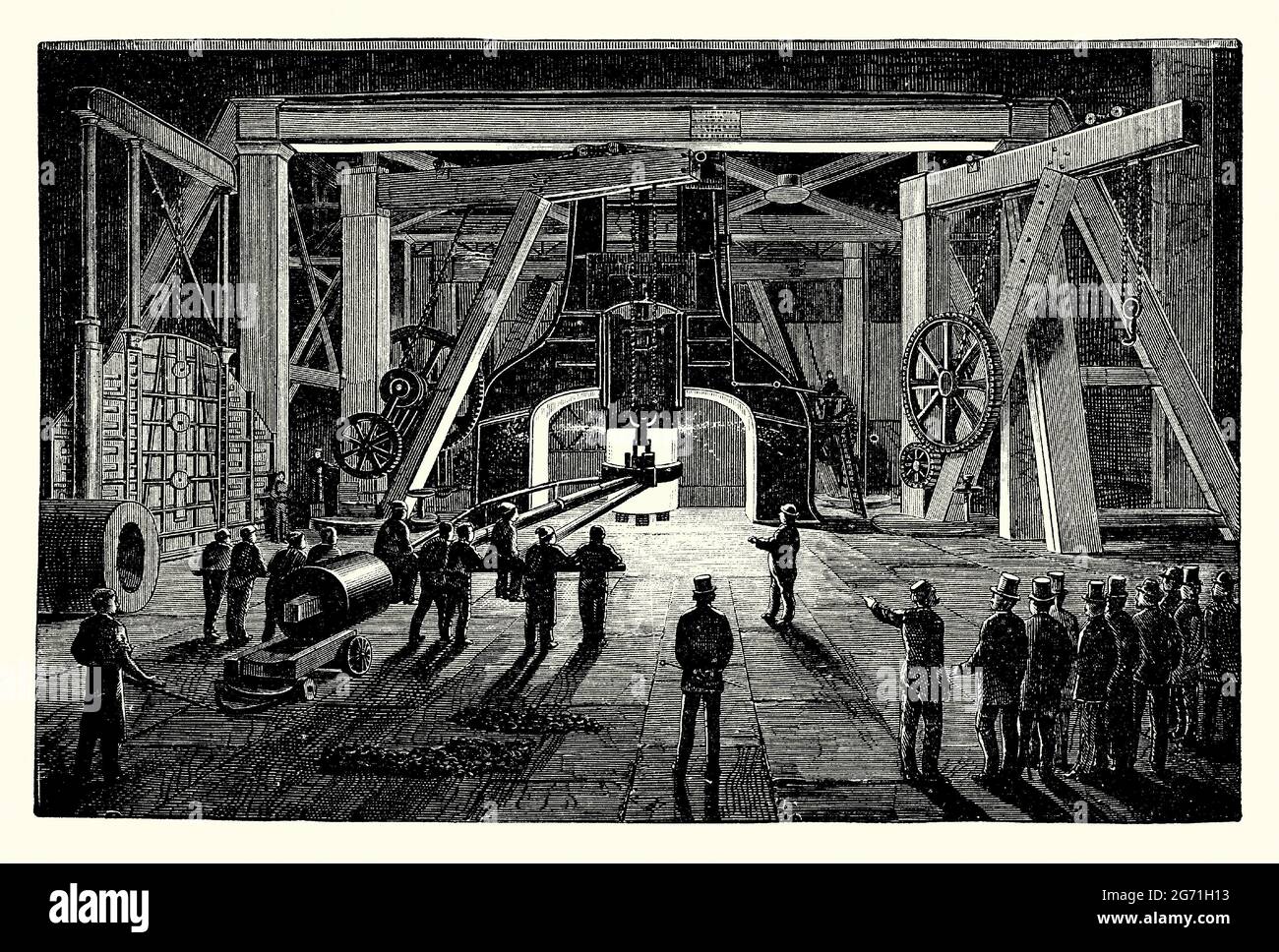 An old engraving of the Great Steam Hammer at the Woolwich Gun Factory, London, England, UK c. 1875. It is from a Victorian book of the 1890s on discoveries and inventions during the 1800s. The 35-ton hammer, built by Nasmyth and Co, was used to forge guns for the British Navy. A steam hammer, also called a drop hammer, is an industrial power hammer driven by steam that is used for tasks such as shaping forgings and driving piles. Stock Photohttps://www.alamy.com/image-license-details/?v=1https://www.alamy.com/an-old-engraving-of-the-great-steam-hammer-at-the-woolwich-gun-factory-london-england-uk-c-1875-it-is-from-a-victorian-book-of-the-1890s-on-discoveries-and-inventions-during-the-1800s-the-35-ton-hammer-built-by-nasmyth-and-co-was-used-to-forge-guns-for-the-british-navy-a-steam-hammer-also-called-a-drop-hammer-is-an-industrial-power-hammer-driven-by-steam-that-is-used-for-tasks-such-as-shaping-forgings-and-driving-piles-image434597103.html
An old engraving of the Great Steam Hammer at the Woolwich Gun Factory, London, England, UK c. 1875. It is from a Victorian book of the 1890s on discoveries and inventions during the 1800s. The 35-ton hammer, built by Nasmyth and Co, was used to forge guns for the British Navy. A steam hammer, also called a drop hammer, is an industrial power hammer driven by steam that is used for tasks such as shaping forgings and driving piles. Stock Photohttps://www.alamy.com/image-license-details/?v=1https://www.alamy.com/an-old-engraving-of-the-great-steam-hammer-at-the-woolwich-gun-factory-london-england-uk-c-1875-it-is-from-a-victorian-book-of-the-1890s-on-discoveries-and-inventions-during-the-1800s-the-35-ton-hammer-built-by-nasmyth-and-co-was-used-to-forge-guns-for-the-british-navy-a-steam-hammer-also-called-a-drop-hammer-is-an-industrial-power-hammer-driven-by-steam-that-is-used-for-tasks-such-as-shaping-forgings-and-driving-piles-image434597103.htmlRM2G71H13–An old engraving of the Great Steam Hammer at the Woolwich Gun Factory, London, England, UK c. 1875. It is from a Victorian book of the 1890s on discoveries and inventions during the 1800s. The 35-ton hammer, built by Nasmyth and Co, was used to forge guns for the British Navy. A steam hammer, also called a drop hammer, is an industrial power hammer driven by steam that is used for tasks such as shaping forgings and driving piles.
 An industrial machine, circa 1865. Stock Photohttps://www.alamy.com/image-license-details/?v=1https://www.alamy.com/an-industrial-machine-circa-1865-image453145881.html
An industrial machine, circa 1865. Stock Photohttps://www.alamy.com/image-license-details/?v=1https://www.alamy.com/an-industrial-machine-circa-1865-image453145881.htmlRM2H96G5D–An industrial machine, circa 1865.
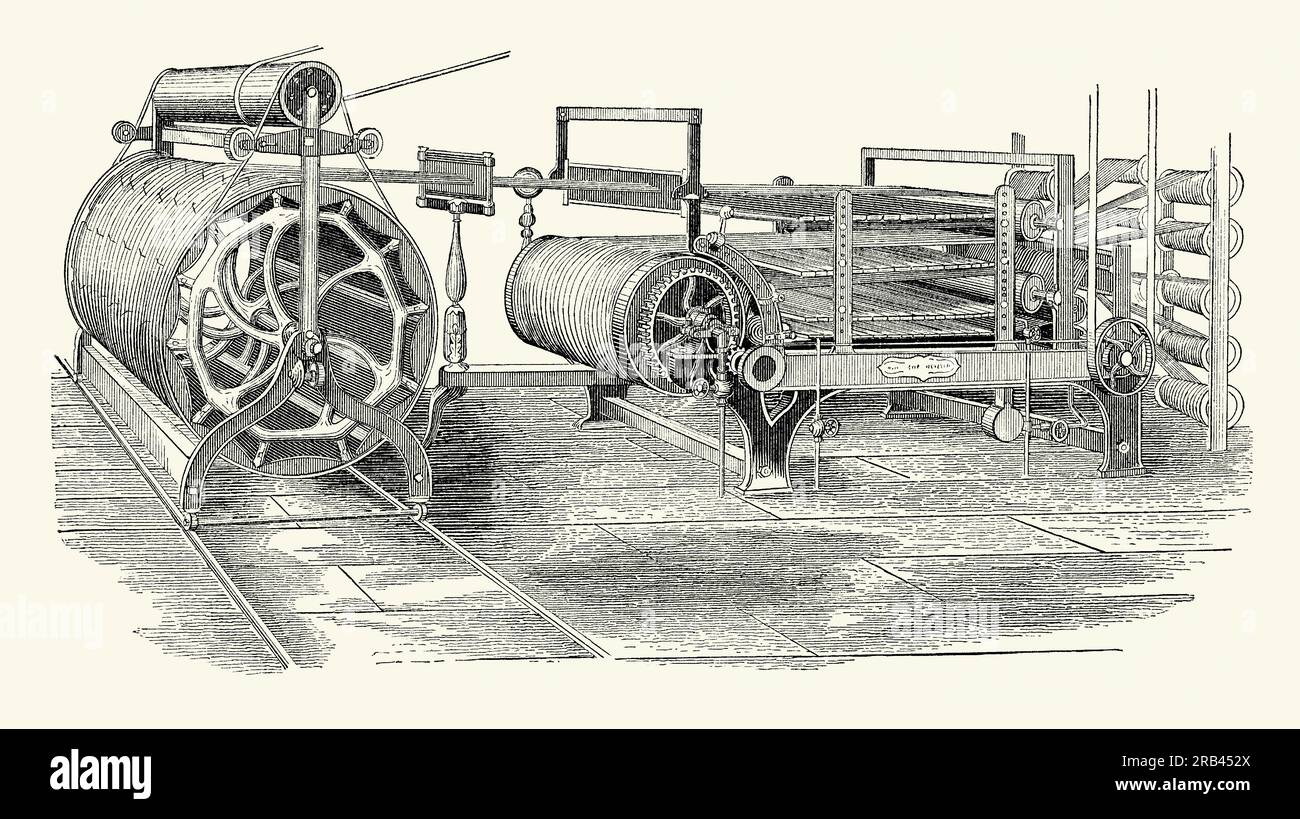 An old engraving of a yarn dresser and reel machine used in the textile mills of the 1800s. It is from a Victorian mechanical engineering book of the 1880s. This machine was used for sizing and polishing yarn. Using size (a starch for cotton) reduces the chances of threads fraying and breaking due to the friction of the weaving process. Belt-driven rollers deliver the yarn through a series of devices that ‘whip’ or brush it, removing unwanted strands and give it a polish. It then passes over steam pipes, then wound onto reels or bobbins (right), ready for weaving. Stock Photohttps://www.alamy.com/image-license-details/?v=1https://www.alamy.com/an-old-engraving-of-a-yarn-dresser-and-reel-machine-used-in-the-textile-mills-of-the-1800s-it-is-from-a-victorian-mechanical-engineering-book-of-the-1880s-this-machine-was-used-for-sizing-and-polishing-yarn-using-size-a-starch-for-cotton-reduces-the-chances-of-threads-fraying-and-breaking-due-to-the-friction-of-the-weaving-process-belt-driven-rollers-deliver-the-yarn-through-a-series-of-devices-that-whip-or-brush-it-removing-unwanted-strands-and-give-it-a-polish-it-then-passes-over-steam-pipes-then-wound-onto-reels-or-bobbins-right-ready-for-weaving-image557584802.html
An old engraving of a yarn dresser and reel machine used in the textile mills of the 1800s. It is from a Victorian mechanical engineering book of the 1880s. This machine was used for sizing and polishing yarn. Using size (a starch for cotton) reduces the chances of threads fraying and breaking due to the friction of the weaving process. Belt-driven rollers deliver the yarn through a series of devices that ‘whip’ or brush it, removing unwanted strands and give it a polish. It then passes over steam pipes, then wound onto reels or bobbins (right), ready for weaving. Stock Photohttps://www.alamy.com/image-license-details/?v=1https://www.alamy.com/an-old-engraving-of-a-yarn-dresser-and-reel-machine-used-in-the-textile-mills-of-the-1800s-it-is-from-a-victorian-mechanical-engineering-book-of-the-1880s-this-machine-was-used-for-sizing-and-polishing-yarn-using-size-a-starch-for-cotton-reduces-the-chances-of-threads-fraying-and-breaking-due-to-the-friction-of-the-weaving-process-belt-driven-rollers-deliver-the-yarn-through-a-series-of-devices-that-whip-or-brush-it-removing-unwanted-strands-and-give-it-a-polish-it-then-passes-over-steam-pipes-then-wound-onto-reels-or-bobbins-right-ready-for-weaving-image557584802.htmlRM2RB452X–An old engraving of a yarn dresser and reel machine used in the textile mills of the 1800s. It is from a Victorian mechanical engineering book of the 1880s. This machine was used for sizing and polishing yarn. Using size (a starch for cotton) reduces the chances of threads fraying and breaking due to the friction of the weaving process. Belt-driven rollers deliver the yarn through a series of devices that ‘whip’ or brush it, removing unwanted strands and give it a polish. It then passes over steam pipes, then wound onto reels or bobbins (right), ready for weaving.
 R. Hoe & Co.s sextuple stereotype perfecting printing press with folders, vintage illustration from 1894 Stock Photohttps://www.alamy.com/image-license-details/?v=1https://www.alamy.com/r-hoe-cos-sextuple-stereotype-perfecting-printing-press-with-folders-vintage-illustration-from-1894-image396742981.html
R. Hoe & Co.s sextuple stereotype perfecting printing press with folders, vintage illustration from 1894 Stock Photohttps://www.alamy.com/image-license-details/?v=1https://www.alamy.com/r-hoe-cos-sextuple-stereotype-perfecting-printing-press-with-folders-vintage-illustration-from-1894-image396742981.htmlRM2E1D5M5–R. Hoe & Co.s sextuple stereotype perfecting printing press with folders, vintage illustration from 1894
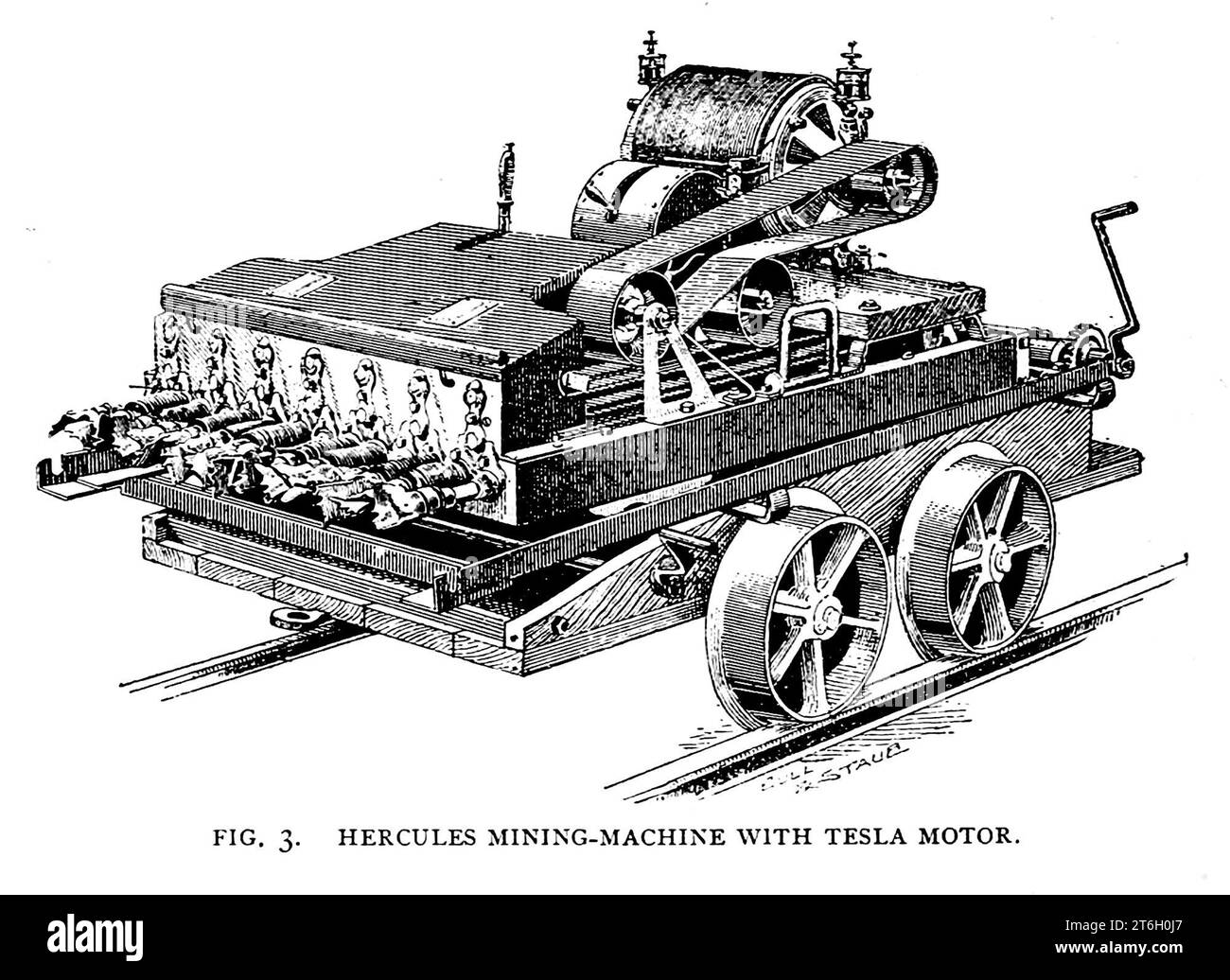 HERCULES MINING-MACHINE WITH TESLA MOTOR from the Article THE WONDERFUL EXPANSION IN THE USE OF ELECTRIC POWER. By Louis Bell from The Engineering Magazine DEVOTED TO INDUSTRIAL PROGRESS Volume XII October 1896 to March 1897 The Engineering Magazine Co Stock Photohttps://www.alamy.com/image-license-details/?v=1https://www.alamy.com/hercules-mining-machine-with-tesla-motor-from-the-article-the-wonderful-expansion-in-the-use-of-electric-power-by-louis-bell-from-the-engineering-magazine-devoted-to-industrial-progress-volume-xii-october-1896-to-march-1897-the-engineering-magazine-co-image572003775.html
HERCULES MINING-MACHINE WITH TESLA MOTOR from the Article THE WONDERFUL EXPANSION IN THE USE OF ELECTRIC POWER. By Louis Bell from The Engineering Magazine DEVOTED TO INDUSTRIAL PROGRESS Volume XII October 1896 to March 1897 The Engineering Magazine Co Stock Photohttps://www.alamy.com/image-license-details/?v=1https://www.alamy.com/hercules-mining-machine-with-tesla-motor-from-the-article-the-wonderful-expansion-in-the-use-of-electric-power-by-louis-bell-from-the-engineering-magazine-devoted-to-industrial-progress-volume-xii-october-1896-to-march-1897-the-engineering-magazine-co-image572003775.htmlRF2T6H0J7–HERCULES MINING-MACHINE WITH TESLA MOTOR from the Article THE WONDERFUL EXPANSION IN THE USE OF ELECTRIC POWER. By Louis Bell from The Engineering Magazine DEVOTED TO INDUSTRIAL PROGRESS Volume XII October 1896 to March 1897 The Engineering Magazine Co
 Steam stretch and calender dry machine for textile industry. Calender is a series of hard pressure rollers used to form or smooth a sheet of material such as fabric, also used for paper. Stock Photohttps://www.alamy.com/image-license-details/?v=1https://www.alamy.com/stock-photo-steam-stretch-and-calender-dry-machine-for-textile-industry-calender-89088445.html
Steam stretch and calender dry machine for textile industry. Calender is a series of hard pressure rollers used to form or smooth a sheet of material such as fabric, also used for paper. Stock Photohttps://www.alamy.com/image-license-details/?v=1https://www.alamy.com/stock-photo-steam-stretch-and-calender-dry-machine-for-textile-industry-calender-89088445.htmlRFF4X965–Steam stretch and calender dry machine for textile industry. Calender is a series of hard pressure rollers used to form or smooth a sheet of material such as fabric, also used for paper.
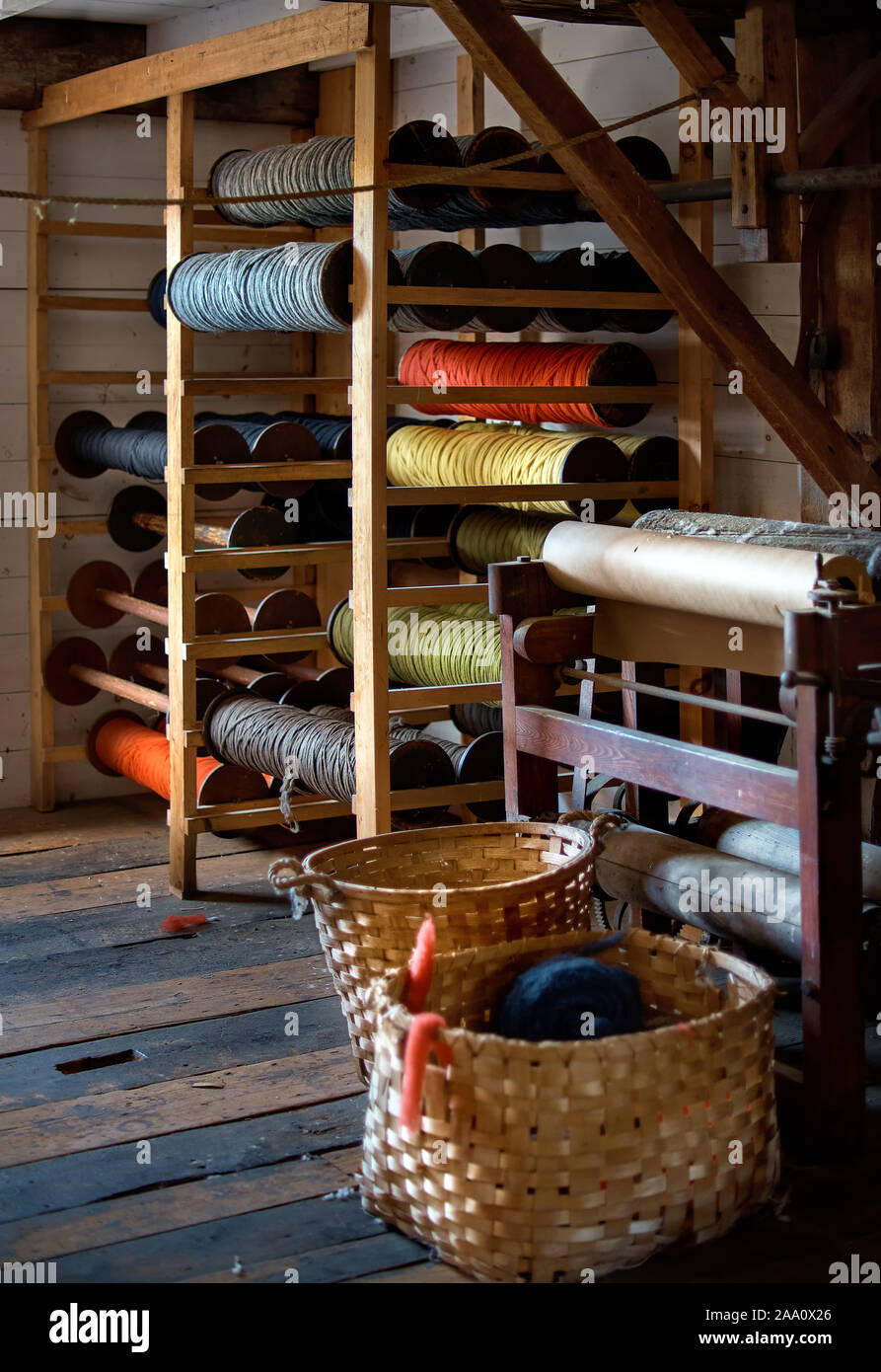 colored woolen threads on an old loom, Traditional Yarn in Canada. Close up Stock Photohttps://www.alamy.com/image-license-details/?v=1https://www.alamy.com/colored-woolen-threads-on-an-old-loom-traditional-yarn-in-canada-close-up-image333163998.html
colored woolen threads on an old loom, Traditional Yarn in Canada. Close up Stock Photohttps://www.alamy.com/image-license-details/?v=1https://www.alamy.com/colored-woolen-threads-on-an-old-loom-traditional-yarn-in-canada-close-up-image333163998.htmlRF2AA0X26–colored woolen threads on an old loom, Traditional Yarn in Canada. Close up
 Wood barrel assembly machine. Old 19th century engraving from La Nature 1887 Stock Photohttps://www.alamy.com/image-license-details/?v=1https://www.alamy.com/wood-barrel-assembly-machine-old-19th-century-engraving-from-la-nature-1887-image550985956.html
Wood barrel assembly machine. Old 19th century engraving from La Nature 1887 Stock Photohttps://www.alamy.com/image-license-details/?v=1https://www.alamy.com/wood-barrel-assembly-machine-old-19th-century-engraving-from-la-nature-1887-image550985956.htmlRM2R0BG5T–Wood barrel assembly machine. Old 19th century engraving from La Nature 1887
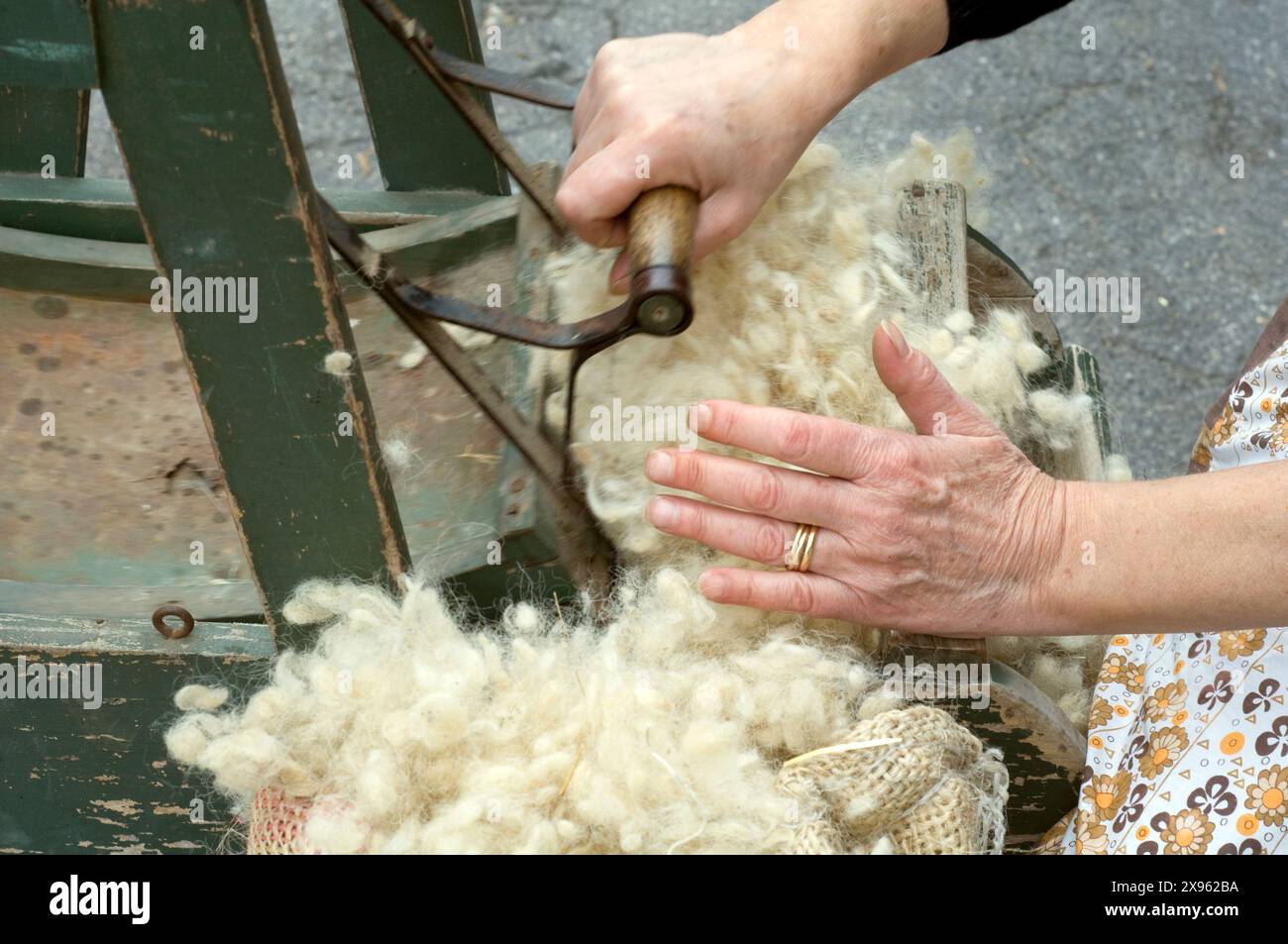 Italy, Lombardy, Old Carding Wool Stock Photohttps://www.alamy.com/image-license-details/?v=1https://www.alamy.com/italy-lombardy-old-carding-wool-image608028382.html
Italy, Lombardy, Old Carding Wool Stock Photohttps://www.alamy.com/image-license-details/?v=1https://www.alamy.com/italy-lombardy-old-carding-wool-image608028382.htmlRM2X962BA–Italy, Lombardy, Old Carding Wool
 Weighing cotton for export for the English market ; Bombay ; Mumbai ; Maharashtra ; India ; Asia ; old vintage 1800s engraving Stock Photohttps://www.alamy.com/image-license-details/?v=1https://www.alamy.com/stock-photo-weighing-cotton-for-export-for-the-english-market-bombay-mumbai-maharashtra-83597148.html
Weighing cotton for export for the English market ; Bombay ; Mumbai ; Maharashtra ; India ; Asia ; old vintage 1800s engraving Stock Photohttps://www.alamy.com/image-license-details/?v=1https://www.alamy.com/stock-photo-weighing-cotton-for-export-for-the-english-market-bombay-mumbai-maharashtra-83597148.htmlRMET050C–Weighing cotton for export for the English market ; Bombay ; Mumbai ; Maharashtra ; India ; Asia ; old vintage 1800s engraving
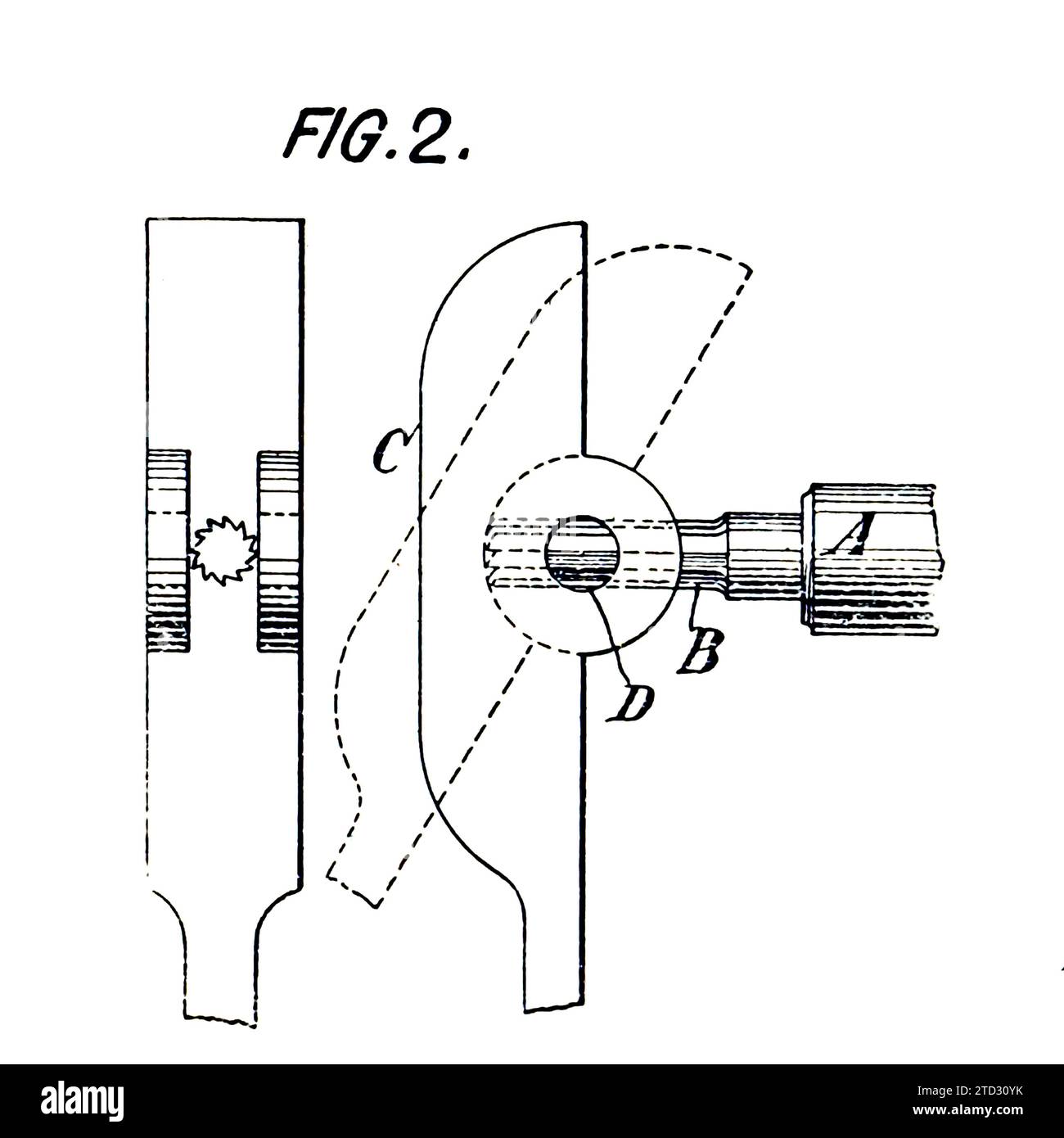 Illustration of a lathe. From 'Economy in Machine Shop Management' by James Brady from The Engineering Magazine, Volume VIII, 1895. Stock Photohttps://www.alamy.com/image-license-details/?v=1https://www.alamy.com/illustration-of-a-lathe-from-economy-in-machine-shop-management-by-james-brady-from-the-engineering-magazine-volume-viii-1895-image575999303.html
Illustration of a lathe. From 'Economy in Machine Shop Management' by James Brady from The Engineering Magazine, Volume VIII, 1895. Stock Photohttps://www.alamy.com/image-license-details/?v=1https://www.alamy.com/illustration-of-a-lathe-from-economy-in-machine-shop-management-by-james-brady-from-the-engineering-magazine-volume-viii-1895-image575999303.htmlRF2TD30YK–Illustration of a lathe. From 'Economy in Machine Shop Management' by James Brady from The Engineering Magazine, Volume VIII, 1895.
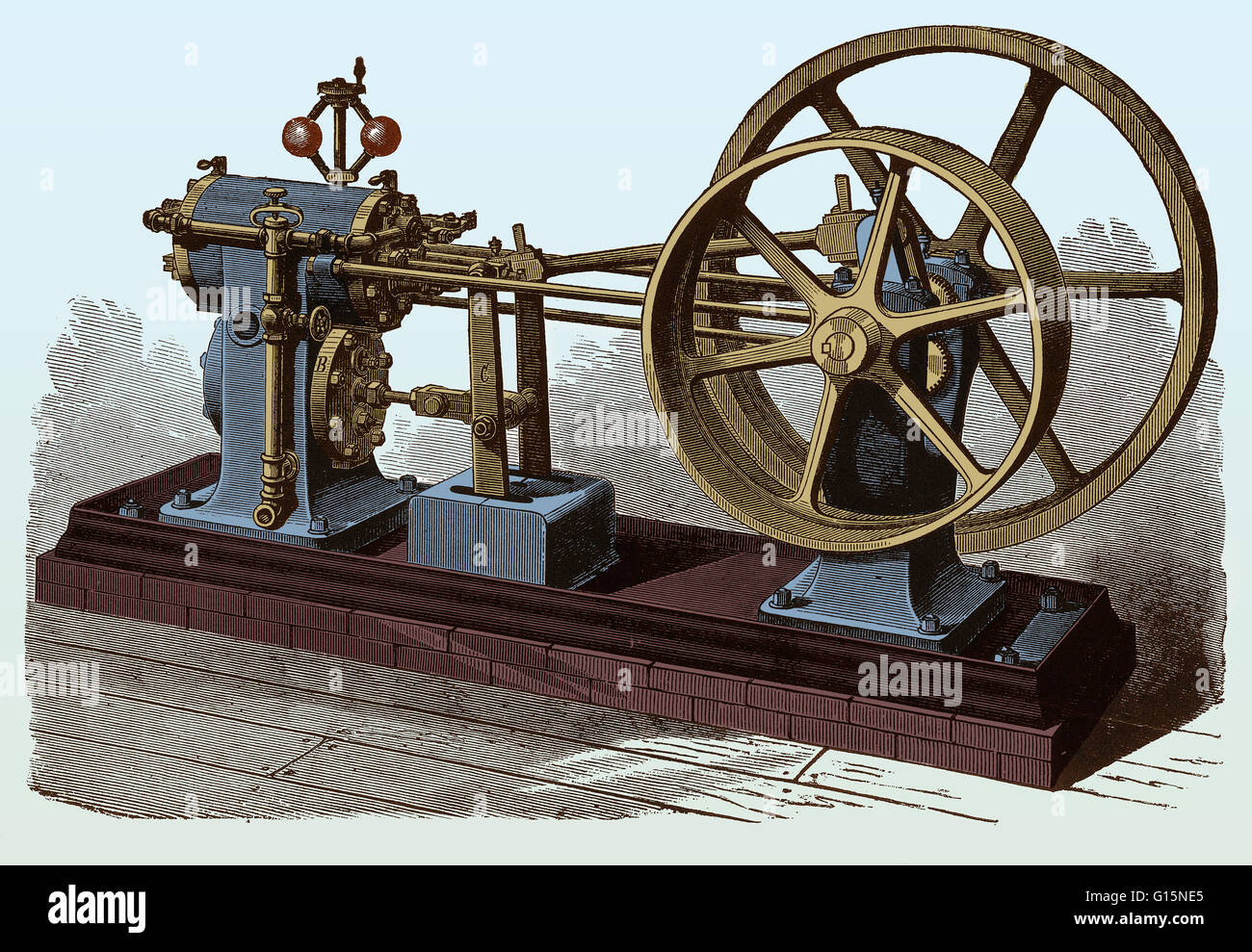 An illustration of the Brayton Hydrocarbon Engine, created by the American mechanical engineer George Brayton (1830 - 1892). Stock Photohttps://www.alamy.com/image-license-details/?v=1https://www.alamy.com/stock-photo-an-illustration-of-the-brayton-hydrocarbon-engine-created-by-the-american-104003485.html
An illustration of the Brayton Hydrocarbon Engine, created by the American mechanical engineer George Brayton (1830 - 1892). Stock Photohttps://www.alamy.com/image-license-details/?v=1https://www.alamy.com/stock-photo-an-illustration-of-the-brayton-hydrocarbon-engine-created-by-the-american-104003485.htmlRMG15NE5–An illustration of the Brayton Hydrocarbon Engine, created by the American mechanical engineer George Brayton (1830 - 1892).
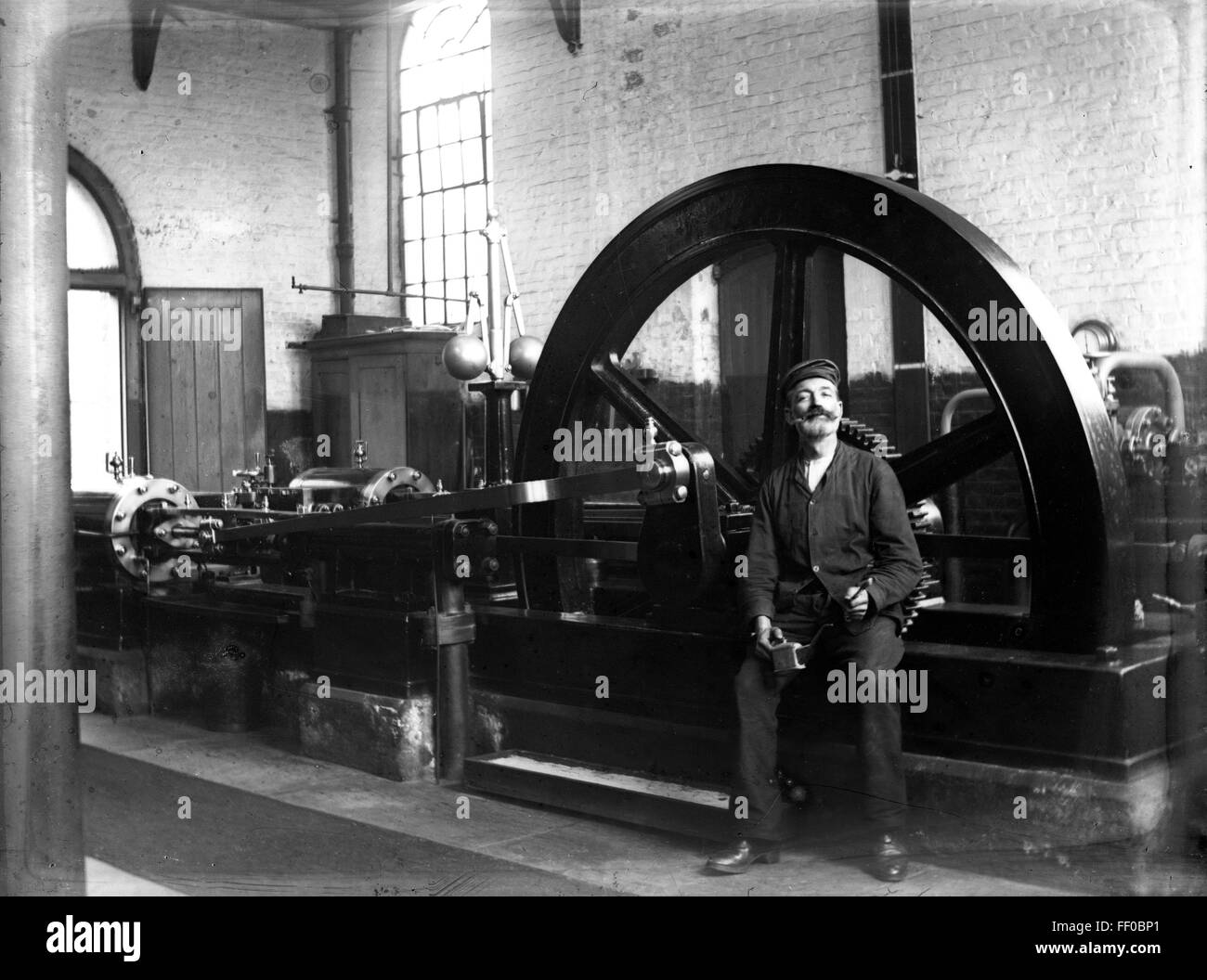 Victorian steam engine pump and engineer mechanic workman 1898 Stock Photohttps://www.alamy.com/image-license-details/?v=1https://www.alamy.com/stock-photo-victorian-steam-engine-pump-and-engineer-mechanic-workman-1898-95280921.html
Victorian steam engine pump and engineer mechanic workman 1898 Stock Photohttps://www.alamy.com/image-license-details/?v=1https://www.alamy.com/stock-photo-victorian-steam-engine-pump-and-engineer-mechanic-workman-1898-95280921.htmlRMFF0BP1–Victorian steam engine pump and engineer mechanic workman 1898
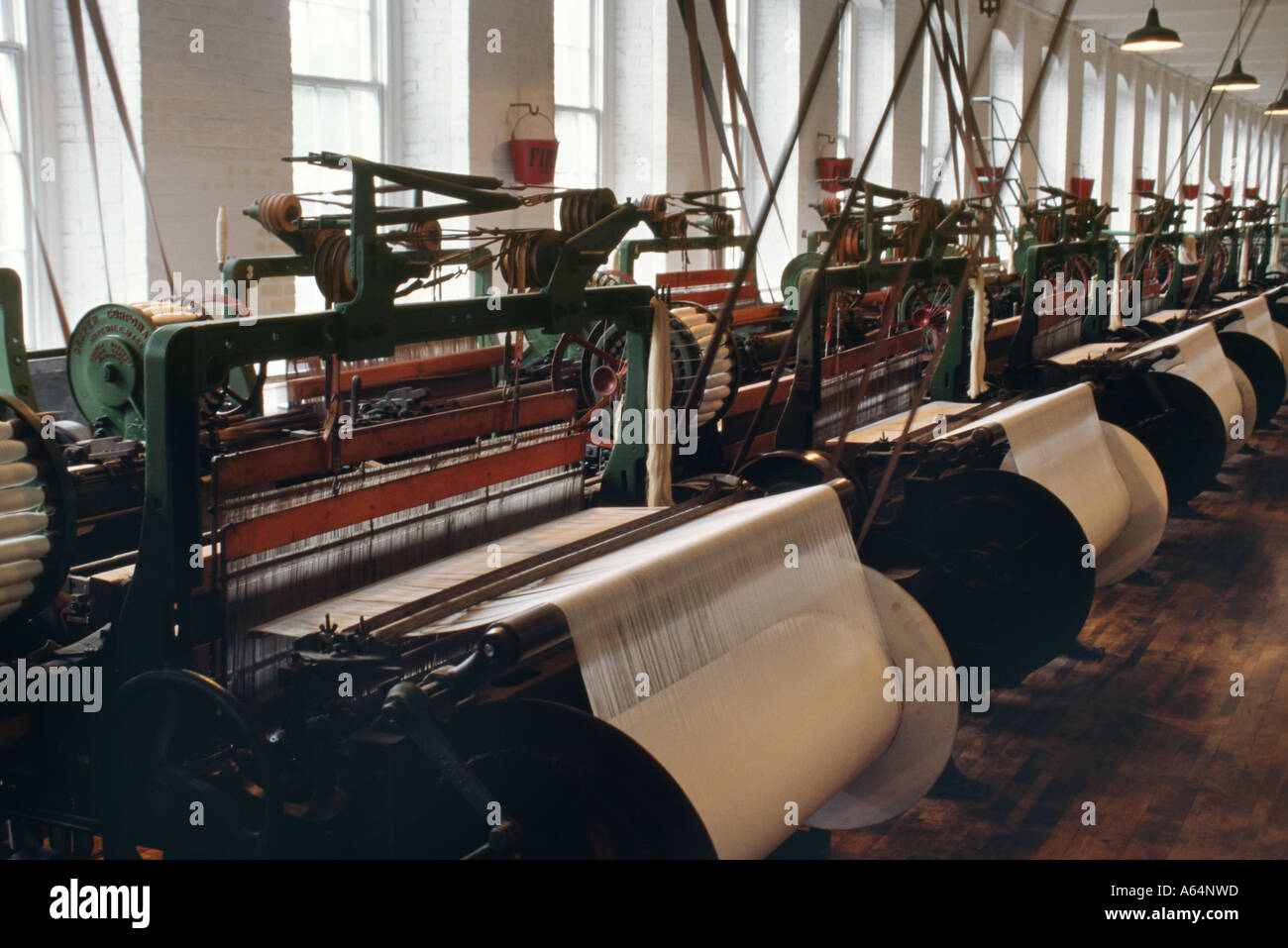 Power looms inside the Boott Cotton Mills at Lowell National Historical Park Massachusetts. Photograph Stock Photohttps://www.alamy.com/image-license-details/?v=1https://www.alamy.com/power-looms-inside-the-boott-cotton-mills-at-lowell-national-historical-image6548572.html
Power looms inside the Boott Cotton Mills at Lowell National Historical Park Massachusetts. Photograph Stock Photohttps://www.alamy.com/image-license-details/?v=1https://www.alamy.com/power-looms-inside-the-boott-cotton-mills-at-lowell-national-historical-image6548572.htmlRMA64NWD–Power looms inside the Boott Cotton Mills at Lowell National Historical Park Massachusetts. Photograph
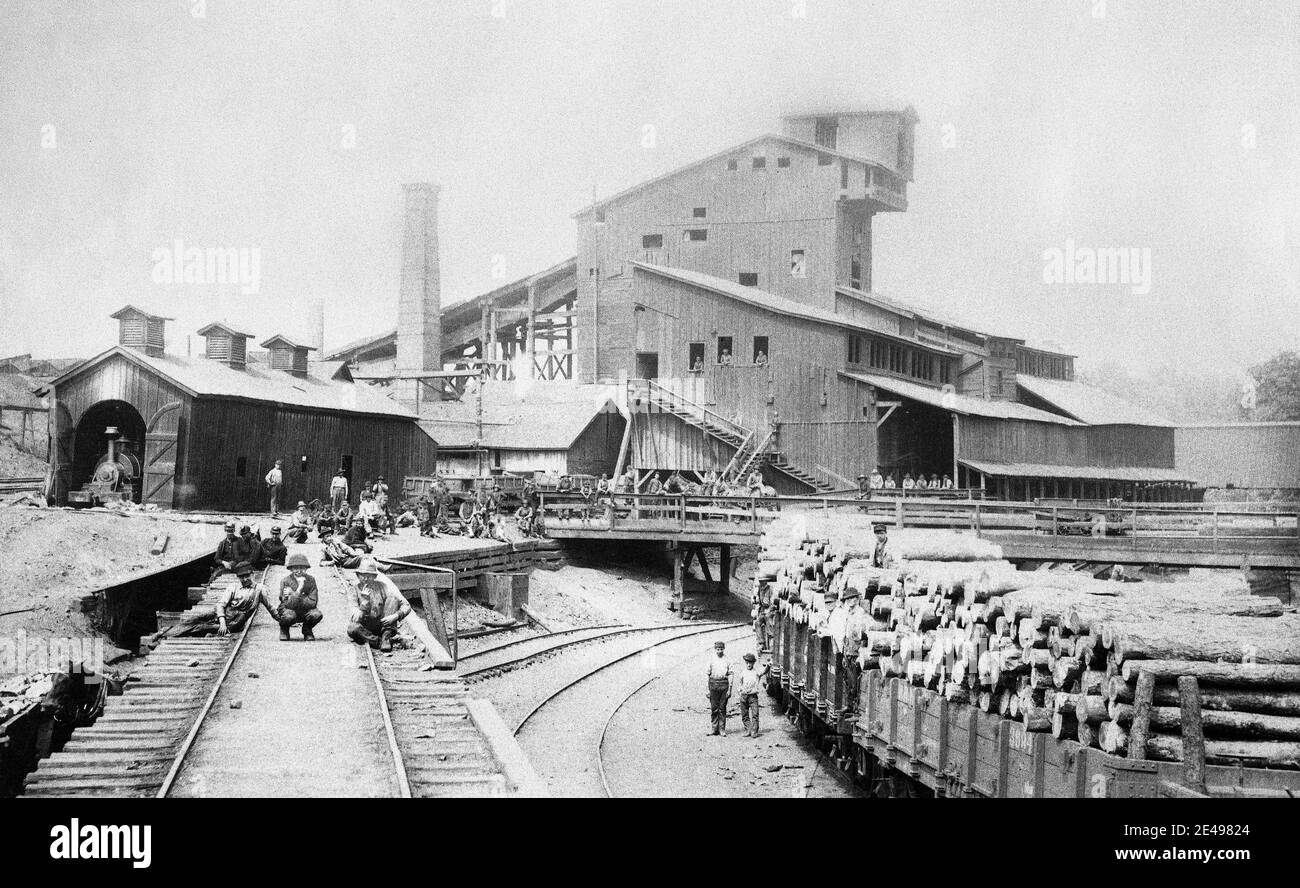 This is an unknown Anthracite coal breaker in Nanticoke Pennsylvania. Late 1800s. Nanticoke is a town in the anthracite coal regions of North Eastern Pennsylvania, USA. Stock Photohttps://www.alamy.com/image-license-details/?v=1https://www.alamy.com/this-is-an-unknown-anthracite-coal-breaker-in-nanticoke-pennsylvania-late-1800s-nanticoke-is-a-town-in-the-anthracite-coal-regions-of-north-eastern-pennsylvania-usa-image398500988.html
This is an unknown Anthracite coal breaker in Nanticoke Pennsylvania. Late 1800s. Nanticoke is a town in the anthracite coal regions of North Eastern Pennsylvania, USA. Stock Photohttps://www.alamy.com/image-license-details/?v=1https://www.alamy.com/this-is-an-unknown-anthracite-coal-breaker-in-nanticoke-pennsylvania-late-1800s-nanticoke-is-a-town-in-the-anthracite-coal-regions-of-north-eastern-pennsylvania-usa-image398500988.htmlRM2E49824–This is an unknown Anthracite coal breaker in Nanticoke Pennsylvania. Late 1800s. Nanticoke is a town in the anthracite coal regions of North Eastern Pennsylvania, USA.
 The Old Furniture Factory, Art Music and Community Center, 6 West Loudoun Street, Round Hill, Virginia Stock Photohttps://www.alamy.com/image-license-details/?v=1https://www.alamy.com/stock-photo-the-old-furniture-factory-art-music-and-community-center-6-west-loudoun-113662809.html
The Old Furniture Factory, Art Music and Community Center, 6 West Loudoun Street, Round Hill, Virginia Stock Photohttps://www.alamy.com/image-license-details/?v=1https://www.alamy.com/stock-photo-the-old-furniture-factory-art-music-and-community-center-6-west-loudoun-113662809.htmlRMGGWP21–The Old Furniture Factory, Art Music and Community Center, 6 West Loudoun Street, Round Hill, Virginia
 South Carolina Cotton Museum in Bishopville SC USA Stock Photohttps://www.alamy.com/image-license-details/?v=1https://www.alamy.com/south-carolina-cotton-museum-in-bishopville-sc-usa-image2557302.html
South Carolina Cotton Museum in Bishopville SC USA Stock Photohttps://www.alamy.com/image-license-details/?v=1https://www.alamy.com/south-carolina-cotton-museum-in-bishopville-sc-usa-image2557302.htmlRMAET577–South Carolina Cotton Museum in Bishopville SC USA
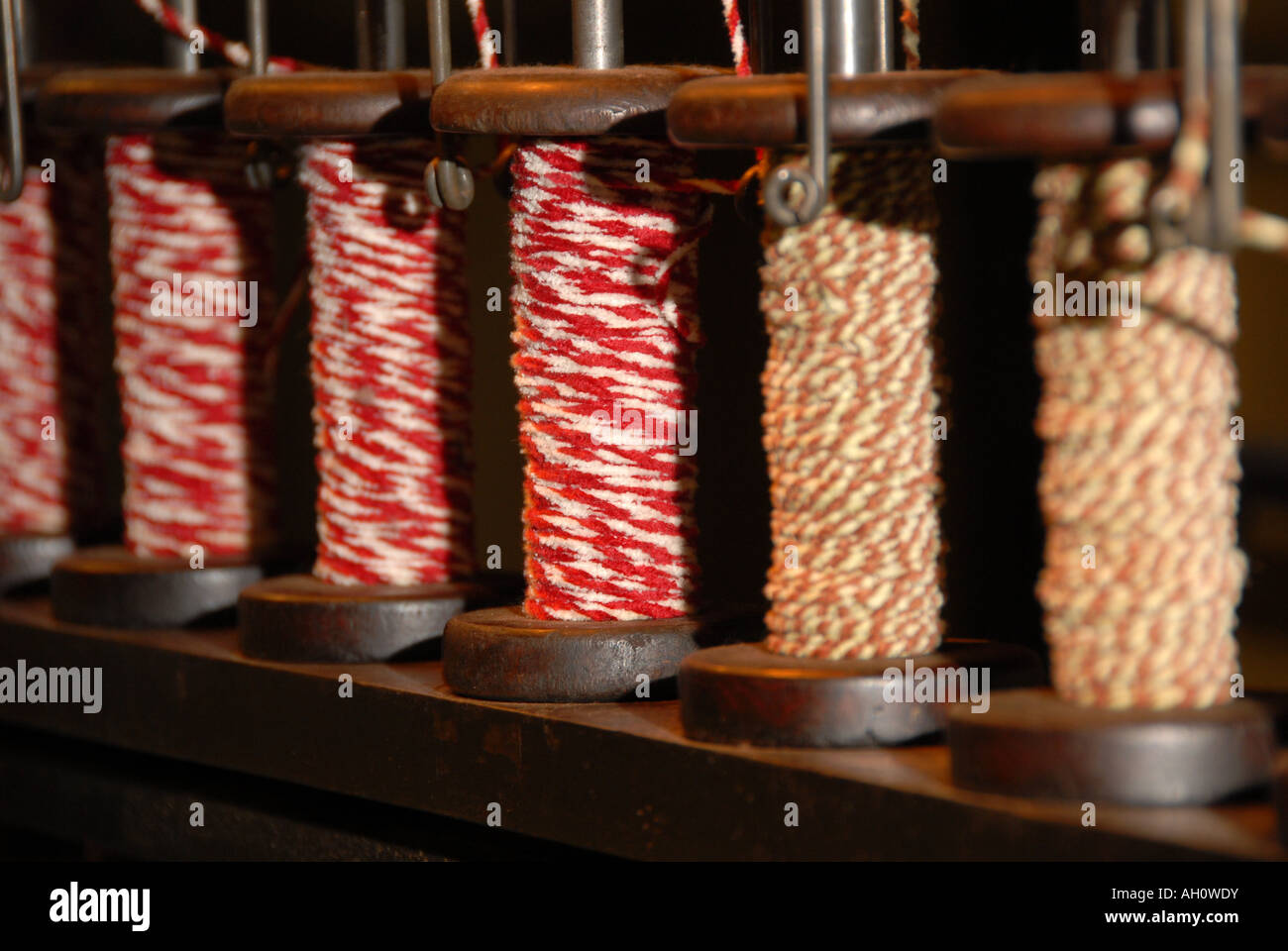 Spindles with yarn ready for use in Lowell weaving millls Stock Photohttps://www.alamy.com/image-license-details/?v=1https://www.alamy.com/stock-photo-spindles-with-yarn-ready-for-use-in-lowell-weaving-millls-14321270.html
Spindles with yarn ready for use in Lowell weaving millls Stock Photohttps://www.alamy.com/image-license-details/?v=1https://www.alamy.com/stock-photo-spindles-with-yarn-ready-for-use-in-lowell-weaving-millls-14321270.htmlRMAH0WDY–Spindles with yarn ready for use in Lowell weaving millls
 Engraving of a circular loom; used for putting an embroidered edge on fabric Stock Photohttps://www.alamy.com/image-license-details/?v=1https://www.alamy.com/engraving-of-a-circular-loom-used-for-putting-an-embroidered-edge-on-fabric-image454135678.html
Engraving of a circular loom; used for putting an embroidered edge on fabric Stock Photohttps://www.alamy.com/image-license-details/?v=1https://www.alamy.com/engraving-of-a-circular-loom-used-for-putting-an-embroidered-edge-on-fabric-image454135678.htmlRM2HARJKA–Engraving of a circular loom; used for putting an embroidered edge on fabric
 Engraving of a loom from 1890 Stock Photohttps://www.alamy.com/image-license-details/?v=1https://www.alamy.com/engraving-of-a-loom-from-1890-image454135674.html
Engraving of a loom from 1890 Stock Photohttps://www.alamy.com/image-license-details/?v=1https://www.alamy.com/engraving-of-a-loom-from-1890-image454135674.htmlRM2HARJK6–Engraving of a loom from 1890
 An old engraving of a warp beaming machine (warper) used in the textile mills of the 1800s. It is from a Victorian mechanical engineering book of the 1880s. This device prepares the warp through ‘warping’. This process consists in placing reels – cotton or silk threads – in a creel (centre). This holds the cross-wound, rotating bobbins. The threads are pulled through guides and then inserted into the comb of the winding machine and attached to the warp beam. The rotating warp beam unwinds thread from the bobbins onto the warp beam, collected and wound up side by side. Stock Photohttps://www.alamy.com/image-license-details/?v=1https://www.alamy.com/an-old-engraving-of-a-warp-beaming-machine-warper-used-in-the-textile-mills-of-the-1800s-it-is-from-a-victorian-mechanical-engineering-book-of-the-1880s-this-device-prepares-the-warp-through-warping-this-process-consists-in-placing-reels-cotton-or-silk-threads-in-a-creel-centre-this-holds-the-cross-wound-rotating-bobbins-the-threads-are-pulled-through-guides-and-then-inserted-into-the-comb-of-the-winding-machine-and-attached-to-the-warp-beam-the-rotating-warp-beam-unwinds-thread-from-the-bobbins-onto-the-warp-beam-collected-and-wound-up-side-by-side-image557584743.html
An old engraving of a warp beaming machine (warper) used in the textile mills of the 1800s. It is from a Victorian mechanical engineering book of the 1880s. This device prepares the warp through ‘warping’. This process consists in placing reels – cotton or silk threads – in a creel (centre). This holds the cross-wound, rotating bobbins. The threads are pulled through guides and then inserted into the comb of the winding machine and attached to the warp beam. The rotating warp beam unwinds thread from the bobbins onto the warp beam, collected and wound up side by side. Stock Photohttps://www.alamy.com/image-license-details/?v=1https://www.alamy.com/an-old-engraving-of-a-warp-beaming-machine-warper-used-in-the-textile-mills-of-the-1800s-it-is-from-a-victorian-mechanical-engineering-book-of-the-1880s-this-device-prepares-the-warp-through-warping-this-process-consists-in-placing-reels-cotton-or-silk-threads-in-a-creel-centre-this-holds-the-cross-wound-rotating-bobbins-the-threads-are-pulled-through-guides-and-then-inserted-into-the-comb-of-the-winding-machine-and-attached-to-the-warp-beam-the-rotating-warp-beam-unwinds-thread-from-the-bobbins-onto-the-warp-beam-collected-and-wound-up-side-by-side-image557584743.htmlRM2RB450R–An old engraving of a warp beaming machine (warper) used in the textile mills of the 1800s. It is from a Victorian mechanical engineering book of the 1880s. This device prepares the warp through ‘warping’. This process consists in placing reels – cotton or silk threads – in a creel (centre). This holds the cross-wound, rotating bobbins. The threads are pulled through guides and then inserted into the comb of the winding machine and attached to the warp beam. The rotating warp beam unwinds thread from the bobbins onto the warp beam, collected and wound up side by side.
 Engraving of women repairing lace curtains, circa 1880 Stock Photohttps://www.alamy.com/image-license-details/?v=1https://www.alamy.com/engraving-of-women-repairing-lace-curtains-circa-1880-image537037984.html
Engraving of women repairing lace curtains, circa 1880 Stock Photohttps://www.alamy.com/image-license-details/?v=1https://www.alamy.com/engraving-of-women-repairing-lace-curtains-circa-1880-image537037984.htmlRM2P5M5C0–Engraving of women repairing lace curtains, circa 1880
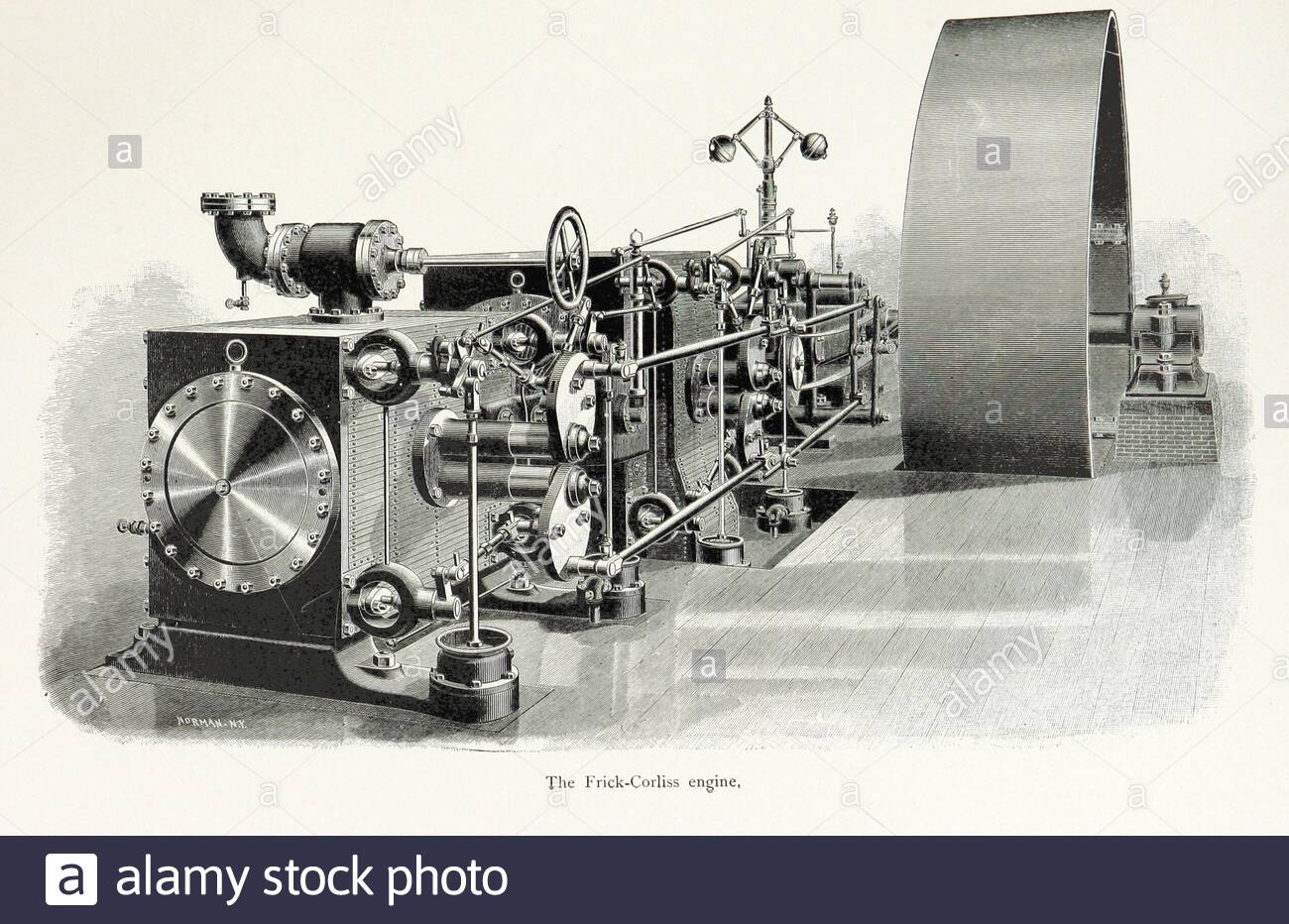 Frick Corliss steam engine, vintage illustration from 1894 Stock Photohttps://www.alamy.com/image-license-details/?v=1https://www.alamy.com/frick-corliss-steam-engine-vintage-illustration-from-1894-image396742984.html
Frick Corliss steam engine, vintage illustration from 1894 Stock Photohttps://www.alamy.com/image-license-details/?v=1https://www.alamy.com/frick-corliss-steam-engine-vintage-illustration-from-1894-image396742984.htmlRM2E1D5M8–Frick Corliss steam engine, vintage illustration from 1894
 BALTIMORE AND OHIO ELECTRIC LOCOMOTIVE. from the Article THE WONDERFUL EXPANSION IN THE USE OF ELECTRIC POWER. By Louis Bell from The Engineering Magazine DEVOTED TO INDUSTRIAL PROGRESS Volume XII October 1896 to March 1897 The Engineering Magazine Co Stock Photohttps://www.alamy.com/image-license-details/?v=1https://www.alamy.com/baltimore-and-ohio-electric-locomotive-from-the-article-the-wonderful-expansion-in-the-use-of-electric-power-by-louis-bell-from-the-engineering-magazine-devoted-to-industrial-progress-volume-xii-october-1896-to-march-1897-the-engineering-magazine-co-image572003829.html
BALTIMORE AND OHIO ELECTRIC LOCOMOTIVE. from the Article THE WONDERFUL EXPANSION IN THE USE OF ELECTRIC POWER. By Louis Bell from The Engineering Magazine DEVOTED TO INDUSTRIAL PROGRESS Volume XII October 1896 to March 1897 The Engineering Magazine Co Stock Photohttps://www.alamy.com/image-license-details/?v=1https://www.alamy.com/baltimore-and-ohio-electric-locomotive-from-the-article-the-wonderful-expansion-in-the-use-of-electric-power-by-louis-bell-from-the-engineering-magazine-devoted-to-industrial-progress-volume-xii-october-1896-to-march-1897-the-engineering-magazine-co-image572003829.htmlRF2T6H0M5–BALTIMORE AND OHIO ELECTRIC LOCOMOTIVE. from the Article THE WONDERFUL EXPANSION IN THE USE OF ELECTRIC POWER. By Louis Bell from The Engineering Magazine DEVOTED TO INDUSTRIAL PROGRESS Volume XII October 1896 to March 1897 The Engineering Magazine Co
 Thomas Edison Multipolar Dynamo, vintage illustration from 1894 Stock Photohttps://www.alamy.com/image-license-details/?v=1https://www.alamy.com/thomas-edison-multipolar-dynamo-vintage-illustration-from-1894-image396995129.html
Thomas Edison Multipolar Dynamo, vintage illustration from 1894 Stock Photohttps://www.alamy.com/image-license-details/?v=1https://www.alamy.com/thomas-edison-multipolar-dynamo-vintage-illustration-from-1894-image396995129.htmlRM2E1TK9D–Thomas Edison Multipolar Dynamo, vintage illustration from 1894
 Machine for turning and beveling the bottoms of barrels. Old 19th century engraving from La Nature 1887 Stock Photohttps://www.alamy.com/image-license-details/?v=1https://www.alamy.com/machine-for-turning-and-beveling-the-bottoms-of-barrels-old-19th-century-engraving-from-la-nature-1887-image550985960.html
Machine for turning and beveling the bottoms of barrels. Old 19th century engraving from La Nature 1887 Stock Photohttps://www.alamy.com/image-license-details/?v=1https://www.alamy.com/machine-for-turning-and-beveling-the-bottoms-of-barrels-old-19th-century-engraving-from-la-nature-1887-image550985960.htmlRM2R0BG60–Machine for turning and beveling the bottoms of barrels. Old 19th century engraving from La Nature 1887
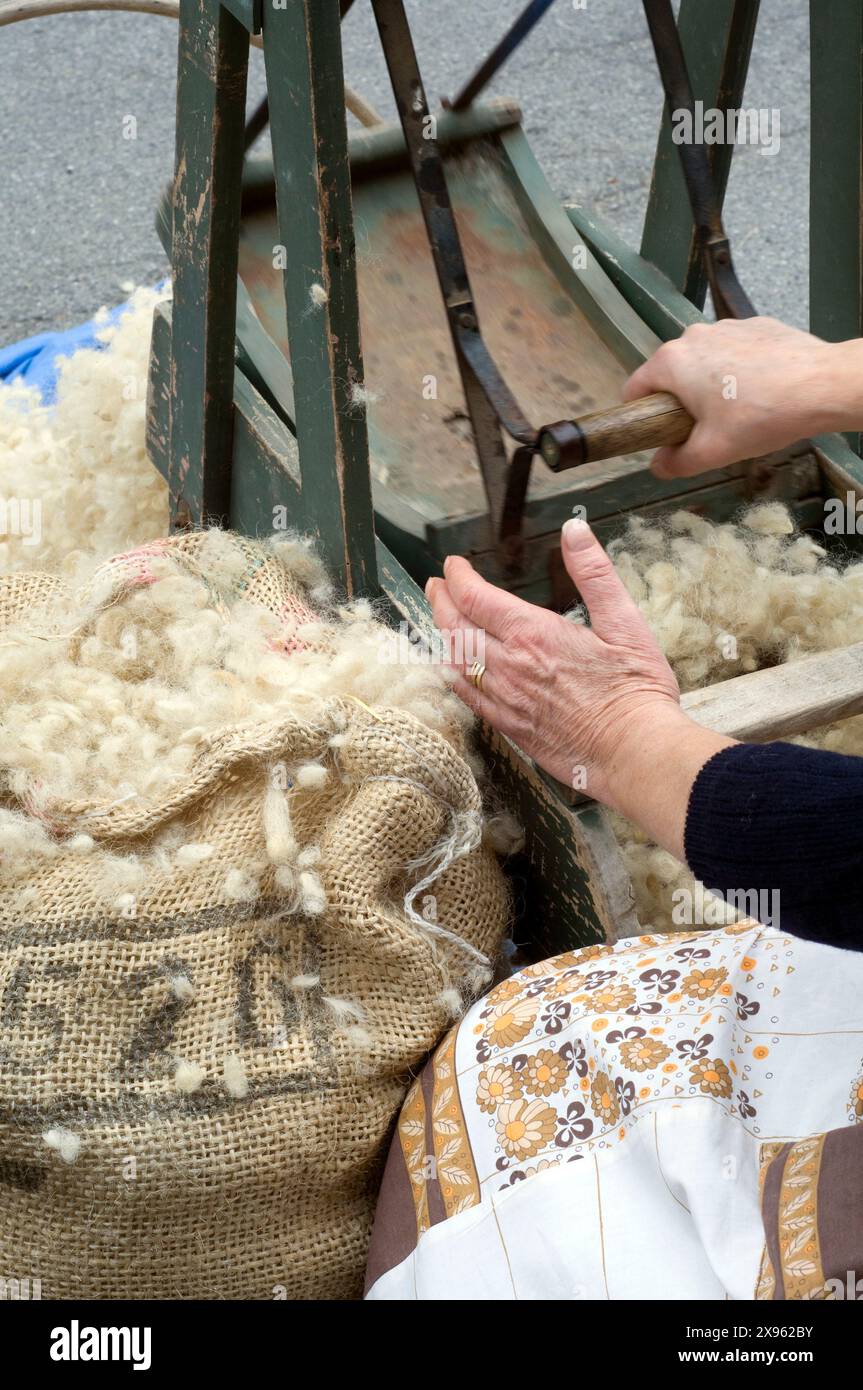 Italy, Lombardy, Old Carding Wool Stock Photohttps://www.alamy.com/image-license-details/?v=1https://www.alamy.com/italy-lombardy-old-carding-wool-image608028399.html
Italy, Lombardy, Old Carding Wool Stock Photohttps://www.alamy.com/image-license-details/?v=1https://www.alamy.com/italy-lombardy-old-carding-wool-image608028399.htmlRM2X962BY–Italy, Lombardy, Old Carding Wool
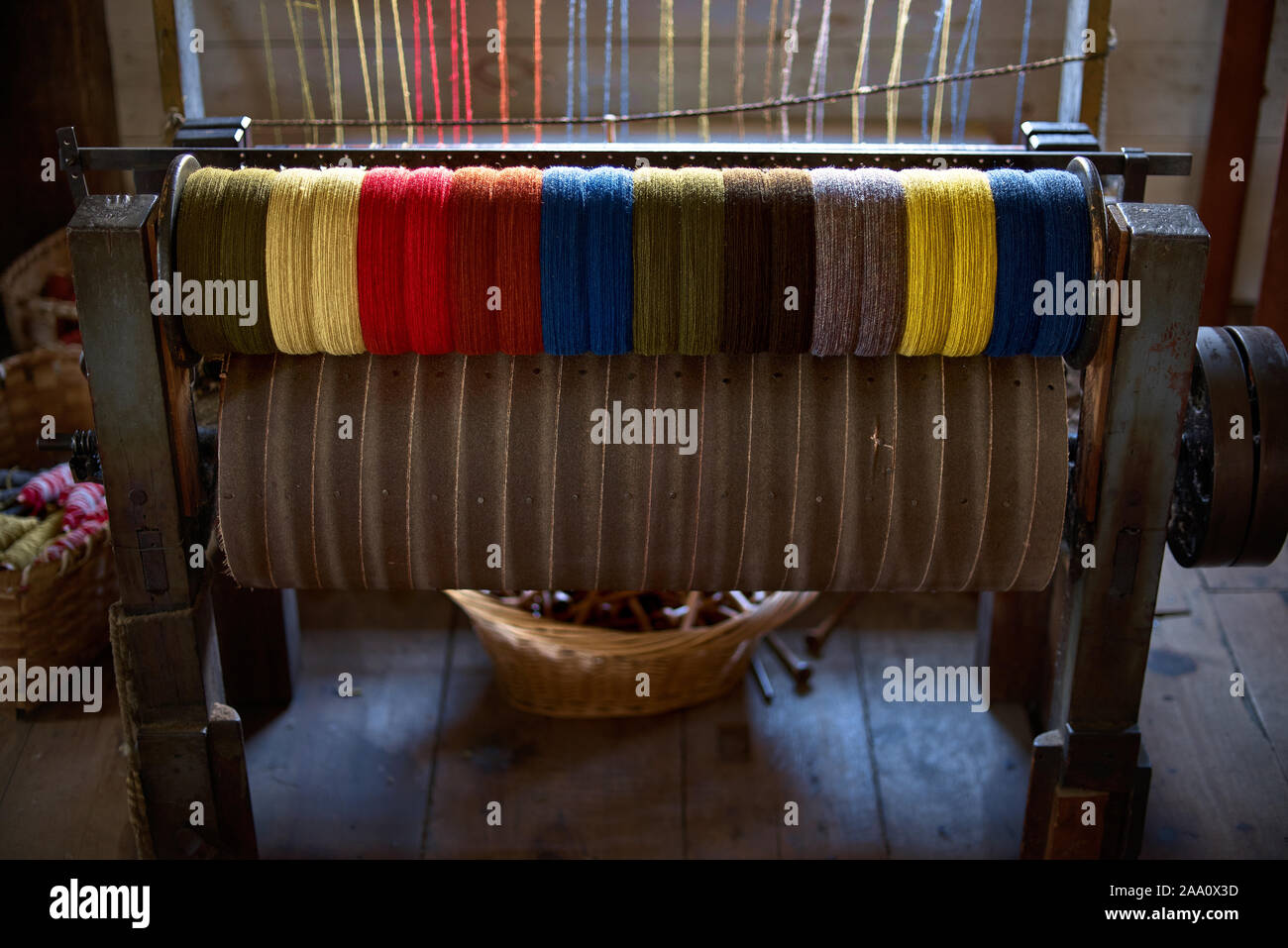 Spools of colored thread that were used in a woolen mill 1800's and early 1900's. colored woolen threads on an old loom, Traditional Yarn in Canada. Stock Photohttps://www.alamy.com/image-license-details/?v=1https://www.alamy.com/spools-of-colored-thread-that-were-used-in-a-woolen-mill-1800s-and-early-1900s-colored-woolen-threads-on-an-old-loom-traditional-yarn-in-canada-image333164033.html
Spools of colored thread that were used in a woolen mill 1800's and early 1900's. colored woolen threads on an old loom, Traditional Yarn in Canada. Stock Photohttps://www.alamy.com/image-license-details/?v=1https://www.alamy.com/spools-of-colored-thread-that-were-used-in-a-woolen-mill-1800s-and-early-1900s-colored-woolen-threads-on-an-old-loom-traditional-yarn-in-canada-image333164033.htmlRF2AA0X3D–Spools of colored thread that were used in a woolen mill 1800's and early 1900's. colored woolen threads on an old loom, Traditional Yarn in Canada.
 Illustration of a lathe. From 'Economy in Machine Shop Management' by James Brady from The Engineering Magazine, Volume VIII, 1895. Stock Photohttps://www.alamy.com/image-license-details/?v=1https://www.alamy.com/illustration-of-a-lathe-from-economy-in-machine-shop-management-by-james-brady-from-the-engineering-magazine-volume-viii-1895-image575999308.html
Illustration of a lathe. From 'Economy in Machine Shop Management' by James Brady from The Engineering Magazine, Volume VIII, 1895. Stock Photohttps://www.alamy.com/image-license-details/?v=1https://www.alamy.com/illustration-of-a-lathe-from-economy-in-machine-shop-management-by-james-brady-from-the-engineering-magazine-volume-viii-1895-image575999308.htmlRF2TD30YT–Illustration of a lathe. From 'Economy in Machine Shop Management' by James Brady from The Engineering Magazine, Volume VIII, 1895.
 Bigelow Stationary Engine, as seen at the Centennial Exposition of 1876. Stock Photohttps://www.alamy.com/image-license-details/?v=1https://www.alamy.com/stock-photo-bigelow-stationary-engine-as-seen-at-the-centennial-exposition-of-104003483.html
Bigelow Stationary Engine, as seen at the Centennial Exposition of 1876. Stock Photohttps://www.alamy.com/image-license-details/?v=1https://www.alamy.com/stock-photo-bigelow-stationary-engine-as-seen-at-the-centennial-exposition-of-104003483.htmlRMG15NE3–Bigelow Stationary Engine, as seen at the Centennial Exposition of 1876.
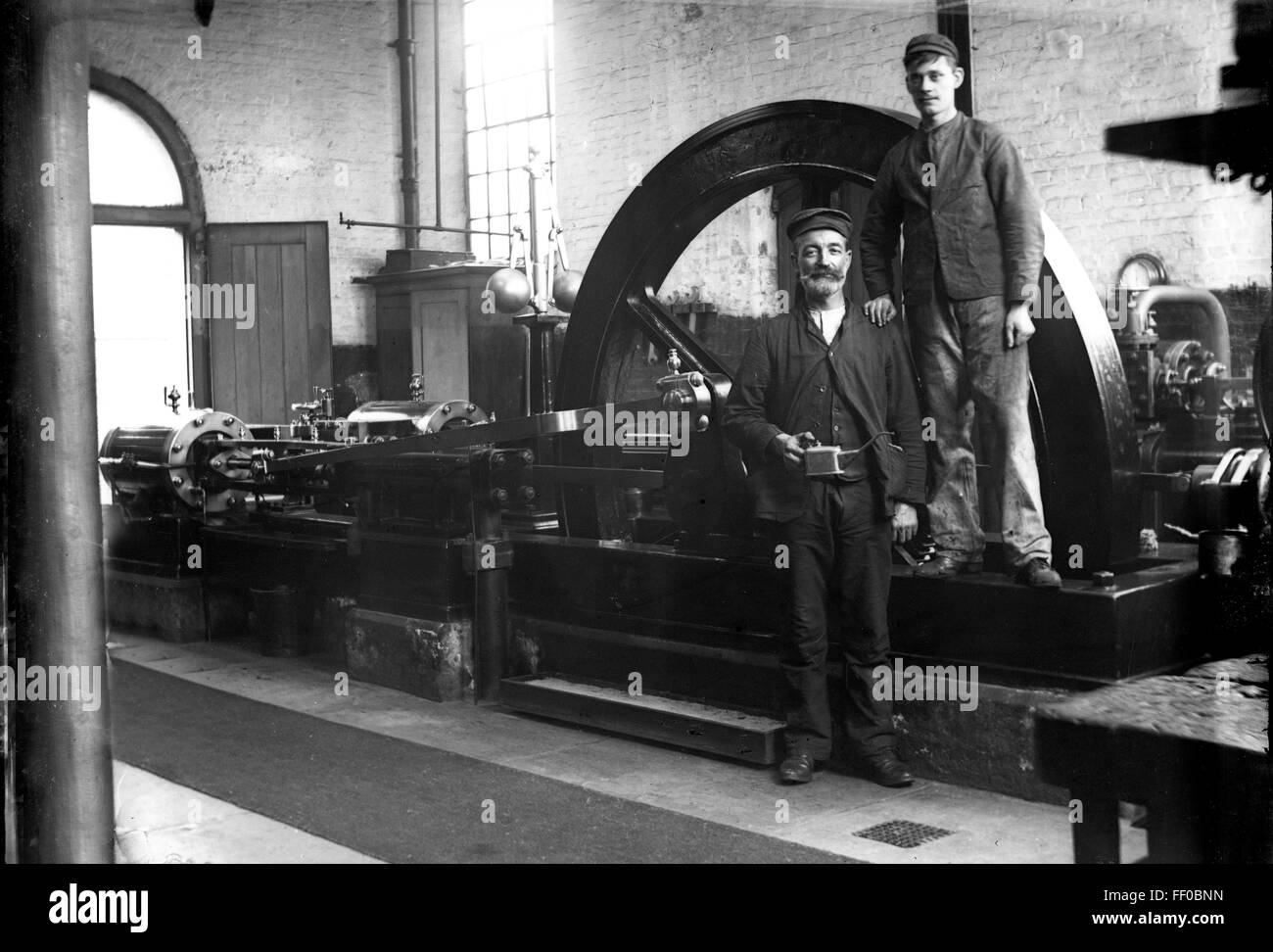 Victorian steam engine pump and engineer mechanic workman 1898 Stock Photohttps://www.alamy.com/image-license-details/?v=1https://www.alamy.com/stock-photo-victorian-steam-engine-pump-and-engineer-mechanic-workman-1898-95280913.html
Victorian steam engine pump and engineer mechanic workman 1898 Stock Photohttps://www.alamy.com/image-license-details/?v=1https://www.alamy.com/stock-photo-victorian-steam-engine-pump-and-engineer-mechanic-workman-1898-95280913.htmlRMFF0BNN–Victorian steam engine pump and engineer mechanic workman 1898
 Bobbins with machine-spun thread on a loom, Boott Cotton Mills, Lowell, Massachusetts. Photograph Stock Photohttps://www.alamy.com/image-license-details/?v=1https://www.alamy.com/stock-photo-bobbins-with-machine-spun-thread-on-a-loom-boott-cotton-mills-lowell-20445851.html
Bobbins with machine-spun thread on a loom, Boott Cotton Mills, Lowell, Massachusetts. Photograph Stock Photohttps://www.alamy.com/image-license-details/?v=1https://www.alamy.com/stock-photo-bobbins-with-machine-spun-thread-on-a-loom-boott-cotton-mills-lowell-20445851.htmlRMB57ATY–Bobbins with machine-spun thread on a loom, Boott Cotton Mills, Lowell, Massachusetts. Photograph
 The Old Furniture Factory, Art Music and Community Center, 6 West Loudoun Street, Round Hill, Virginia Stock Photohttps://www.alamy.com/image-license-details/?v=1https://www.alamy.com/stock-photo-the-old-furniture-factory-art-music-and-community-center-6-west-loudoun-113662796.html
The Old Furniture Factory, Art Music and Community Center, 6 West Loudoun Street, Round Hill, Virginia Stock Photohttps://www.alamy.com/image-license-details/?v=1https://www.alamy.com/stock-photo-the-old-furniture-factory-art-music-and-community-center-6-west-loudoun-113662796.htmlRMGGWP1G–The Old Furniture Factory, Art Music and Community Center, 6 West Loudoun Street, Round Hill, Virginia
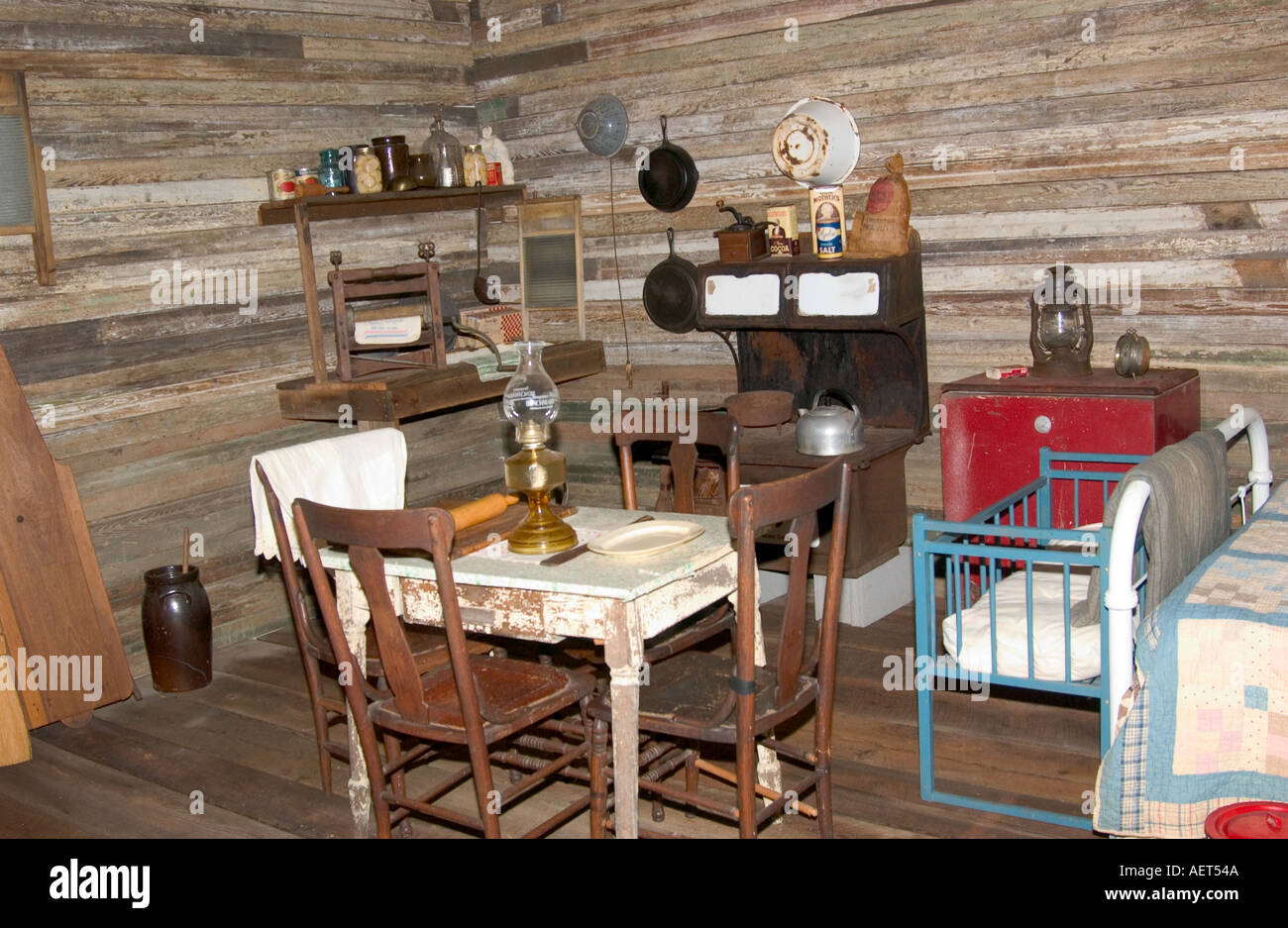 South Carolina Cotton Museum in Bishopville SC USA Stock Photohttps://www.alamy.com/image-license-details/?v=1https://www.alamy.com/south-carolina-cotton-museum-in-bishopville-sc-usa-image2557257.html
South Carolina Cotton Museum in Bishopville SC USA Stock Photohttps://www.alamy.com/image-license-details/?v=1https://www.alamy.com/south-carolina-cotton-museum-in-bishopville-sc-usa-image2557257.htmlRMAET54A–South Carolina Cotton Museum in Bishopville SC USA
 An old engraving of a warping mill (left), a winding machine (centre) and a power loom (right) used in producing cotton in the 1800s. It is from a Victorian mechanical engineering book of the 1880s. A loom is a device used to weave cloth. The basic purpose of any loom is to hold the warp threads under tension to facilitate the interweaving of the weft threads. Englishman Edmund Cartwright built and patented a power loom in 1785, and it was this that was adopted by cotton industry. Water and/or steam provided the power needed to run the looms, usually by belt drives to the individual looms. Stock Photohttps://www.alamy.com/image-license-details/?v=1https://www.alamy.com/an-old-engraving-of-a-warping-mill-left-a-winding-machine-centre-and-a-power-loom-right-used-in-producing-cotton-in-the-1800s-it-is-from-a-victorian-mechanical-engineering-book-of-the-1880s-a-loom-is-a-device-used-to-weave-cloth-the-basic-purpose-of-any-loom-is-to-hold-the-warp-threads-under-tension-to-facilitate-the-interweaving-of-the-weft-threads-englishman-edmund-cartwright-built-and-patented-a-power-loom-in-1785-and-it-was-this-that-was-adopted-by-cotton-industry-water-andor-steam-provided-the-power-needed-to-run-the-looms-usually-by-belt-drives-to-the-individual-looms-image559321655.html
An old engraving of a warping mill (left), a winding machine (centre) and a power loom (right) used in producing cotton in the 1800s. It is from a Victorian mechanical engineering book of the 1880s. A loom is a device used to weave cloth. The basic purpose of any loom is to hold the warp threads under tension to facilitate the interweaving of the weft threads. Englishman Edmund Cartwright built and patented a power loom in 1785, and it was this that was adopted by cotton industry. Water and/or steam provided the power needed to run the looms, usually by belt drives to the individual looms. Stock Photohttps://www.alamy.com/image-license-details/?v=1https://www.alamy.com/an-old-engraving-of-a-warping-mill-left-a-winding-machine-centre-and-a-power-loom-right-used-in-producing-cotton-in-the-1800s-it-is-from-a-victorian-mechanical-engineering-book-of-the-1880s-a-loom-is-a-device-used-to-weave-cloth-the-basic-purpose-of-any-loom-is-to-hold-the-warp-threads-under-tension-to-facilitate-the-interweaving-of-the-weft-threads-englishman-edmund-cartwright-built-and-patented-a-power-loom-in-1785-and-it-was-this-that-was-adopted-by-cotton-industry-water-andor-steam-provided-the-power-needed-to-run-the-looms-usually-by-belt-drives-to-the-individual-looms-image559321655.htmlRM2RDY8DB–An old engraving of a warping mill (left), a winding machine (centre) and a power loom (right) used in producing cotton in the 1800s. It is from a Victorian mechanical engineering book of the 1880s. A loom is a device used to weave cloth. The basic purpose of any loom is to hold the warp threads under tension to facilitate the interweaving of the weft threads. Englishman Edmund Cartwright built and patented a power loom in 1785, and it was this that was adopted by cotton industry. Water and/or steam provided the power needed to run the looms, usually by belt drives to the individual looms.
 Engraving of men working in the grinding room , circa 1880 Stock Photohttps://www.alamy.com/image-license-details/?v=1https://www.alamy.com/engraving-of-men-working-in-the-grinding-room-circa-1880-image544750937.html
Engraving of men working in the grinding room , circa 1880 Stock Photohttps://www.alamy.com/image-license-details/?v=1https://www.alamy.com/engraving-of-men-working-in-the-grinding-room-circa-1880-image544750937.htmlRM2PJ7FAH–Engraving of men working in the grinding room , circa 1880
 Engraving of a plain power loom from 1840 Stock Photohttps://www.alamy.com/image-license-details/?v=1https://www.alamy.com/engraving-of-a-plain-power-loom-from-1840-image454135672.html
Engraving of a plain power loom from 1840 Stock Photohttps://www.alamy.com/image-license-details/?v=1https://www.alamy.com/engraving-of-a-plain-power-loom-from-1840-image454135672.htmlRM2HARJK4–Engraving of a plain power loom from 1840
 Pomona Type Transformer from the Article THE WONDERFUL EXPANSION IN THE USE OF ELECTRIC POWER. By Louis Bell from The Engineering Magazine DEVOTED TO INDUSTRIAL PROGRESS Volume XII October 1896 to March 1897 The Engineering Magazine Co Stock Photohttps://www.alamy.com/image-license-details/?v=1https://www.alamy.com/pomona-type-transformer-from-the-article-the-wonderful-expansion-in-the-use-of-electric-power-by-louis-bell-from-the-engineering-magazine-devoted-to-industrial-progress-volume-xii-october-1896-to-march-1897-the-engineering-magazine-co-image572003784.html
Pomona Type Transformer from the Article THE WONDERFUL EXPANSION IN THE USE OF ELECTRIC POWER. By Louis Bell from The Engineering Magazine DEVOTED TO INDUSTRIAL PROGRESS Volume XII October 1896 to March 1897 The Engineering Magazine Co Stock Photohttps://www.alamy.com/image-license-details/?v=1https://www.alamy.com/pomona-type-transformer-from-the-article-the-wonderful-expansion-in-the-use-of-electric-power-by-louis-bell-from-the-engineering-magazine-devoted-to-industrial-progress-volume-xii-october-1896-to-march-1897-the-engineering-magazine-co-image572003784.htmlRF2T6H0JG–Pomona Type Transformer from the Article THE WONDERFUL EXPANSION IN THE USE OF ELECTRIC POWER. By Louis Bell from The Engineering Magazine DEVOTED TO INDUSTRIAL PROGRESS Volume XII October 1896 to March 1897 The Engineering Magazine Co
 Punching, beveling and chamfering machine for Montreal model barrels. Old 19th century engraving from La Nature 1887 Stock Photohttps://www.alamy.com/image-license-details/?v=1https://www.alamy.com/punching-beveling-and-chamfering-machine-for-montreal-model-barrels-old-19th-century-engraving-from-la-nature-1887-image550985958.html
Punching, beveling and chamfering machine for Montreal model barrels. Old 19th century engraving from La Nature 1887 Stock Photohttps://www.alamy.com/image-license-details/?v=1https://www.alamy.com/punching-beveling-and-chamfering-machine-for-montreal-model-barrels-old-19th-century-engraving-from-la-nature-1887-image550985958.htmlRM2R0BG5X–Punching, beveling and chamfering machine for Montreal model barrels. Old 19th century engraving from La Nature 1887
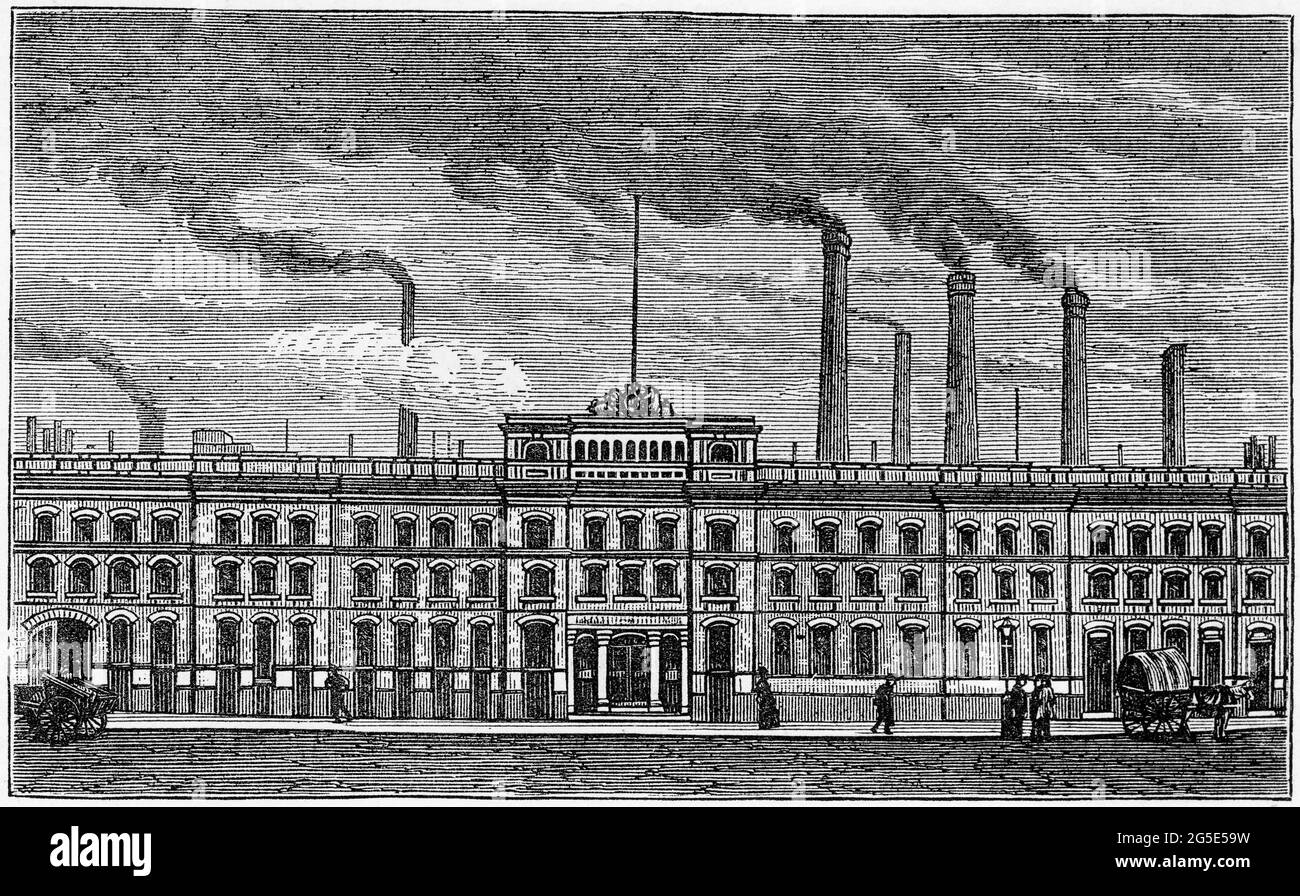 Engraving of the largest pin factory in the world, probably in Birmingham, England, circa 1880 Stock Photohttps://www.alamy.com/image-license-details/?v=1https://www.alamy.com/engraving-of-the-largest-pin-factory-in-the-world-probably-in-birmingham-england-circa-1880-image433644005.html
Engraving of the largest pin factory in the world, probably in Birmingham, England, circa 1880 Stock Photohttps://www.alamy.com/image-license-details/?v=1https://www.alamy.com/engraving-of-the-largest-pin-factory-in-the-world-probably-in-birmingham-england-circa-1880-image433644005.htmlRM2G5E59W–Engraving of the largest pin factory in the world, probably in Birmingham, England, circa 1880
 Rotary ozonator at the Compagnie de l'Ozone factory in Paris. Old 19th century engraved illustration from La Nature 1899 Stock Photohttps://www.alamy.com/image-license-details/?v=1https://www.alamy.com/rotary-ozonator-at-the-compagnie-de-lozone-factory-in-paris-old-19th-century-engraved-illustration-from-la-nature-1899-image464892664.html
Rotary ozonator at the Compagnie de l'Ozone factory in Paris. Old 19th century engraved illustration from La Nature 1899 Stock Photohttps://www.alamy.com/image-license-details/?v=1https://www.alamy.com/rotary-ozonator-at-the-compagnie-de-lozone-factory-in-paris-old-19th-century-engraved-illustration-from-la-nature-1899-image464892664.htmlRM2J09K9C–Rotary ozonator at the Compagnie de l'Ozone factory in Paris. Old 19th century engraved illustration from La Nature 1899
 Italy, Lombardy, Old Carding Wool Stock Photohttps://www.alamy.com/image-license-details/?v=1https://www.alamy.com/italy-lombardy-old-carding-wool-image608028396.html
Italy, Lombardy, Old Carding Wool Stock Photohttps://www.alamy.com/image-license-details/?v=1https://www.alamy.com/italy-lombardy-old-carding-wool-image608028396.htmlRM2X962BT–Italy, Lombardy, Old Carding Wool
 The most powerful electric dynamo machine in the world (400 electric horsepower, built by Mr. Brush. Old 19th century engraved illustration from La Nature 1886 Stock Photohttps://www.alamy.com/image-license-details/?v=1https://www.alamy.com/the-most-powerful-electric-dynamo-machine-in-the-world-400-electric-horsepower-built-by-mr-brush-old-19th-century-engraved-illustration-from-la-nature-1886-image610090744.html
The most powerful electric dynamo machine in the world (400 electric horsepower, built by Mr. Brush. Old 19th century engraved illustration from La Nature 1886 Stock Photohttps://www.alamy.com/image-license-details/?v=1https://www.alamy.com/the-most-powerful-electric-dynamo-machine-in-the-world-400-electric-horsepower-built-by-mr-brush-old-19th-century-engraved-illustration-from-la-nature-1886-image610090744.htmlRM2XCG0Y4–The most powerful electric dynamo machine in the world (400 electric horsepower, built by Mr. Brush. Old 19th century engraved illustration from La Nature 1886
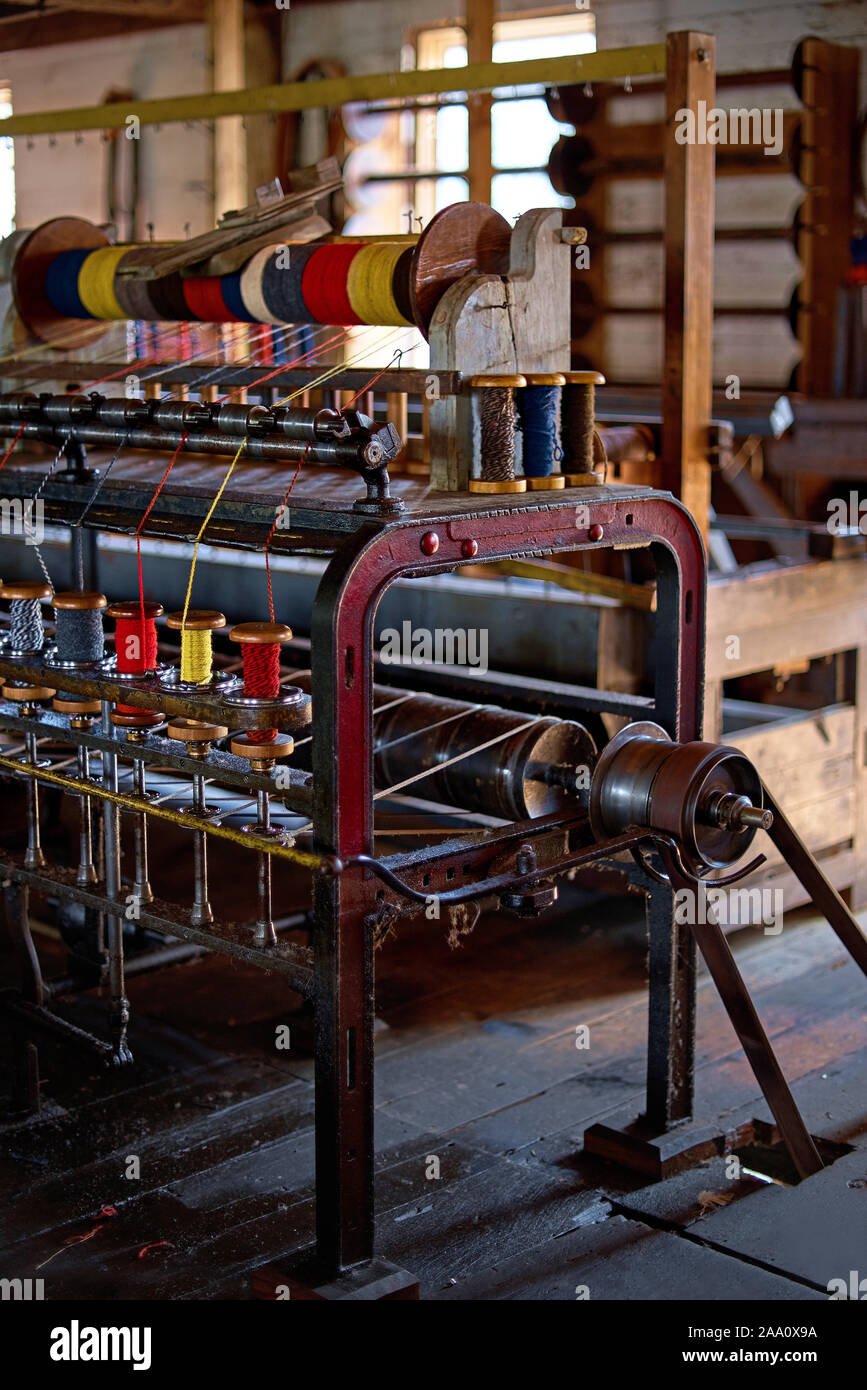 Spools of colored thread that were used in a woolen mill 1800's and early 1900's. colored woolen threads on an old loom, Traditional Yarn in Canada. Stock Photohttps://www.alamy.com/image-license-details/?v=1https://www.alamy.com/spools-of-colored-thread-that-were-used-in-a-woolen-mill-1800s-and-early-1900s-colored-woolen-threads-on-an-old-loom-traditional-yarn-in-canada-image333164198.html
Spools of colored thread that were used in a woolen mill 1800's and early 1900's. colored woolen threads on an old loom, Traditional Yarn in Canada. Stock Photohttps://www.alamy.com/image-license-details/?v=1https://www.alamy.com/spools-of-colored-thread-that-were-used-in-a-woolen-mill-1800s-and-early-1900s-colored-woolen-threads-on-an-old-loom-traditional-yarn-in-canada-image333164198.htmlRF2AA0X9A–Spools of colored thread that were used in a woolen mill 1800's and early 1900's. colored woolen threads on an old loom, Traditional Yarn in Canada.
 Crate nailing machines in the construction workshops of the Noisiel plant. Old 19th century engraving from La Nature 1887 Stock Photohttps://www.alamy.com/image-license-details/?v=1https://www.alamy.com/crate-nailing-machines-in-the-construction-workshops-of-the-noisiel-plant-old-19th-century-engraving-from-la-nature-1887-image554116681.html
Crate nailing machines in the construction workshops of the Noisiel plant. Old 19th century engraving from La Nature 1887 Stock Photohttps://www.alamy.com/image-license-details/?v=1https://www.alamy.com/crate-nailing-machines-in-the-construction-workshops-of-the-noisiel-plant-old-19th-century-engraving-from-la-nature-1887-image554116681.htmlRM2R5E5DD–Crate nailing machines in the construction workshops of the Noisiel plant. Old 19th century engraving from La Nature 1887
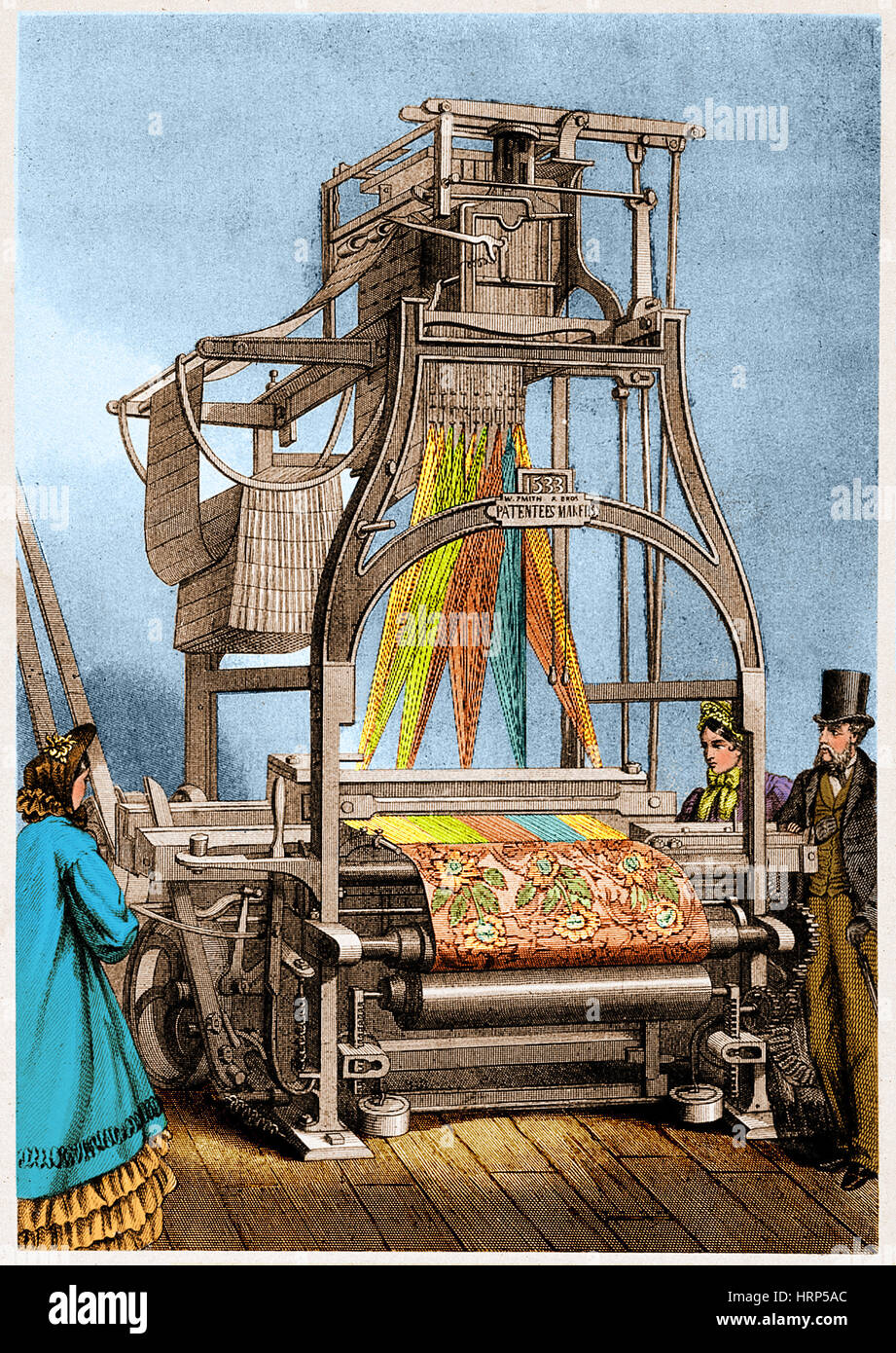 Jacquard Loom for Weaving Textiles Stock Photohttps://www.alamy.com/image-license-details/?v=1https://www.alamy.com/stock-photo-jacquard-loom-for-weaving-textiles-135096820.html
Jacquard Loom for Weaving Textiles Stock Photohttps://www.alamy.com/image-license-details/?v=1https://www.alamy.com/stock-photo-jacquard-loom-for-weaving-textiles-135096820.htmlRMHRP5AC–Jacquard Loom for Weaving Textiles
 Crate nailing machines in the construction workshops of the Noisiel plant. Old 19th century engraving from La Nature 1887 Stock Photohttps://www.alamy.com/image-license-details/?v=1https://www.alamy.com/crate-nailing-machines-in-the-construction-workshops-of-the-noisiel-plant-old-19th-century-engraving-from-la-nature-1887-image550985291.html
Crate nailing machines in the construction workshops of the Noisiel plant. Old 19th century engraving from La Nature 1887 Stock Photohttps://www.alamy.com/image-license-details/?v=1https://www.alamy.com/crate-nailing-machines-in-the-construction-workshops-of-the-noisiel-plant-old-19th-century-engraving-from-la-nature-1887-image550985291.htmlRM2R0BFA3–Crate nailing machines in the construction workshops of the Noisiel plant. Old 19th century engraving from La Nature 1887
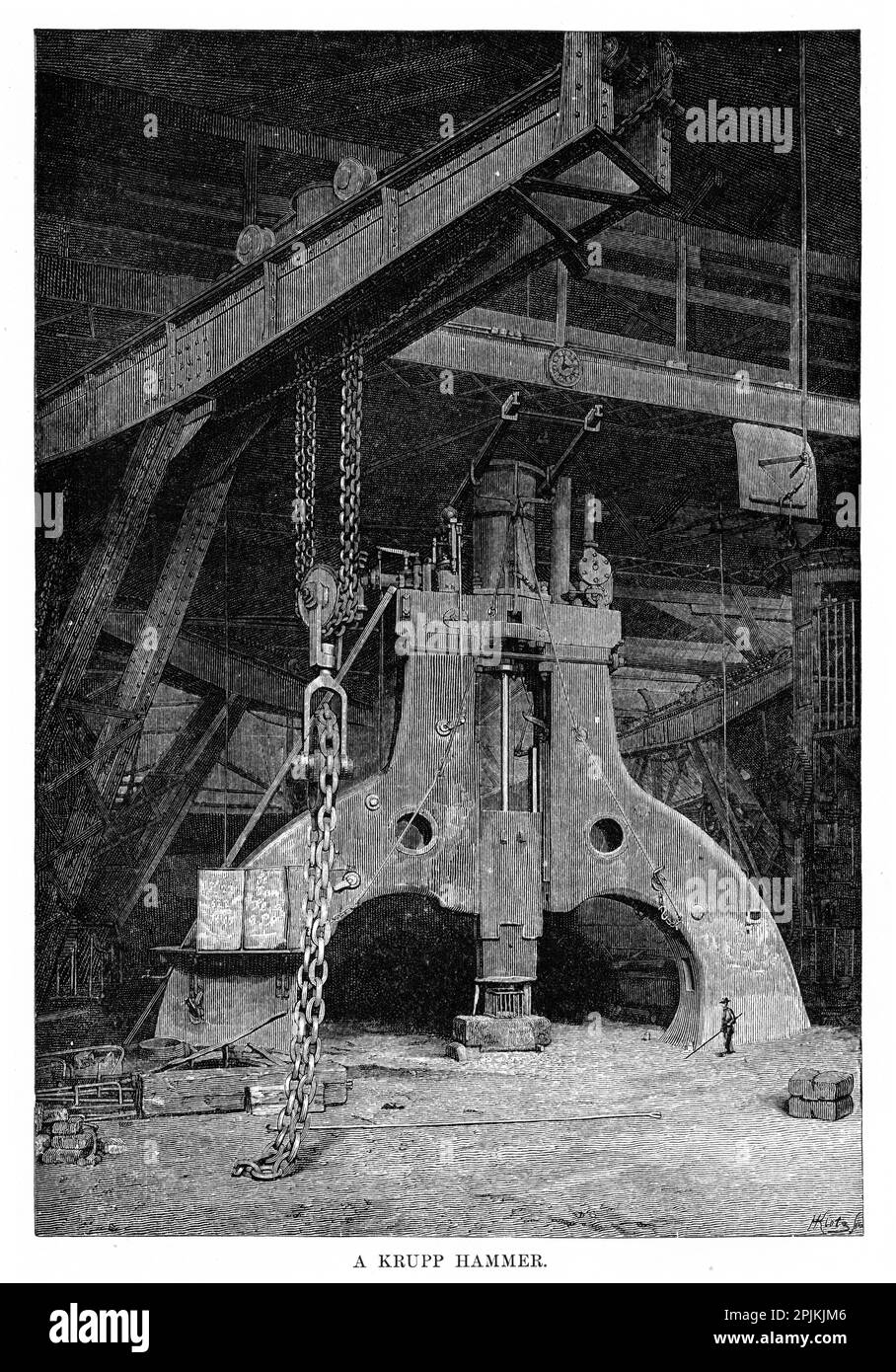 A Krupp Hammer, used for weapons manufacturing Stock Photohttps://www.alamy.com/image-license-details/?v=1https://www.alamy.com/a-krupp-hammer-used-for-weapons-manufacturing-image545016982.html
A Krupp Hammer, used for weapons manufacturing Stock Photohttps://www.alamy.com/image-license-details/?v=1https://www.alamy.com/a-krupp-hammer-used-for-weapons-manufacturing-image545016982.htmlRM2PJKJM6–A Krupp Hammer, used for weapons manufacturing
 Crate nailing machines in the construction workshops of the Noisiel plant. Old 19th century engraving from La Nature 1887 Stock Photohttps://www.alamy.com/image-license-details/?v=1https://www.alamy.com/crate-nailing-machines-in-the-construction-workshops-of-the-noisiel-plant-old-19th-century-engraving-from-la-nature-1887-image554116679.html
Crate nailing machines in the construction workshops of the Noisiel plant. Old 19th century engraving from La Nature 1887 Stock Photohttps://www.alamy.com/image-license-details/?v=1https://www.alamy.com/crate-nailing-machines-in-the-construction-workshops-of-the-noisiel-plant-old-19th-century-engraving-from-la-nature-1887-image554116679.htmlRM2R5E5DB–Crate nailing machines in the construction workshops of the Noisiel plant. Old 19th century engraving from La Nature 1887
 Engraving of a low-warp loom used by Aubusson and Beauvais Tapestry Manufacturers Stock Photohttps://www.alamy.com/image-license-details/?v=1https://www.alamy.com/engraving-of-a-low-warp-loom-used-by-aubusson-and-beauvais-tapestry-manufacturers-image454135509.html
Engraving of a low-warp loom used by Aubusson and Beauvais Tapestry Manufacturers Stock Photohttps://www.alamy.com/image-license-details/?v=1https://www.alamy.com/engraving-of-a-low-warp-loom-used-by-aubusson-and-beauvais-tapestry-manufacturers-image454135509.htmlRM2HARJD9–Engraving of a low-warp loom used by Aubusson and Beauvais Tapestry Manufacturers
 Distillation of Coal Gas. New Stedman-Stanley furnace for coal distillation. Old 19th century engraved illustration from La Nature 1886 Stock Photohttps://www.alamy.com/image-license-details/?v=1https://www.alamy.com/distillation-of-coal-gas-new-stedman-stanley-furnace-for-coal-distillation-old-19th-century-engraved-illustration-from-la-nature-1886-image612341460.html
Distillation of Coal Gas. New Stedman-Stanley furnace for coal distillation. Old 19th century engraved illustration from La Nature 1886 Stock Photohttps://www.alamy.com/image-license-details/?v=1https://www.alamy.com/distillation-of-coal-gas-new-stedman-stanley-furnace-for-coal-distillation-old-19th-century-engraved-illustration-from-la-nature-1886-image612341460.htmlRM2XG6FNT–Distillation of Coal Gas. New Stedman-Stanley furnace for coal distillation. Old 19th century engraved illustration from La Nature 1886
 Stained Glass Window, The Old Furniture Factory, Art Music and Community Center, 6 West Loudoun Street, Round Hill, VA Stock Photohttps://www.alamy.com/image-license-details/?v=1https://www.alamy.com/stock-photo-stained-glass-window-the-old-furniture-factory-art-music-and-community-113662812.html
Stained Glass Window, The Old Furniture Factory, Art Music and Community Center, 6 West Loudoun Street, Round Hill, VA Stock Photohttps://www.alamy.com/image-license-details/?v=1https://www.alamy.com/stock-photo-stained-glass-window-the-old-furniture-factory-art-music-and-community-113662812.htmlRMGGWP24–Stained Glass Window, The Old Furniture Factory, Art Music and Community Center, 6 West Loudoun Street, Round Hill, VA
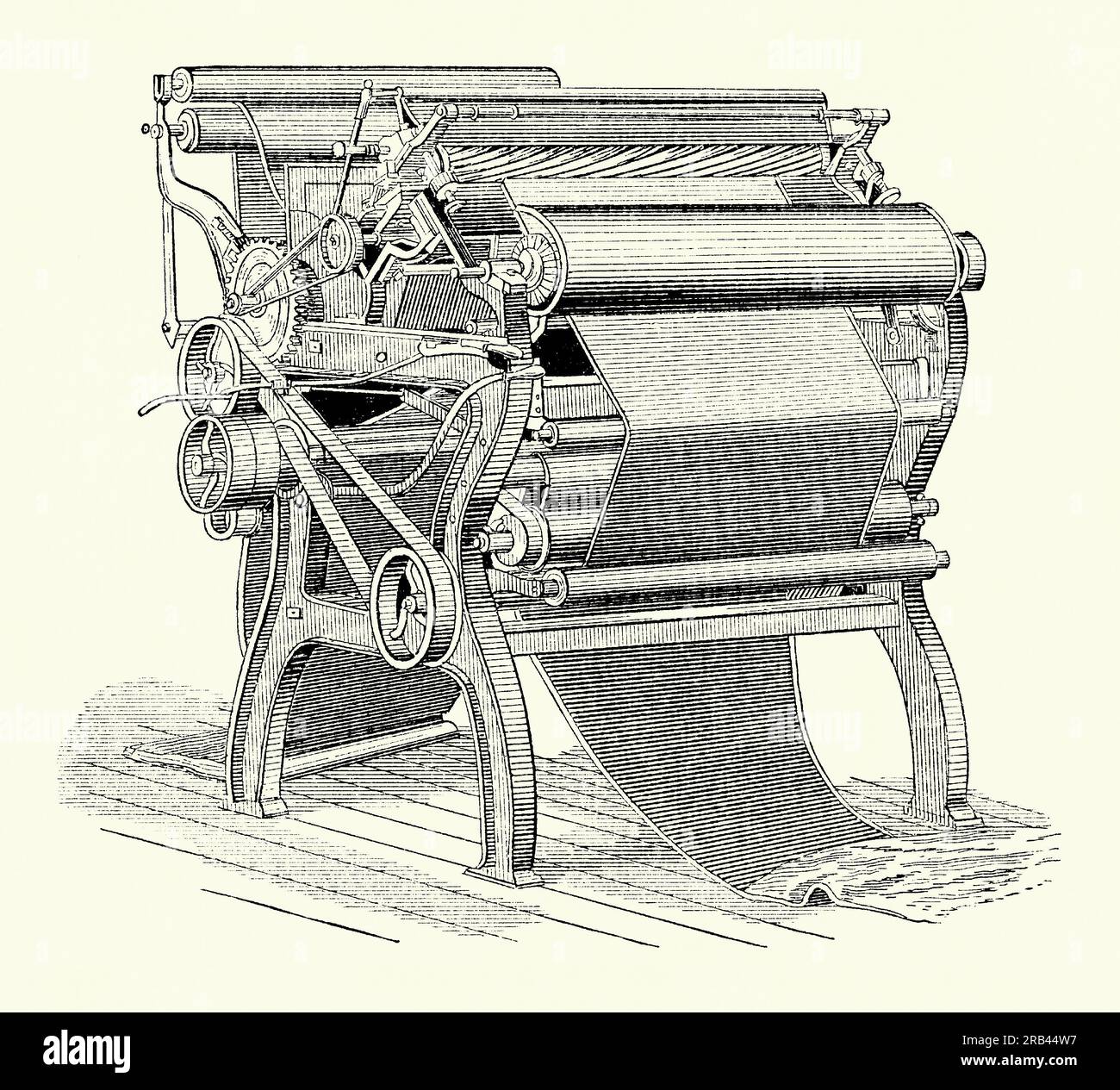 An old engraving of a shearing machine used in the textile mills of the 1800s. It is from a Victorian mechanical engineering book of the 1880s. Shearing where the fabric is enhanced by cutting the loops or raised surface pile to a uniform height. This machine usually has a rotating spiral cylinder blade similar to a lawn mower – the raw cloth is fed into the belt-driven shearer (right). Shearing was most commonly used to make woollen, worsted, moleskin and velvet fabrics. Often called gigging, napping or cropping, a smooth feel was produced by a gradual lowering of the nap (‘dry shearing’). Stock Photohttps://www.alamy.com/image-license-details/?v=1https://www.alamy.com/an-old-engraving-of-a-shearing-machine-used-in-the-textile-mills-of-the-1800s-it-is-from-a-victorian-mechanical-engineering-book-of-the-1880s-shearing-where-the-fabric-is-enhanced-by-cutting-the-loops-or-raised-surface-pile-to-a-uniform-height-this-machine-usually-has-a-rotating-spiral-cylinder-blade-similar-to-a-lawn-mower-the-raw-cloth-is-fed-into-the-belt-driven-shearer-right-shearing-was-most-commonly-used-to-make-woollen-worsted-moleskin-and-velvet-fabrics-often-called-gigging-napping-or-cropping-a-smooth-feel-was-produced-by-a-gradual-lowering-of-the-nap-dry-shearing-image557584643.html
An old engraving of a shearing machine used in the textile mills of the 1800s. It is from a Victorian mechanical engineering book of the 1880s. Shearing where the fabric is enhanced by cutting the loops or raised surface pile to a uniform height. This machine usually has a rotating spiral cylinder blade similar to a lawn mower – the raw cloth is fed into the belt-driven shearer (right). Shearing was most commonly used to make woollen, worsted, moleskin and velvet fabrics. Often called gigging, napping or cropping, a smooth feel was produced by a gradual lowering of the nap (‘dry shearing’). Stock Photohttps://www.alamy.com/image-license-details/?v=1https://www.alamy.com/an-old-engraving-of-a-shearing-machine-used-in-the-textile-mills-of-the-1800s-it-is-from-a-victorian-mechanical-engineering-book-of-the-1880s-shearing-where-the-fabric-is-enhanced-by-cutting-the-loops-or-raised-surface-pile-to-a-uniform-height-this-machine-usually-has-a-rotating-spiral-cylinder-blade-similar-to-a-lawn-mower-the-raw-cloth-is-fed-into-the-belt-driven-shearer-right-shearing-was-most-commonly-used-to-make-woollen-worsted-moleskin-and-velvet-fabrics-often-called-gigging-napping-or-cropping-a-smooth-feel-was-produced-by-a-gradual-lowering-of-the-nap-dry-shearing-image557584643.htmlRM2RB44W7–An old engraving of a shearing machine used in the textile mills of the 1800s. It is from a Victorian mechanical engineering book of the 1880s. Shearing where the fabric is enhanced by cutting the loops or raised surface pile to a uniform height. This machine usually has a rotating spiral cylinder blade similar to a lawn mower – the raw cloth is fed into the belt-driven shearer (right). Shearing was most commonly used to make woollen, worsted, moleskin and velvet fabrics. Often called gigging, napping or cropping, a smooth feel was produced by a gradual lowering of the nap (‘dry shearing’).
 The great universal lathe of Mulhouse Mechanism of control of the doll and the bench. Old illustration by Louis Poyet (1846-1913) from La Nature 1887 Stock Photohttps://www.alamy.com/image-license-details/?v=1https://www.alamy.com/the-great-universal-lathe-of-mulhouse-mechanism-of-control-of-the-doll-and-the-bench-old-illustration-by-louis-poyet-1846-1913-from-la-nature-1887-image574178556.html
The great universal lathe of Mulhouse Mechanism of control of the doll and the bench. Old illustration by Louis Poyet (1846-1913) from La Nature 1887 Stock Photohttps://www.alamy.com/image-license-details/?v=1https://www.alamy.com/the-great-universal-lathe-of-mulhouse-mechanism-of-control-of-the-doll-and-the-bench-old-illustration-by-louis-poyet-1846-1913-from-la-nature-1887-image574178556.htmlRM2TA42H0–The great universal lathe of Mulhouse Mechanism of control of the doll and the bench. Old illustration by Louis Poyet (1846-1913) from La Nature 1887
 An old engraving of a giant, hand-powered, wooden foundry crane in the 1800s. It is from a Victorian mechanical engineering book of the 1880s. A crane is a type of machine, generally used a hoist rope, wire ropes or chains, that can be used both to lift and lower materials and also to move them horizontally. The earliest cranes were made from wood, but cast iron, iron and steel took over – as did mechanical power, first provided by steam engines. Sizes of these jib (or post and jib) cranes vary enormously – here this large machine is used to move big sheets of iron or steel. Stock Photohttps://www.alamy.com/image-license-details/?v=1https://www.alamy.com/an-old-engraving-of-a-giant-hand-powered-wooden-foundry-crane-in-the-1800s-it-is-from-a-victorian-mechanical-engineering-book-of-the-1880s-a-crane-is-a-type-of-machine-generally-used-a-hoist-rope-wire-ropes-or-chains-that-can-be-used-both-to-lift-and-lower-materials-and-also-to-move-them-horizontally-the-earliest-cranes-were-made-from-wood-but-cast-iron-iron-and-steel-took-over-as-did-mechanical-power-first-provided-by-steam-engines-sizes-of-these-jib-or-post-and-jib-cranes-vary-enormously-here-this-large-machine-is-used-to-move-big-sheets-of-iron-or-steel-image384407334.html
An old engraving of a giant, hand-powered, wooden foundry crane in the 1800s. It is from a Victorian mechanical engineering book of the 1880s. A crane is a type of machine, generally used a hoist rope, wire ropes or chains, that can be used both to lift and lower materials and also to move them horizontally. The earliest cranes were made from wood, but cast iron, iron and steel took over – as did mechanical power, first provided by steam engines. Sizes of these jib (or post and jib) cranes vary enormously – here this large machine is used to move big sheets of iron or steel. Stock Photohttps://www.alamy.com/image-license-details/?v=1https://www.alamy.com/an-old-engraving-of-a-giant-hand-powered-wooden-foundry-crane-in-the-1800s-it-is-from-a-victorian-mechanical-engineering-book-of-the-1880s-a-crane-is-a-type-of-machine-generally-used-a-hoist-rope-wire-ropes-or-chains-that-can-be-used-both-to-lift-and-lower-materials-and-also-to-move-them-horizontally-the-earliest-cranes-were-made-from-wood-but-cast-iron-iron-and-steel-took-over-as-did-mechanical-power-first-provided-by-steam-engines-sizes-of-these-jib-or-post-and-jib-cranes-vary-enormously-here-this-large-machine-is-used-to-move-big-sheets-of-iron-or-steel-image384407334.htmlRM2D9B7DA–An old engraving of a giant, hand-powered, wooden foundry crane in the 1800s. It is from a Victorian mechanical engineering book of the 1880s. A crane is a type of machine, generally used a hoist rope, wire ropes or chains, that can be used both to lift and lower materials and also to move them horizontally. The earliest cranes were made from wood, but cast iron, iron and steel took over – as did mechanical power, first provided by steam engines. Sizes of these jib (or post and jib) cranes vary enormously – here this large machine is used to move big sheets of iron or steel.
 An old engraving of a woman a working at a paper folding machine used in the printing industry. It is from a Victorian mechanical engineering book of the 1880s. This ‘knife folder’ is a machine would be used for ‘octavo’ work (16 pages from the single sheet printed on both sides). With the paper sheet held in place on the table by two registration pins, the ‘folder’ (the dull blade in front of the operator) pushes down on the paper until it engages with two rollers which create the fold. It is then collected below the machine. Until the mid-1800s, book and newspaper folding was done by hand. Stock Photohttps://www.alamy.com/image-license-details/?v=1https://www.alamy.com/an-old-engraving-of-a-woman-a-working-at-a-paper-folding-machine-used-in-the-printing-industry-it-is-from-a-victorian-mechanical-engineering-book-of-the-1880s-this-knife-folder-is-a-machine-would-be-used-for-octavo-work-16-pages-from-the-single-sheet-printed-on-both-sides-with-the-paper-sheet-held-in-place-on-the-table-by-two-registration-pins-the-folder-the-dull-blade-in-front-of-the-operator-pushes-down-on-the-paper-until-it-engages-with-two-rollers-which-create-the-fold-it-is-then-collected-below-the-machine-until-the-mid-1800s-book-and-newspaper-folding-was-done-by-hand-image385090712.html
An old engraving of a woman a working at a paper folding machine used in the printing industry. It is from a Victorian mechanical engineering book of the 1880s. This ‘knife folder’ is a machine would be used for ‘octavo’ work (16 pages from the single sheet printed on both sides). With the paper sheet held in place on the table by two registration pins, the ‘folder’ (the dull blade in front of the operator) pushes down on the paper until it engages with two rollers which create the fold. It is then collected below the machine. Until the mid-1800s, book and newspaper folding was done by hand. Stock Photohttps://www.alamy.com/image-license-details/?v=1https://www.alamy.com/an-old-engraving-of-a-woman-a-working-at-a-paper-folding-machine-used-in-the-printing-industry-it-is-from-a-victorian-mechanical-engineering-book-of-the-1880s-this-knife-folder-is-a-machine-would-be-used-for-octavo-work-16-pages-from-the-single-sheet-printed-on-both-sides-with-the-paper-sheet-held-in-place-on-the-table-by-two-registration-pins-the-folder-the-dull-blade-in-front-of-the-operator-pushes-down-on-the-paper-until-it-engages-with-two-rollers-which-create-the-fold-it-is-then-collected-below-the-machine-until-the-mid-1800s-book-and-newspaper-folding-was-done-by-hand-image385090712.htmlRM2DAEB3M–An old engraving of a woman a working at a paper folding machine used in the printing industry. It is from a Victorian mechanical engineering book of the 1880s. This ‘knife folder’ is a machine would be used for ‘octavo’ work (16 pages from the single sheet printed on both sides). With the paper sheet held in place on the table by two registration pins, the ‘folder’ (the dull blade in front of the operator) pushes down on the paper until it engages with two rollers which create the fold. It is then collected below the machine. Until the mid-1800s, book and newspaper folding was done by hand.
 ONE OF THE FIRST COMMERCIAL ELECTRIC MOTORS from the Article THE WONDERFUL EXPANSION IN THE USE OF ELECTRIC POWER. By Louis Bell from The Engineering Magazine DEVOTED TO INDUSTRIAL PROGRESS Volume XII October 1896 to March 1897 The Engineering Magazine Co Stock Photohttps://www.alamy.com/image-license-details/?v=1https://www.alamy.com/one-of-the-first-commercial-electric-motors-from-the-article-the-wonderful-expansion-in-the-use-of-electric-power-by-louis-bell-from-the-engineering-magazine-devoted-to-industrial-progress-volume-xii-october-1896-to-march-1897-the-engineering-magazine-co-image572003768.html
ONE OF THE FIRST COMMERCIAL ELECTRIC MOTORS from the Article THE WONDERFUL EXPANSION IN THE USE OF ELECTRIC POWER. By Louis Bell from The Engineering Magazine DEVOTED TO INDUSTRIAL PROGRESS Volume XII October 1896 to March 1897 The Engineering Magazine Co Stock Photohttps://www.alamy.com/image-license-details/?v=1https://www.alamy.com/one-of-the-first-commercial-electric-motors-from-the-article-the-wonderful-expansion-in-the-use-of-electric-power-by-louis-bell-from-the-engineering-magazine-devoted-to-industrial-progress-volume-xii-october-1896-to-march-1897-the-engineering-magazine-co-image572003768.htmlRF2T6H0J0–ONE OF THE FIRST COMMERCIAL ELECTRIC MOTORS from the Article THE WONDERFUL EXPANSION IN THE USE OF ELECTRIC POWER. By Louis Bell from The Engineering Magazine DEVOTED TO INDUSTRIAL PROGRESS Volume XII October 1896 to March 1897 The Engineering Magazine Co
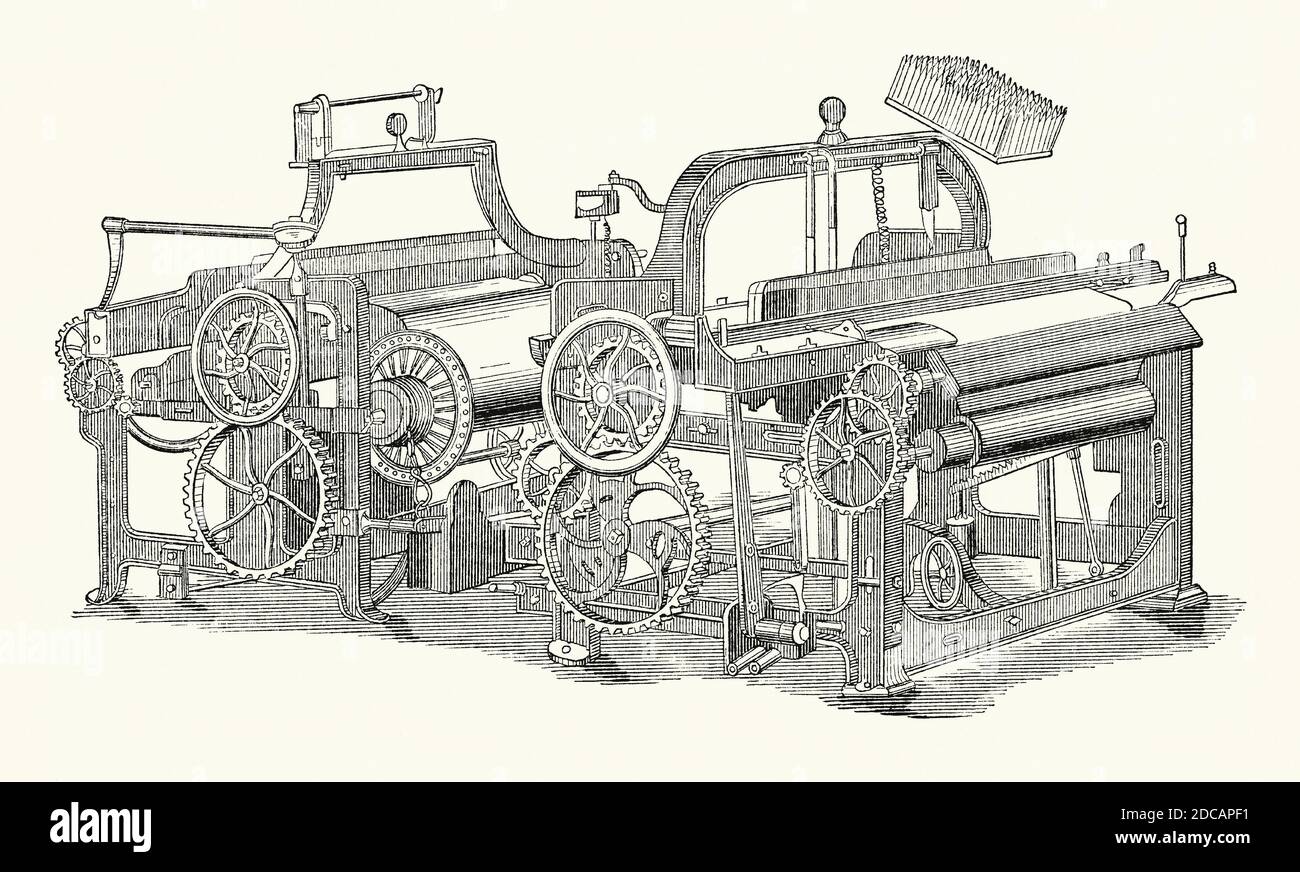 An old engraving of a cotton loom (left) and a linen loom (right). It is from a Victorian mechanical engineering book of the 1880s. A loom is a device used to weave cloth. The basic purpose of any loom is to hold the warp threads under tension to facilitate the interweaving of the weft threads. Englishman Edmund Cartwright built and patented a power loom in 1785, and it was this that was adopted by cotton industry. Water and/or steam provided the power needed to run the looms, usually by belt drives to the individual looms. The loom shape and its mechanics varied enormously. Stock Photohttps://www.alamy.com/image-license-details/?v=1https://www.alamy.com/an-old-engraving-of-a-cotton-loom-left-and-a-linen-loom-right-it-is-from-a-victorian-mechanical-engineering-book-of-the-1880s-a-loom-is-a-device-used-to-weave-cloth-the-basic-purpose-of-any-loom-is-to-hold-the-warp-threads-under-tension-to-facilitate-the-interweaving-of-the-weft-threads-englishman-edmund-cartwright-built-and-patented-a-power-loom-in-1785-and-it-was-this-that-was-adopted-by-cotton-industry-water-andor-steam-provided-the-power-needed-to-run-the-looms-usually-by-belt-drives-to-the-individual-looms-the-loom-shape-and-its-mechanics-varied-enormously-image386241157.html
An old engraving of a cotton loom (left) and a linen loom (right). It is from a Victorian mechanical engineering book of the 1880s. A loom is a device used to weave cloth. The basic purpose of any loom is to hold the warp threads under tension to facilitate the interweaving of the weft threads. Englishman Edmund Cartwright built and patented a power loom in 1785, and it was this that was adopted by cotton industry. Water and/or steam provided the power needed to run the looms, usually by belt drives to the individual looms. The loom shape and its mechanics varied enormously. Stock Photohttps://www.alamy.com/image-license-details/?v=1https://www.alamy.com/an-old-engraving-of-a-cotton-loom-left-and-a-linen-loom-right-it-is-from-a-victorian-mechanical-engineering-book-of-the-1880s-a-loom-is-a-device-used-to-weave-cloth-the-basic-purpose-of-any-loom-is-to-hold-the-warp-threads-under-tension-to-facilitate-the-interweaving-of-the-weft-threads-englishman-edmund-cartwright-built-and-patented-a-power-loom-in-1785-and-it-was-this-that-was-adopted-by-cotton-industry-water-andor-steam-provided-the-power-needed-to-run-the-looms-usually-by-belt-drives-to-the-individual-looms-the-loom-shape-and-its-mechanics-varied-enormously-image386241157.htmlRM2DCAPF1–An old engraving of a cotton loom (left) and a linen loom (right). It is from a Victorian mechanical engineering book of the 1880s. A loom is a device used to weave cloth. The basic purpose of any loom is to hold the warp threads under tension to facilitate the interweaving of the weft threads. Englishman Edmund Cartwright built and patented a power loom in 1785, and it was this that was adopted by cotton industry. Water and/or steam provided the power needed to run the looms, usually by belt drives to the individual looms. The loom shape and its mechanics varied enormously.
 Italy, Lombardy, Old Carding Wool Stock Photohttps://www.alamy.com/image-license-details/?v=1https://www.alamy.com/italy-lombardy-old-carding-wool-image608028391.html
Italy, Lombardy, Old Carding Wool Stock Photohttps://www.alamy.com/image-license-details/?v=1https://www.alamy.com/italy-lombardy-old-carding-wool-image608028391.htmlRM2X962BK–Italy, Lombardy, Old Carding Wool
 Spools of colored thread that were used in a woolen mill 1800's and early 1900's. colored woolen threads on an old loom, Traditional Yarn in Canada. Stock Photohttps://www.alamy.com/image-license-details/?v=1https://www.alamy.com/spools-of-colored-thread-that-were-used-in-a-woolen-mill-1800s-and-early-1900s-colored-woolen-threads-on-an-old-loom-traditional-yarn-in-canada-image333164139.html
Spools of colored thread that were used in a woolen mill 1800's and early 1900's. colored woolen threads on an old loom, Traditional Yarn in Canada. Stock Photohttps://www.alamy.com/image-license-details/?v=1https://www.alamy.com/spools-of-colored-thread-that-were-used-in-a-woolen-mill-1800s-and-early-1900s-colored-woolen-threads-on-an-old-loom-traditional-yarn-in-canada-image333164139.htmlRF2AA0X77–Spools of colored thread that were used in a woolen mill 1800's and early 1900's. colored woolen threads on an old loom, Traditional Yarn in Canada.
 Stained Glass Window, The Old Furniture Factory, Art Music and Community Center, 6 West Loudoun Street, Round Hill, VA Stock Photohttps://www.alamy.com/image-license-details/?v=1https://www.alamy.com/stock-photo-stained-glass-window-the-old-furniture-factory-art-music-and-community-113662813.html
Stained Glass Window, The Old Furniture Factory, Art Music and Community Center, 6 West Loudoun Street, Round Hill, VA Stock Photohttps://www.alamy.com/image-license-details/?v=1https://www.alamy.com/stock-photo-stained-glass-window-the-old-furniture-factory-art-music-and-community-113662813.htmlRMGGWP25–Stained Glass Window, The Old Furniture Factory, Art Music and Community Center, 6 West Loudoun Street, Round Hill, VA
 The great universal lathe of Mulhouse Mechanism of control of the doll and the bench. Old illustration by Louis Poyet (1846-1913) from La Nature 1887 Stock Photohttps://www.alamy.com/image-license-details/?v=1https://www.alamy.com/the-great-universal-lathe-of-mulhouse-mechanism-of-control-of-the-doll-and-the-bench-old-illustration-by-louis-poyet-1846-1913-from-la-nature-1887-image574178553.html
The great universal lathe of Mulhouse Mechanism of control of the doll and the bench. Old illustration by Louis Poyet (1846-1913) from La Nature 1887 Stock Photohttps://www.alamy.com/image-license-details/?v=1https://www.alamy.com/the-great-universal-lathe-of-mulhouse-mechanism-of-control-of-the-doll-and-the-bench-old-illustration-by-louis-poyet-1846-1913-from-la-nature-1887-image574178553.htmlRM2TA42GW–The great universal lathe of Mulhouse Mechanism of control of the doll and the bench. Old illustration by Louis Poyet (1846-1913) from La Nature 1887
 Installation of circular plansifters for screening. Old 19th century engraved illustration from La Nature 1897 Stock Photohttps://www.alamy.com/image-license-details/?v=1https://www.alamy.com/installation-of-circular-plansifters-for-screening-old-19th-century-engraved-illustration-from-la-nature-1897-image451452254.html
Installation of circular plansifters for screening. Old 19th century engraved illustration from La Nature 1897 Stock Photohttps://www.alamy.com/image-license-details/?v=1https://www.alamy.com/installation-of-circular-plansifters-for-screening-old-19th-century-engraved-illustration-from-la-nature-1897-image451452254.htmlRM2H6DBXP–Installation of circular plansifters for screening. Old 19th century engraved illustration from La Nature 1897
 THE MIESBACH POWER STATION from the Article THE WONDERFUL EXPANSION IN THE USE OF ELECTRIC POWER. By Louis Bell from The Engineering Magazine DEVOTED TO INDUSTRIAL PROGRESS Volume XII October 1896 to March 1897 The Engineering Magazine Co Stock Photohttps://www.alamy.com/image-license-details/?v=1https://www.alamy.com/the-miesbach-power-station-from-the-article-the-wonderful-expansion-in-the-use-of-electric-power-by-louis-bell-from-the-engineering-magazine-devoted-to-industrial-progress-volume-xii-october-1896-to-march-1897-the-engineering-magazine-co-image572003772.html
THE MIESBACH POWER STATION from the Article THE WONDERFUL EXPANSION IN THE USE OF ELECTRIC POWER. By Louis Bell from The Engineering Magazine DEVOTED TO INDUSTRIAL PROGRESS Volume XII October 1896 to March 1897 The Engineering Magazine Co Stock Photohttps://www.alamy.com/image-license-details/?v=1https://www.alamy.com/the-miesbach-power-station-from-the-article-the-wonderful-expansion-in-the-use-of-electric-power-by-louis-bell-from-the-engineering-magazine-devoted-to-industrial-progress-volume-xii-october-1896-to-march-1897-the-engineering-magazine-co-image572003772.htmlRF2T6H0J4–THE MIESBACH POWER STATION from the Article THE WONDERFUL EXPANSION IN THE USE OF ELECTRIC POWER. By Louis Bell from The Engineering Magazine DEVOTED TO INDUSTRIAL PROGRESS Volume XII October 1896 to March 1897 The Engineering Magazine Co
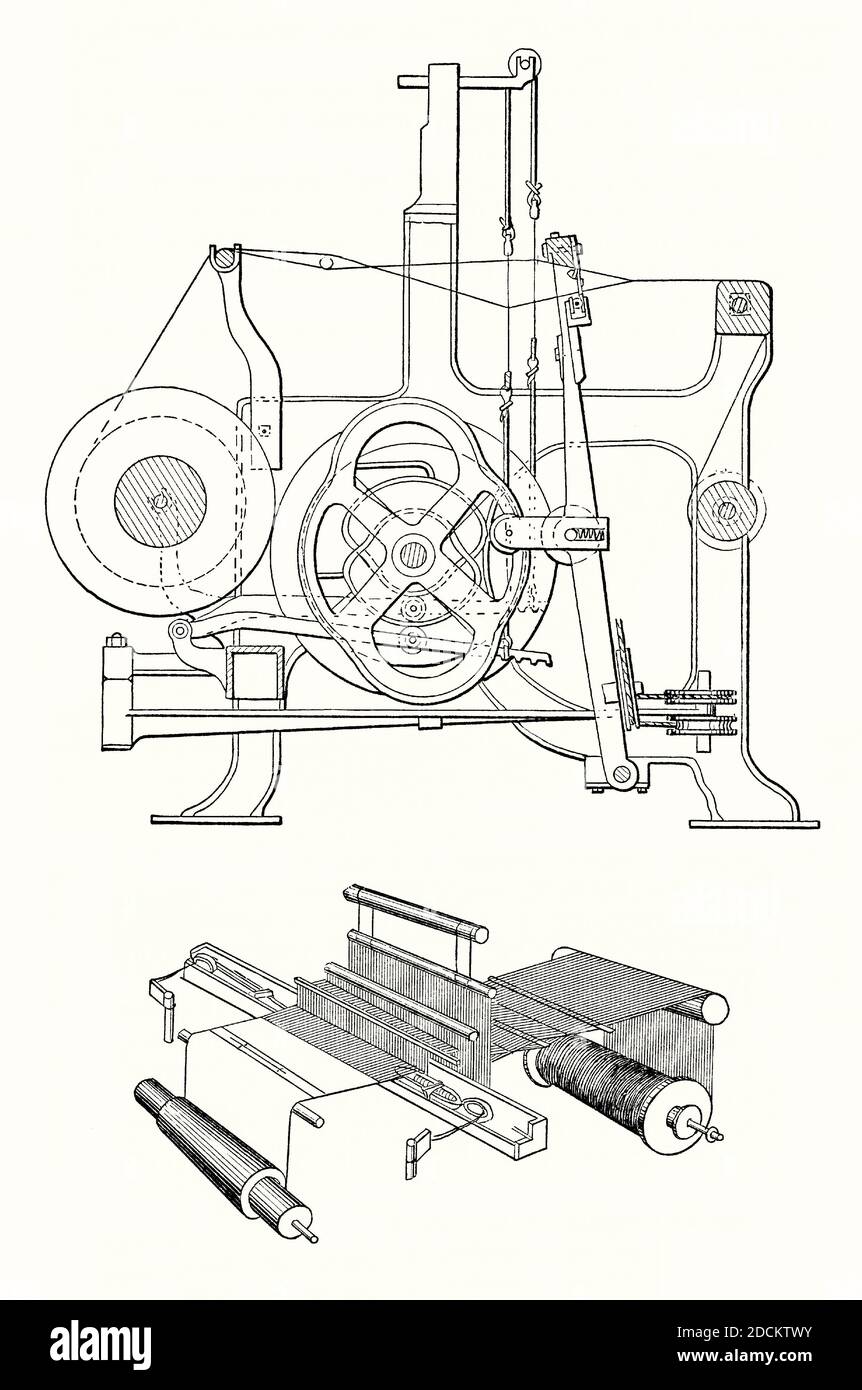 An old engraving of two views of the workings of a power loom. It is from a Victorian mechanical engineering book of the 1880s. A loom is a device used to weave cloth. The basic purpose of any loom is to hold the warp threads under tension to facilitate the interweaving of the weft threads. Englishman Edmund Cartwright built and patented a power loom in 1785, and it was this that was adopted by cotton industry. Water and/or steam provided the power needed to run the looms, usually by belt drives to the individual looms. The loom shape and its mechanics varied enormously Stock Photohttps://www.alamy.com/image-license-details/?v=1https://www.alamy.com/an-old-engraving-of-two-views-of-the-workings-of-a-power-loom-it-is-from-a-victorian-mechanical-engineering-book-of-the-1880s-a-loom-is-a-device-used-to-weave-cloth-the-basic-purpose-of-any-loom-is-to-hold-the-warp-threads-under-tension-to-facilitate-the-interweaving-of-the-weft-threads-englishman-edmund-cartwright-built-and-patented-a-power-loom-in-1785-and-it-was-this-that-was-adopted-by-cotton-industry-water-andor-steam-provided-the-power-needed-to-run-the-looms-usually-by-belt-drives-to-the-individual-looms-the-loom-shape-and-its-mechanics-varied-enormously-image386440599.html
An old engraving of two views of the workings of a power loom. It is from a Victorian mechanical engineering book of the 1880s. A loom is a device used to weave cloth. The basic purpose of any loom is to hold the warp threads under tension to facilitate the interweaving of the weft threads. Englishman Edmund Cartwright built and patented a power loom in 1785, and it was this that was adopted by cotton industry. Water and/or steam provided the power needed to run the looms, usually by belt drives to the individual looms. The loom shape and its mechanics varied enormously Stock Photohttps://www.alamy.com/image-license-details/?v=1https://www.alamy.com/an-old-engraving-of-two-views-of-the-workings-of-a-power-loom-it-is-from-a-victorian-mechanical-engineering-book-of-the-1880s-a-loom-is-a-device-used-to-weave-cloth-the-basic-purpose-of-any-loom-is-to-hold-the-warp-threads-under-tension-to-facilitate-the-interweaving-of-the-weft-threads-englishman-edmund-cartwright-built-and-patented-a-power-loom-in-1785-and-it-was-this-that-was-adopted-by-cotton-industry-water-andor-steam-provided-the-power-needed-to-run-the-looms-usually-by-belt-drives-to-the-individual-looms-the-loom-shape-and-its-mechanics-varied-enormously-image386440599.htmlRM2DCKTWY–An old engraving of two views of the workings of a power loom. It is from a Victorian mechanical engineering book of the 1880s. A loom is a device used to weave cloth. The basic purpose of any loom is to hold the warp threads under tension to facilitate the interweaving of the weft threads. Englishman Edmund Cartwright built and patented a power loom in 1785, and it was this that was adopted by cotton industry. Water and/or steam provided the power needed to run the looms, usually by belt drives to the individual looms. The loom shape and its mechanics varied enormously